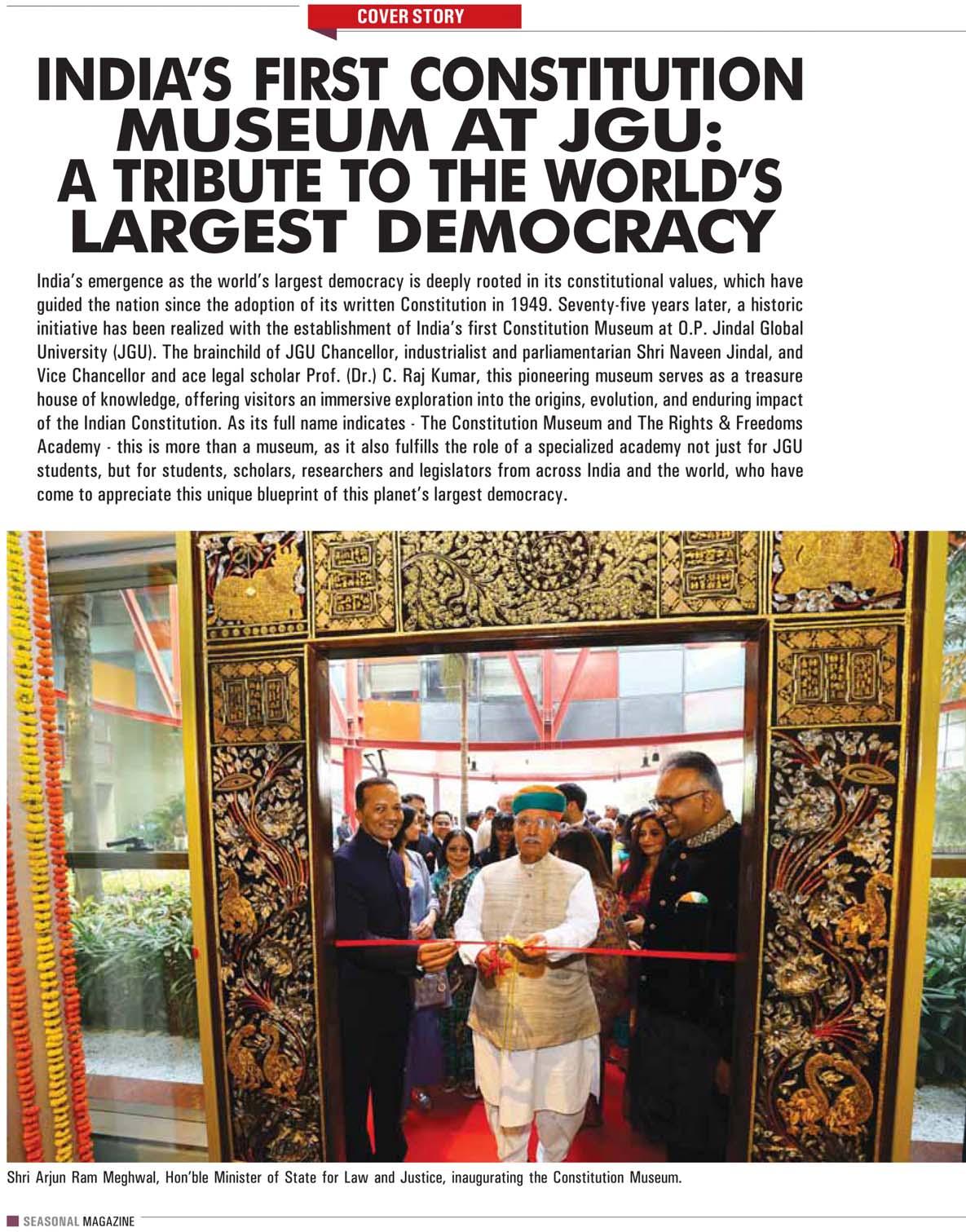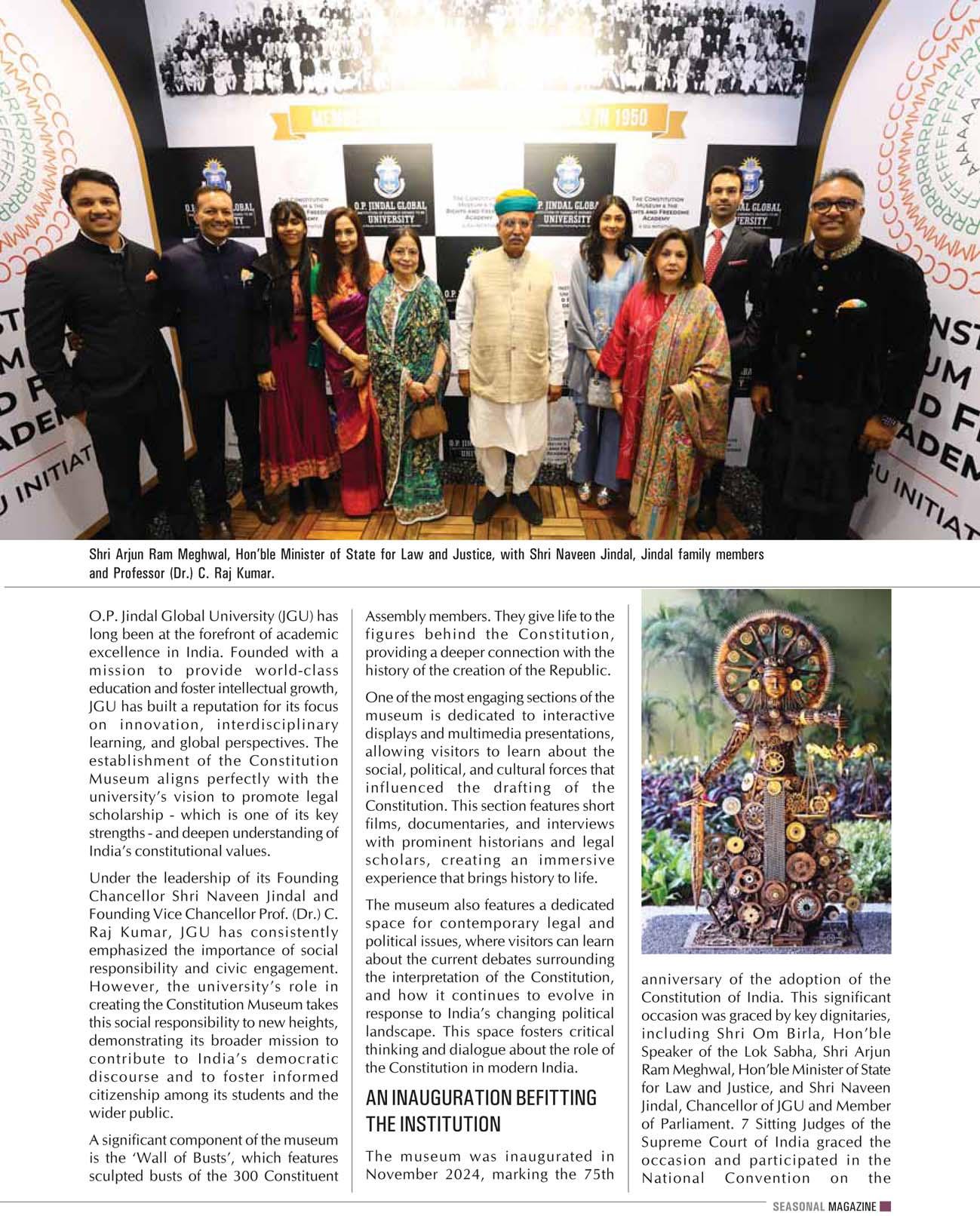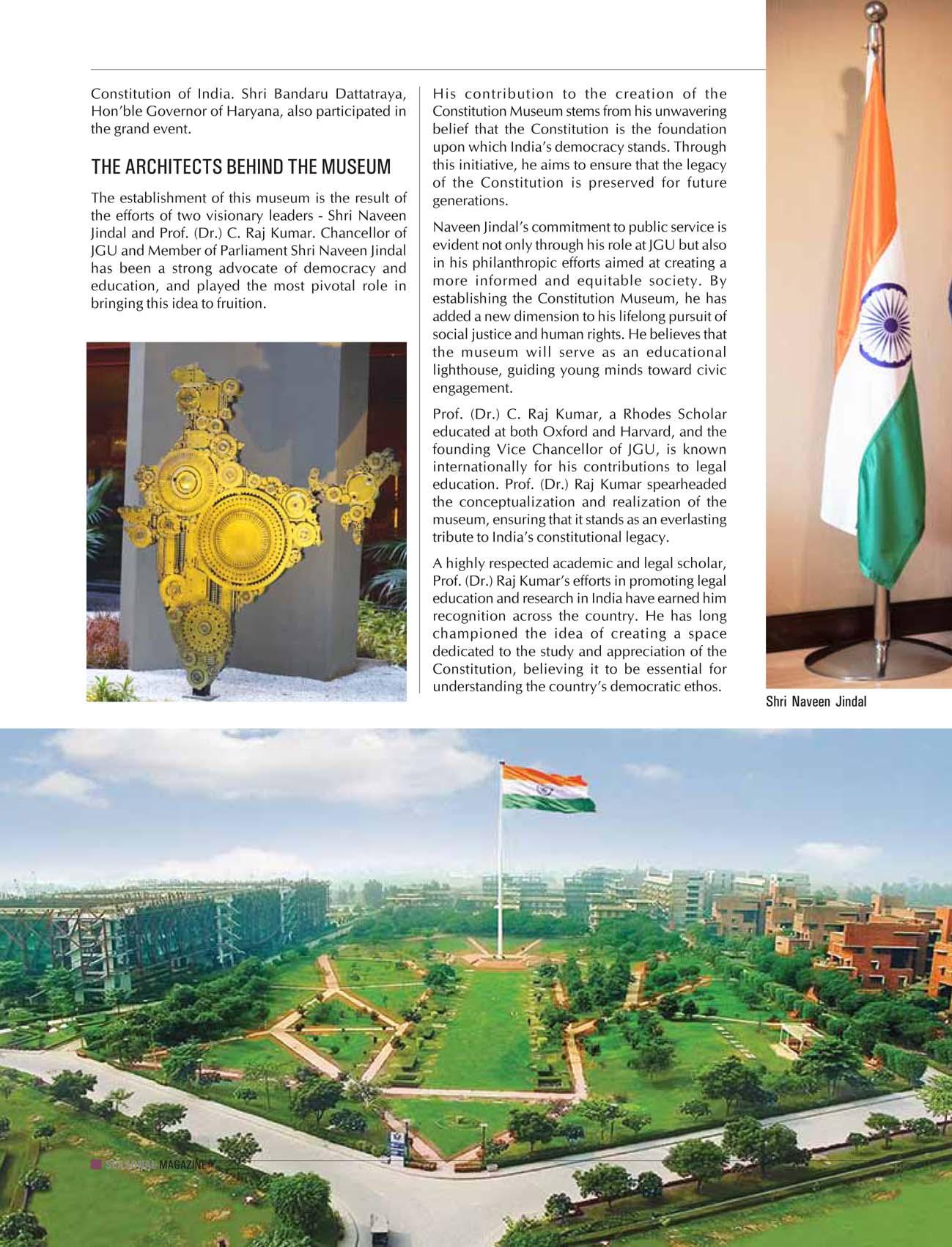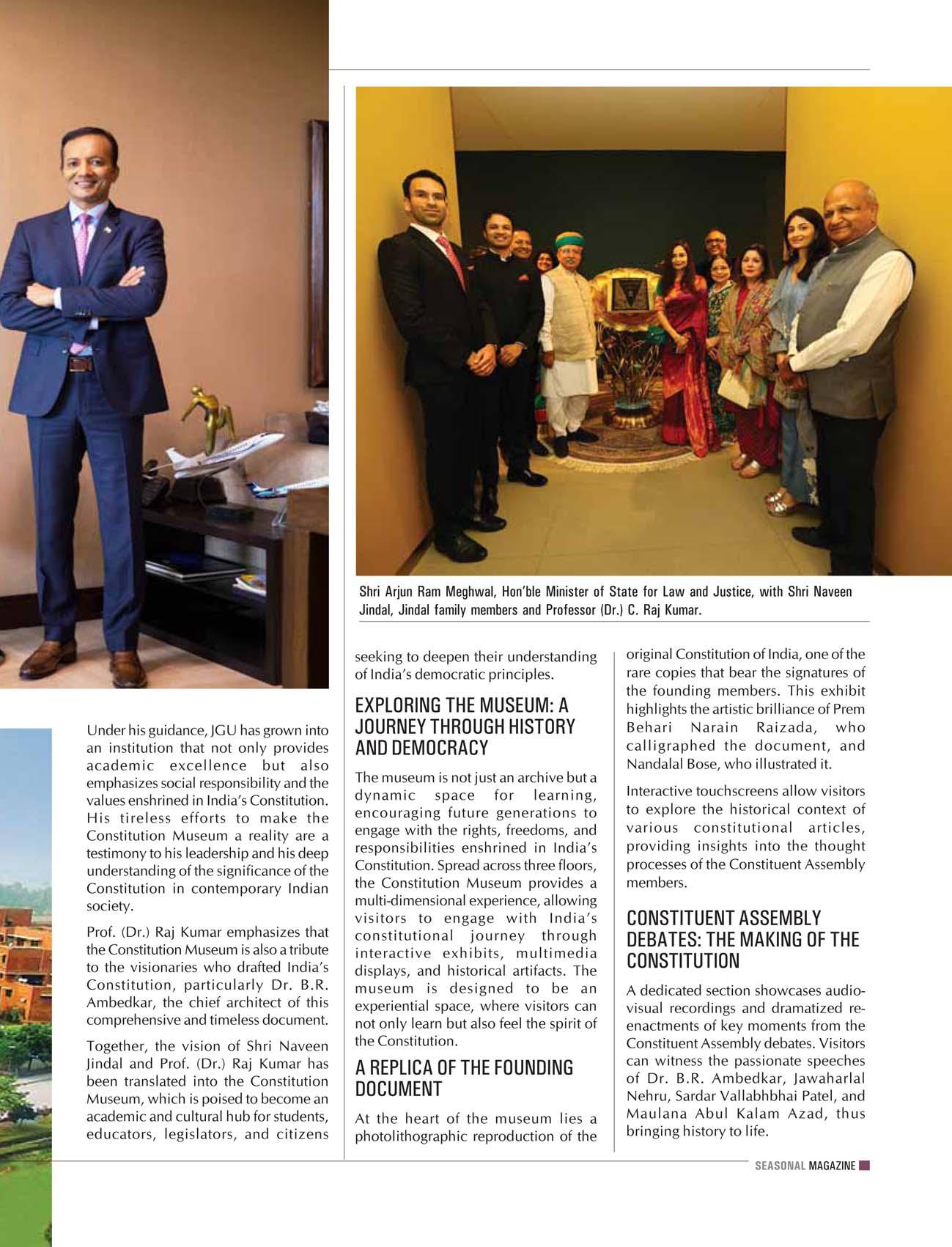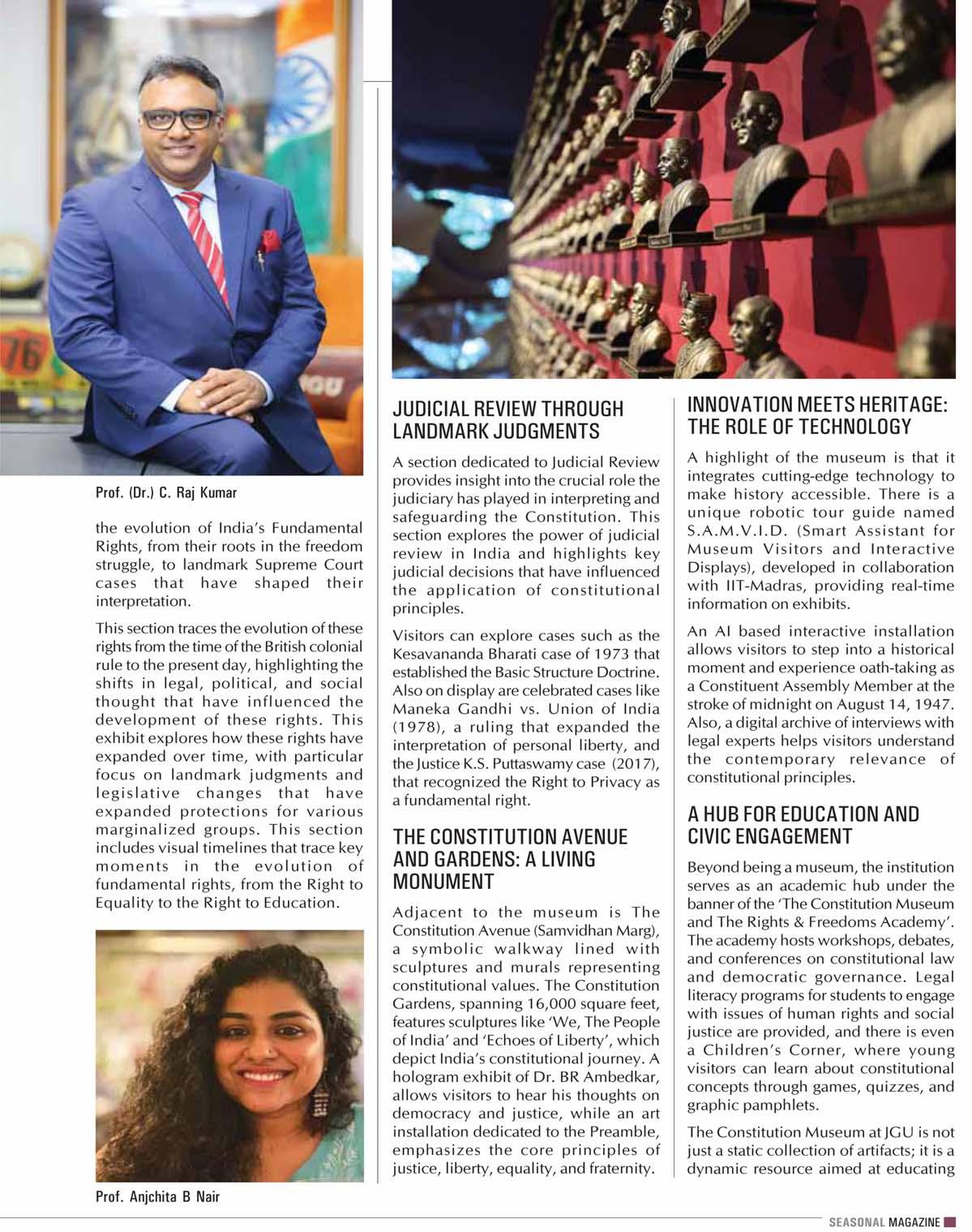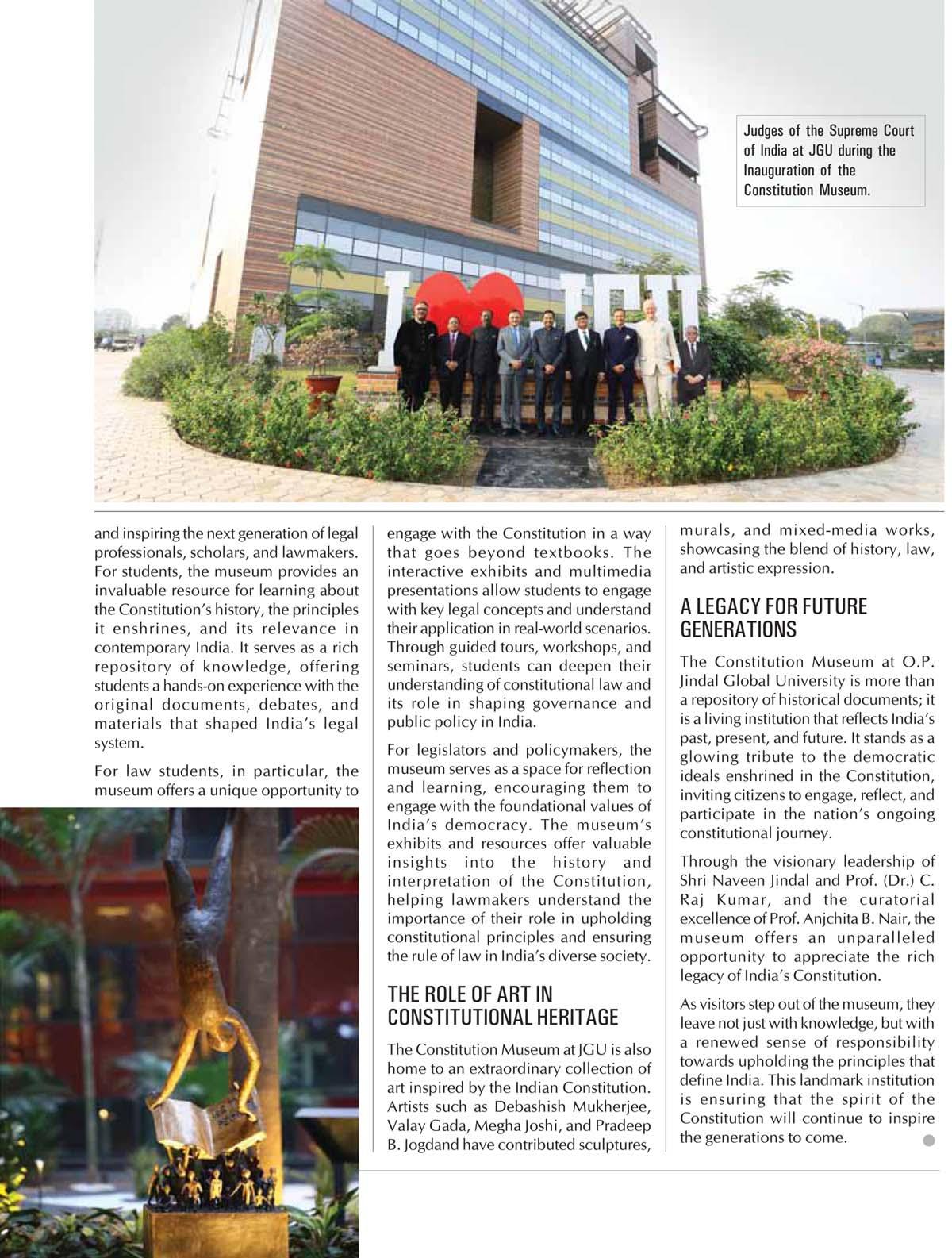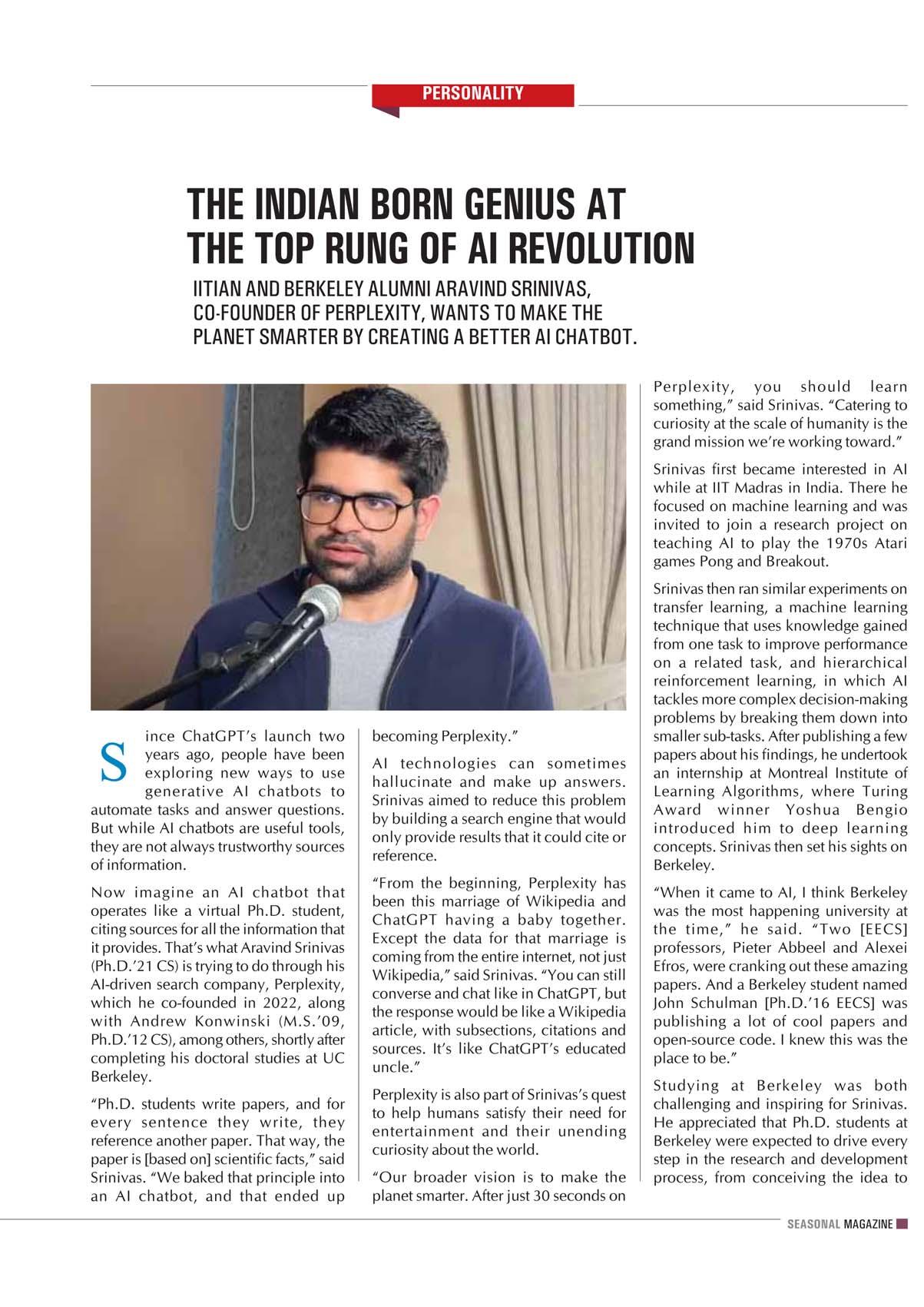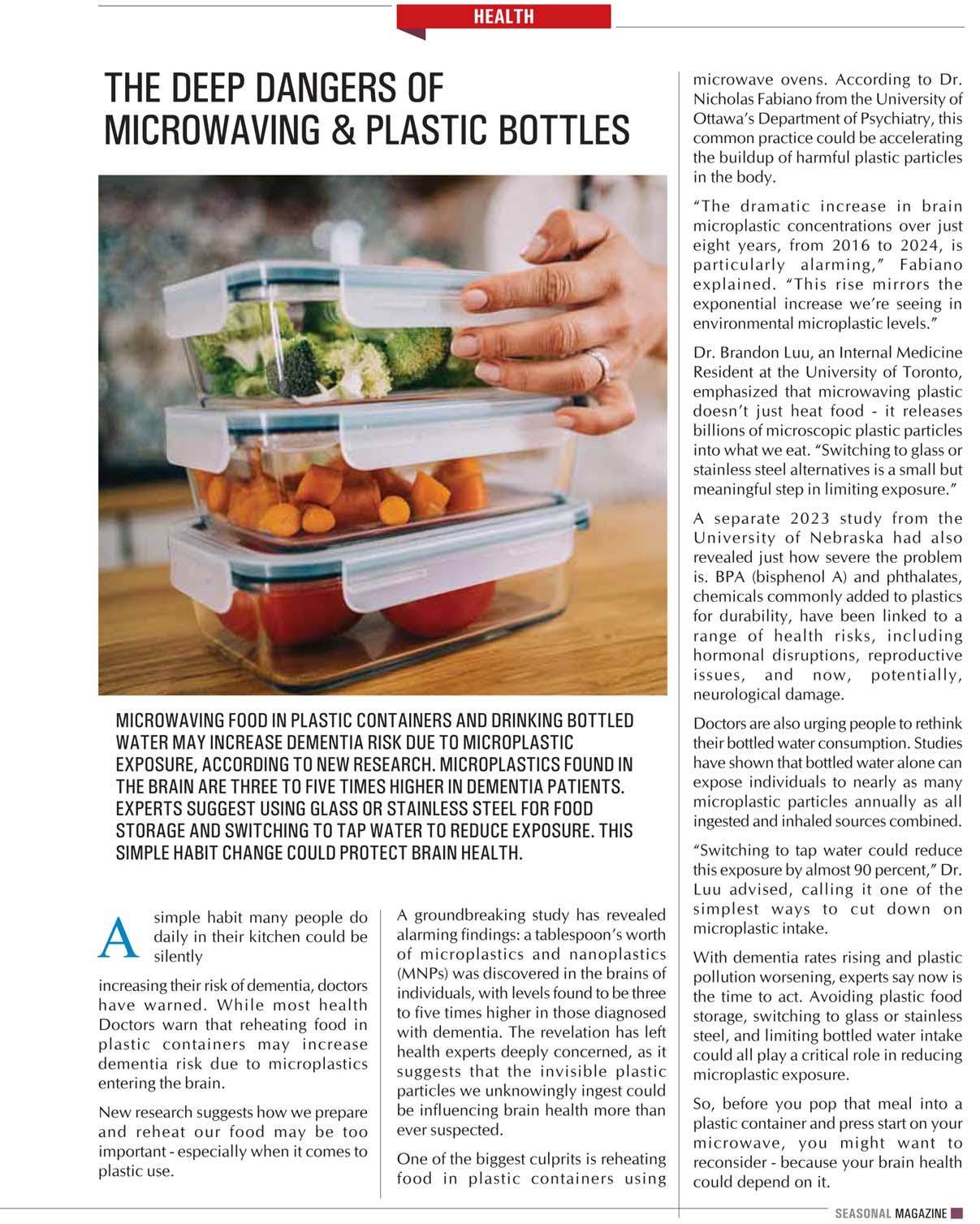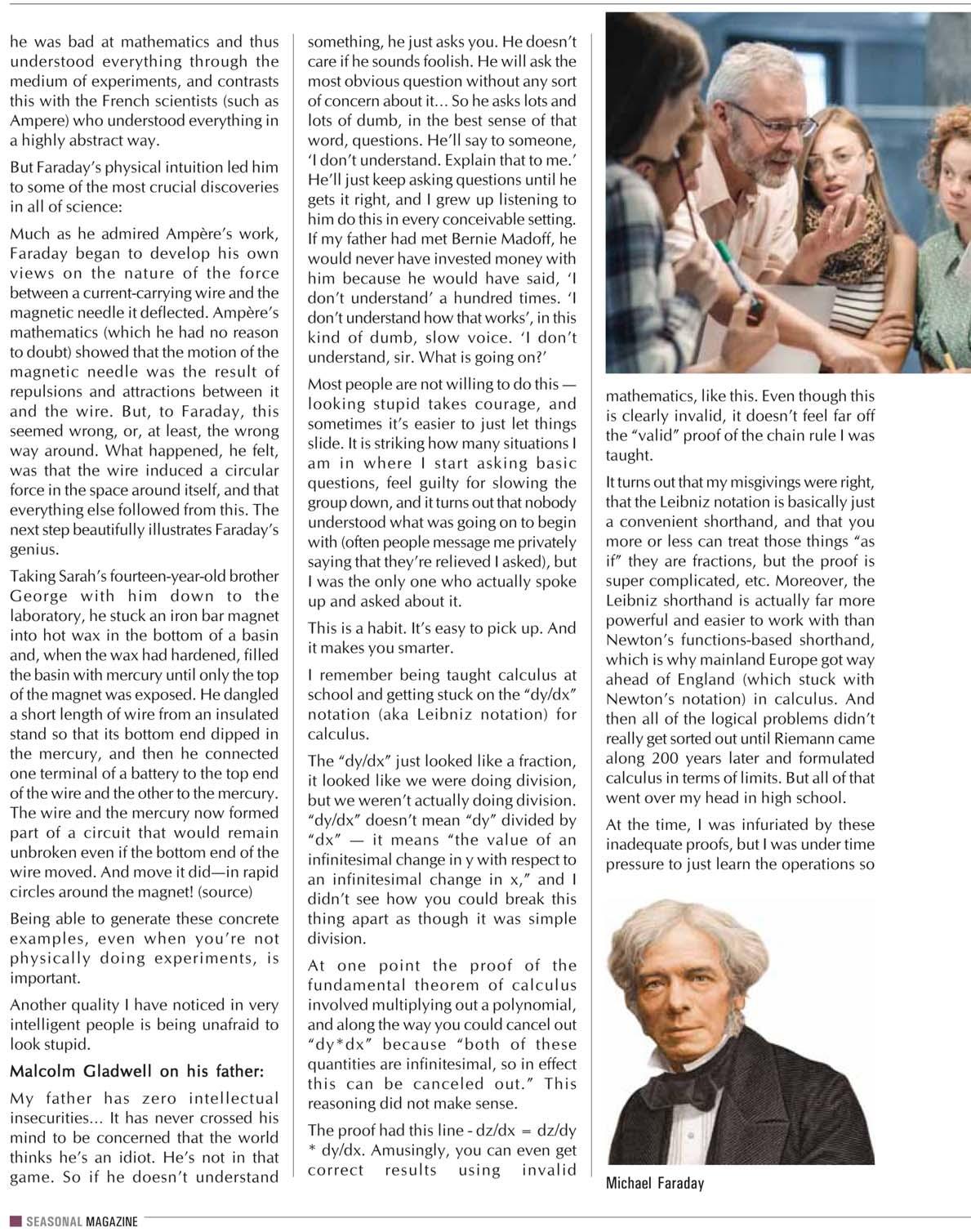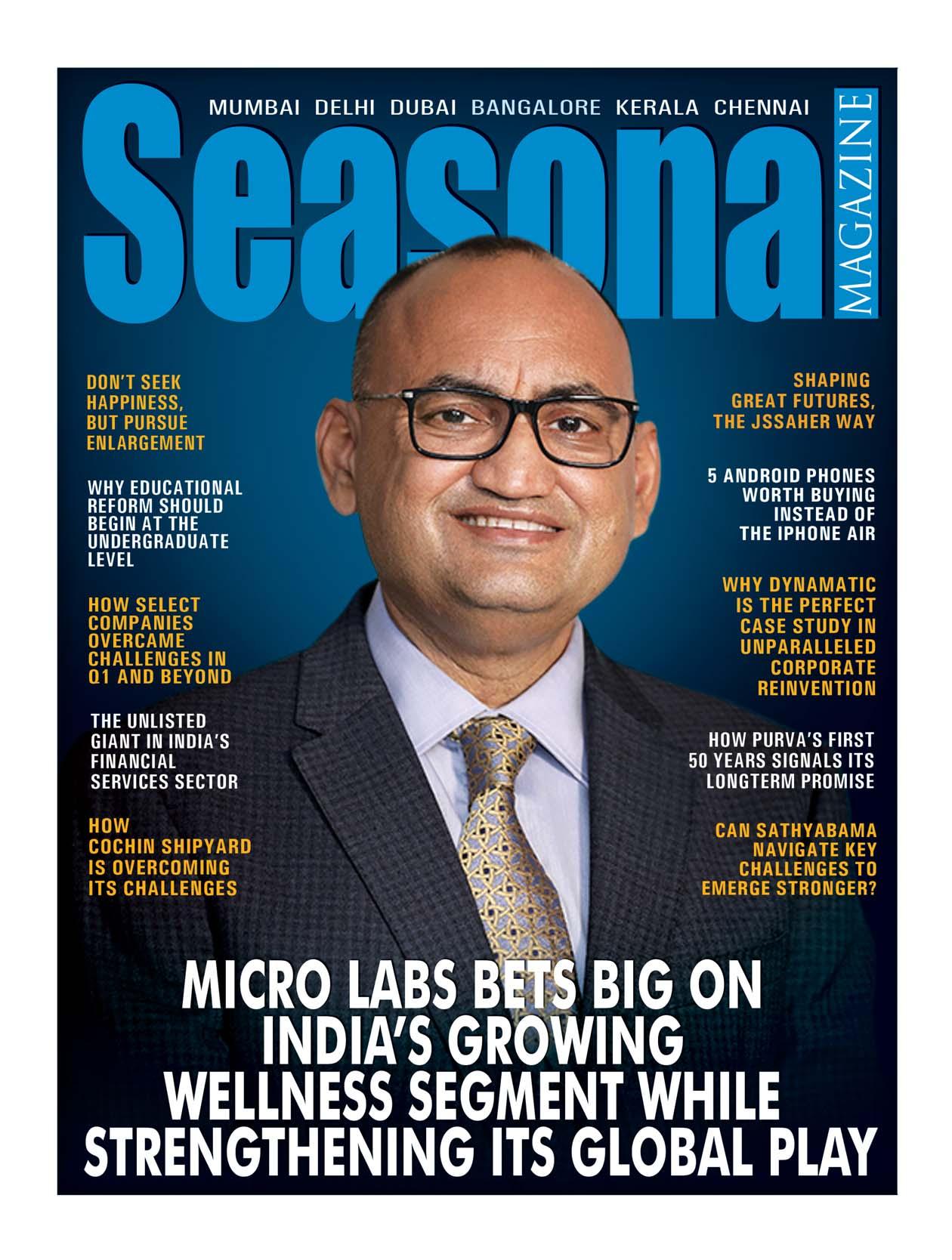
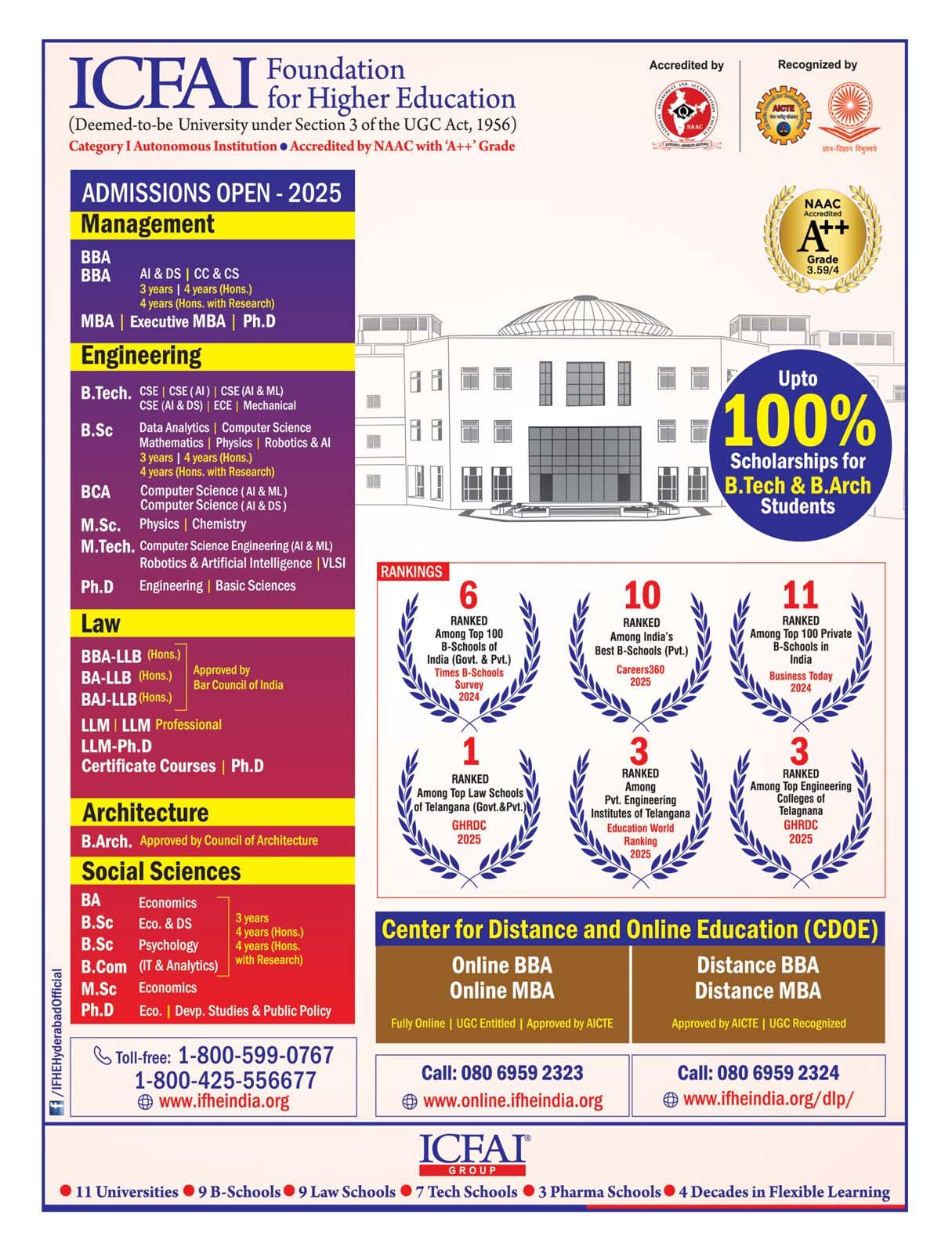
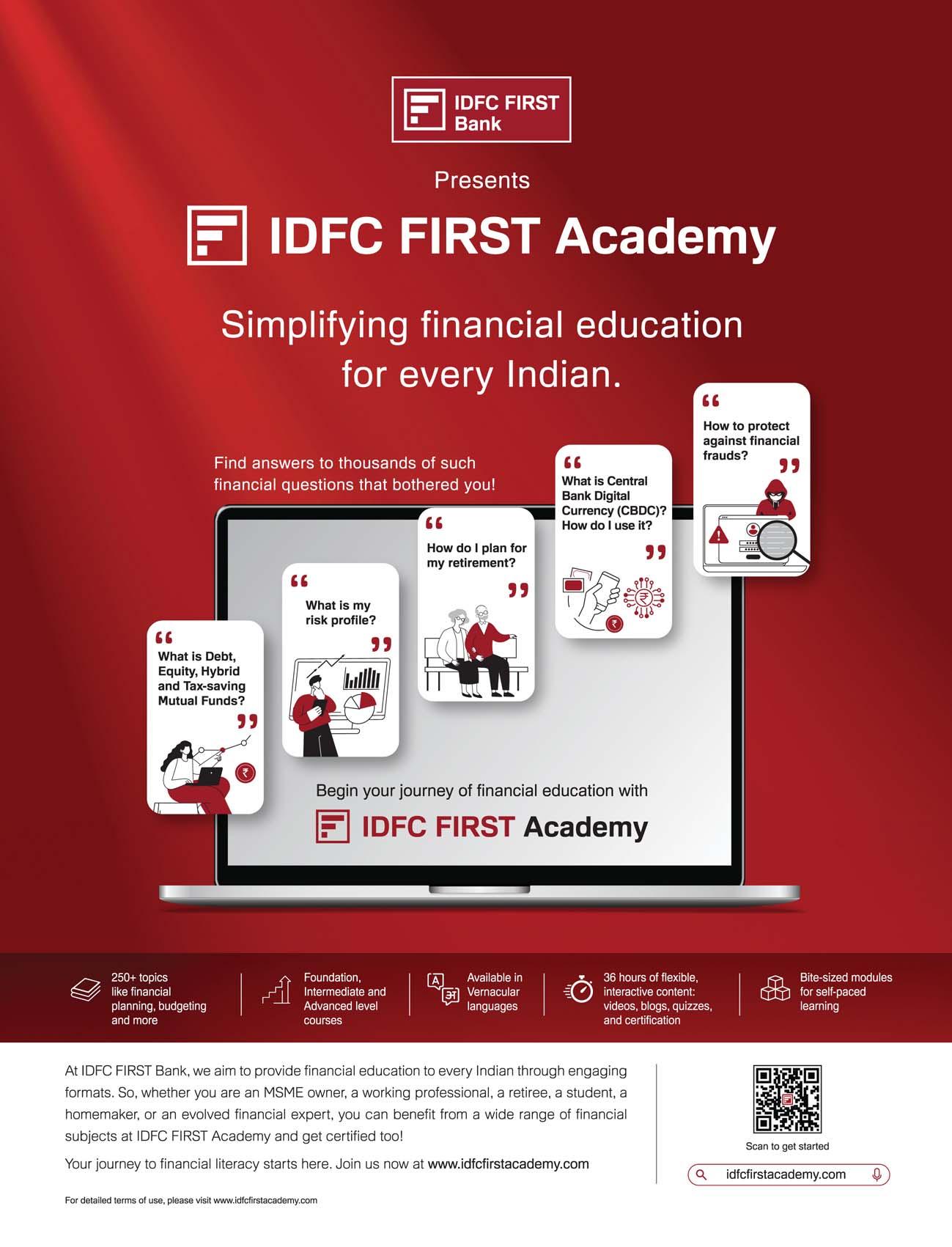




Managing Editor
Jason D Pavorattikaran
Editor
John Antony
Director (Finance)
Ceena
Associate Editor
Carl Jaison
Senior Editorial Coordinator
Jacob Deva
Senior Correspondent
Bina Menon
Creative Visualizer
Bijohns Varghese
Photographer
Anish Aloysious Office Assistant
Alby CG
Correspondents
Bombay: Rashmi Prakash
Delhi: Anurag Dixit Director (Technical)
John Antony
Publisher
Jason D Pavorattikaran
Editorial & Business Office
Cochin: 36/1924 E, Kaloor-Kadavanthra Road, Near IGNOU, Kaloor, Cochin-17. Ph:0484- 2345876, 2534377, 2340080 Mob. 09947141362
Delhi: H.No: P-108, Uppal Southend, Sector 48, Sohna Road, Gurgaon, Haryana – 122018 Ph: 9891771857|099471 41362
Mumbai: 202, Woodland Heights Building, St. Martins Road, Bandra West, Mumbai400 050 Mob: 919947141362
Bangalore: House No: 493, Block 3 3rd Main, HBR Layout, Bangalore-4209731984836, Email:skmagazine@gmail.com www.seasonalmagazine.com
UK Office: “CRONAN”, Boundaries Road Feltham, Middlesex, UK TW13 5DR Ph: 020 8890 0045, Mob: 00447947181950 Email: petecarlsons@gmail.com
Reg No: KERENG/2002/6803
Printed & Published by Jaison D on behalf of PeteCarlson Solutions Pvt. Ltd. at Cochin. Printed at Rathna Offset Printers, Chennai-14. All Rights Reserved by PeteCarlson Solutions Pvt. Ltd. No part of this publication may be reproduced by any means, including electronic, without the prior written permission of the publisher.


India seemingly faces stiff trade barriers from the United States, but in reality, these challenges are not as worrying as they might seem. India’s exports to the US, just about $78 billion a year, are tiny compared to its huge $4 trillion GDP - less than 2 percent. This means that even if US policies make selling to America harder, India’s economy won’t be badly hurt, since it mostly depends on its own people and growing trade with other countries.
The US often blames India for putting high tariffs or taxes on things like cars and electronics. For example, India has very high duties - sometimes up to 100 percent - on imported cars. But even if India cut these tariffs, American cars would still struggle to sell in India because they are far more expensive than cars from India, China, Korea, or even Japan. Indian customers want value for money, and local or Asian brands already meet these expectations at much lower prices. Removing tariffs would not suddenly open the floodgates for expensive US brands.
Trade talks now are caught in a web of international politics, especially because of the Russia-Ukraine war. Some in the US


claim India’s oil purchases from Russia help fund the Russian war effort. But in truth, it is the US that has benefited hugely from the Russia-Ukraine conflict, selling over $68 billion worth of weapons to Ukraine since the war began. American companies, especially arms manufacturers, have made big profits while the war continues. Accusing India is more about politics than fact.
US decisions aren’t just about policy, they are influenced by business interests. Former President Biden’s government strongly backed Ukraine, partly because of his family’s connections to businesses there, and this has been well reported in the American press. The current President Trump is more selective, while arms sales continue, deeper US support for Ukraine has faded. Reports link some of Trump family’s business interests in Moscow, which could explain America’s cooler approach to supporting Ukraine these days.
India has options. A zero-tariff trade deal with the US, where both sides drop taxes on many or even most products, could actually help India more, and not hurt it. With Indian exports like textiles, chemicals, IT services, and medicines, India could get more access to American buyers. Since US goods are expensive and not highly competitive in India, the risk of India’s market being swamped by US goods is low. Instead, Indian exporters could grow, learning from global standards and succeeding abroad.
But security remains a worry. The US keeps making overtures to Pakistan’s top military, especially welcoming their army chief with honors. This signals that Washington may still view Pakistan as a valuable partner, despite its poor track record on regional peace. This is quite ironic too, given the military animosity the US has with China, and how close China and Pakistan are. Trump family’s business interests in Pakistan have also come under scrutiny recently. India must speak up in diplomacy, making it clear that stability in South Asia is non-negotiable.
There have been more pressure tactics. US officials recently raised the H1B visa fees, needed by Indian tech talent hoping to work in America, by almost 40 times. This is meant to push India diplomatically. But it could backfire, with the US tech industry relying on Indian engineers, and hurting them will cause problems for American firms, especially when local talent is in short supply.
India should not get distracted with all these. Instead, it should focus on building better ties with many countries, not just America. India is strengthening relations with the EU, UAE, ASEAN, and Latin American countries, opening up more trade channels.
India can also act quickly when needed. When US tariffs started rising, the Indian government recently responded by slashing GST rates on popular items just before the festive season, giving families more spending power and businesses a boost. Creative steps like tax cuts are a response to tough times and show India’s ability to adapt and thrive.
India’s biggest strength is indeed its booming home market. There are over 300 million middle-class consumers in India, and retail sales during Diwali 2024 alone had hit Rs 2 lakh crore - a sign of powerful domestic demand. By supporting small businesses, startups, and local supply chains, India can weather global storms. In the past year, Indian startups attracted $15 billion in new investment, proving India’s growing confidence.
In the end, the US trade barriers are not an existential crisis for India. Since Indian exports to the US are very small compared to India’s total economic size, and because US goods are not a big threat in the Indian market even without tariffs, India can confidently pursue fairer trade deals. By resisting political pressure, calling out misdirection, and pursuing reforms at home, India can turn challenges into stepping stones toward greater growth and global leadership.
JohnAntony
With revenues around Rs 7,000 crore and profit around Rs 1,500 crore, Micro Labs is among the largest privately held Indian pharma firms. Under the visionary leadership of CMD Dilip Surana and Director Anand Surana, the Dolo-650 maker is extending this flagship brand to OTC wellness, even while taking over promising pharma firms overseas, strengthening its presence across 50 countries, and fortifying its leadership in respiratory, diabetic, pain management & ophthalmology.

Google LLC’s DeepMind research unit today announced a major update to a couple of its artificial intelligence models, which are designed to make robots more intelligent. With the update, intelligent robots can now perform more complex, multistep tasks and even search the web for information to aid in their endeavors...

Science Says Stop Asking ‘Will This Make Me Happy?’ and Start Asking Yourself This Instead. Predicting whether the outcome of a decision will make you happy is often impossible. Predicting a decision’s impact on you is not.

A veritable avalanche of influencers, news headlines, and well-meaning friends and family offer conflicting advice on wellness. But quick fixes and fads may do little for our health, and some even prove harmful. Instead, try to work these healthy habits into your...
Sathyabama Institute of Science and Technology (SIST) in Chennai, renowned for academic achievements and industry partnerships, is rapidly moving toward regional prominence under the leadership of Chancellor Dr. Mariazeena Johnson. Its celebrated convocation ceremonies and impressive placement rates have earned widespread admiration among students, parents, and recruiters. Yet, like all ambitious institutions, Sathyabama’s journey is not without its share of challenges.

Amid a dynamic year for the Indian banking sector, Jana Small Finance Bank continues to embody a narrative of optimistic progress against significant headwinds, powered by its visionary leadership and a steadfast emphasis on

Manappuram Finance, a name synonymous with gold-backed lending in India, is poised for a transformational leap. With Bain Capital acquiring a significant stake in the company, the gold loan giant is shifting from a promoter-driven entity to a

Bengaluru: Puravankara Limited (NSE: PURVA | BSE: 532891), one of India’s most admired and trusted real estate developers, today commemorated its 50year milestone with the release of a customised ‘My Stamp’ by
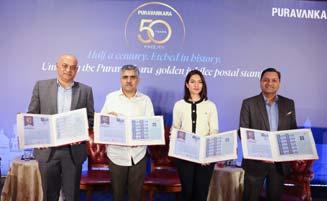

India Inc.’s Q1 FY26 scorecard is only mixed at best, but some companies stand out for facing down adversity. In this exclusive compilation, we dissect results from several such overcomers - from the surging profits of banks and industry mainstays to the resilient comebacks in manufacturing, real estate, and insurance. Witness their revenue climbs, profit pressures, operational breakthroughs, and the relentless drive of their visionary MDs & CEOs who turned challenges into opportunities in Q1, and beyond.
In the heart of Mysuru, JSS Academy of Higher Education and Research (JSS AHER) continues to scale new heights as a leader in healthcare education, research, and community service. In 2025, the institution strengthened its national and global standing by climbing to 21st in the NIRF Universities category and 38th overall, while its constituent colleges secured leading ranks in medicine, dental sciences, and pharmacy. On the world stage, JSS AHER also earned the 56th

In an age when manufacturing headlines are dominated by global supply-chain shocks and geopolitical jockeying, few Indian engineering stories feel as confidently future-facing as Dynamatic Technologies. Once a niche hydraulics maker, the Bengaluru-headquartered company has quietly reinvented itself into a multi-vertical engineering group. Dynamatic is today a Tier-1 supplier to Airbus and Boeing, a partner for regional aircraft assembly lines, and an increasingly important contributor to India’s defence manufacturing ambitions.

This science-backed approach will cure your procrastination with practical to-dos.

Experts caution that this fees can have a significant impact on long-term returns, especially when compounded over decades.

For years, nutrition has often been framed in fairly simple terms: food as fuel and nutrients as the body’s building blocks. Proteins, carbohydrates, fats and vitamins – about 150 known chemicals in total – have dominated the picture. But scientists now estimate that our diet actually delivers..
The iPhone 17 series is out, and as impressive as the iPhone 17 and iPhone 17 Pro may be, this year’s headturner is the iPhone Air. With a slim design that..
With courage, passion, and confidence, a person can achieve anything. IAS officer Varun Baranwal is a living example of this. Hailing from the small town of Boisar in Maharashtra, Baranwal once ran a puncture shop to earn a living for himself and his...

Muthoot Fincorp Ltd, the flagship company of the 138year-old Muthoot Pappachan Group (MPG), has once again reinforced its position as one of India’s most impactful non-banking financial companies (NBFCs). Operating under the banner of Muthoot Blue, the company has evolved far beyond its foundational legacy to become a financial sector powerhouse, offering financial services across gold loans, housing finance, automobile loans,..

Learn how to check your lung health at home with the simple BOLT Breathing Test. Know how it works, what your score means, and expert tips to improve breathing.

For employers, upskilling and certifications are valuable indicators of a candidate’s job readiness. They now increasingly evaluate professionals on these as..
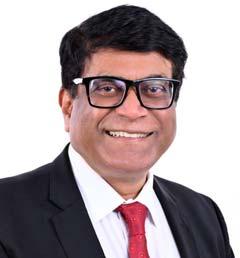
Nobody disagrees that all sectors of the Indian education sector need urgent upgrades. But where to start this daunting task? A leading voice in educational reform, Dr. Madhukar G Angur, has..

Turning 50 is often a time for reflection, and for Puravankara Ltd., one of India’s leading listed real estate developers, it’s also a moment of reiterating its forever commitments. Present now across 9 cities, with 51 million sq ft delivered, and with 80,000+ happy families as customers, Purva has come a long way from 1975. As the company marks its golden jubilee in 2025, Puravankara is not just basking in half a century of building dreams, but launching bold projects worth tens of thousands of crores, driving innovation in joint developments across major metros, and leveraging a 15 million sq ft launch pipeline to keep rivals on their toes. Amidst major redevelopments in Mumbai, blockbuster launches in Kochi, and robust sales momentum in Bengaluru, the leadership team led by Founder & Chairman Ravi Puravankara and MD Ashish..
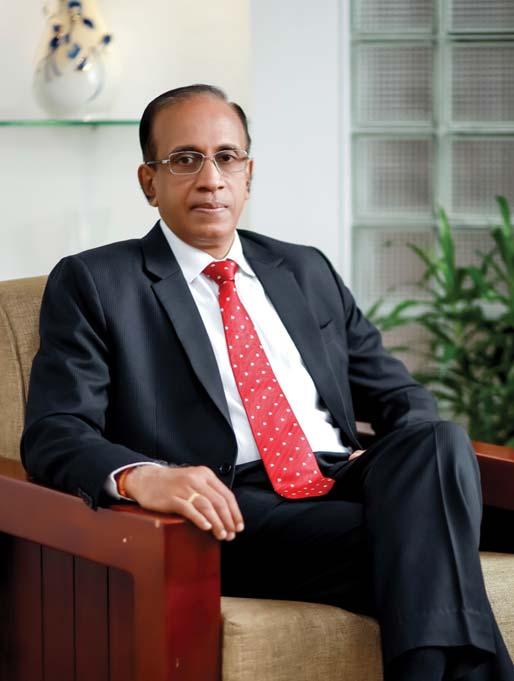
As India aspires to become a major maritime hub, Cochin Shipyard Limited (CSL) stands at the center of that ambition. A PSU under the Ministry of Ports, Shipping, and Waterways, CSL is India’s largest shipbuilding and ship-repair facility. But as with any large publicsector enterprise navigating high-growth waters, the journey of CSL is anything but a straight sail. However, Cochin Shipyard is overcoming all its challenges, one by one, under the visionary leadership of its Chairman & Managing Director Madhu S Nair, one among India’s most qualified and most experienced ship building engineers...
WITH REVENUES AROUND RS 7,000 CRORE AND PROFIT AROUND RS 1,500 CRORE, MICRO LABS IS AMONG THE LARGEST PRIVATELY HELD INDIAN PHARMA FIRMS. UNDER THE VISIONARY LEADERSHIP OF CMD DILIP SURANA AND DIRECTOR ANAND SURANA, THE DOLO-650 MAKER IS EXTENDING THIS FLAGSHIP BRAND TO OTC WELLNESS, EVEN WHILE TAKING OVER PROMISING PHARMA FIRMS OVERSEAS, STRENGTHENING ITS PRESENCE ACROSS 50 COUNTRIES, AND FORTIFYING ITS LEADERSHIP IN RESPIRATORY, DIABETIC, PAIN MANAGEMENT & OPHTHALMOLOGY.
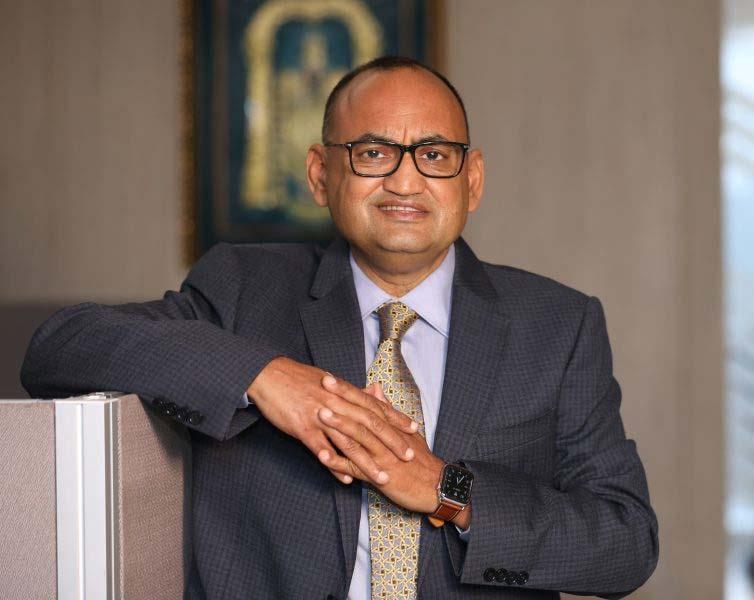
Micro Labs is already present in over 50 countries with on-theground operations in 25, exporting a wide range of products across various therapeutic areas. Their presence in countries like the USA, UK, Russia, Ukraine, and various Asian and African nations further solidifies their global ambitions.
Micro Labs’ success story is intertwined with the vision and strategic direction of its apex leadership. CMD Dilip Surana, a driving force since joining the family business in 1983, has steered the

Dilip Surana

company toward both domestic market leadership and a growing international presence. His commitment to instilling stringent quality standards has earned Micro Labs international regulatory approvals from bodies like US FDA, UK MHRA, and Australian TGA.
This dedication to excellence was recently recognized when Tumkur University conferred upon him an Honorary Doctorate, as an acknowledgment of his unwavering commitment to professional excellence, community upliftment and societal impact. This prestigious recognition, awarded during the university’s 18th Convocation on July 8, 2025, reflects his contributions beyond the realm of business. He is joined in leadership by Director Anand Surana and Head of Strategy Diya Surana, who, through initiatives like Micro Wellness, are actively shaping the company’s future, balancing growth with innovation and social responsibility.
One of the most notable recent shifts is Micro Labs’ expanded focus on its
wellness segment, leveraging the trust earned through the Dolo brand. This initiative, named ‘Micro Wellness,’ sees the company launching a range of OTC products under the Dolo name, such as Dolo pain relief spray, Dolosils Cough Lozenges, and Dolo Fevometer.
According to Diya Surana, Head of Strategy, Digital Transformation, and OTC Wellness at Micro Labs, this is a strategic move to meet the growing demand for lifestyle solutions, complementing the company’s existing focus on chronic disease therapies. This expansion into wellness underscores a broader trend in the pharmaceutical industry, of addressing not just illness but also preventative care and holistic well-being.
Micro Labs is not content to dominate only the domestic market. Their recent acquisition of Swiss Pharma Nigeria Limited (Swipha) highlights a clear strategy to deepen their presence on the African continent. Swipha, founded in 1976, specializes in branded generics across key therapeutic areas, including central nervous system, anti-malaria,
SEASONAL MAGAZINE
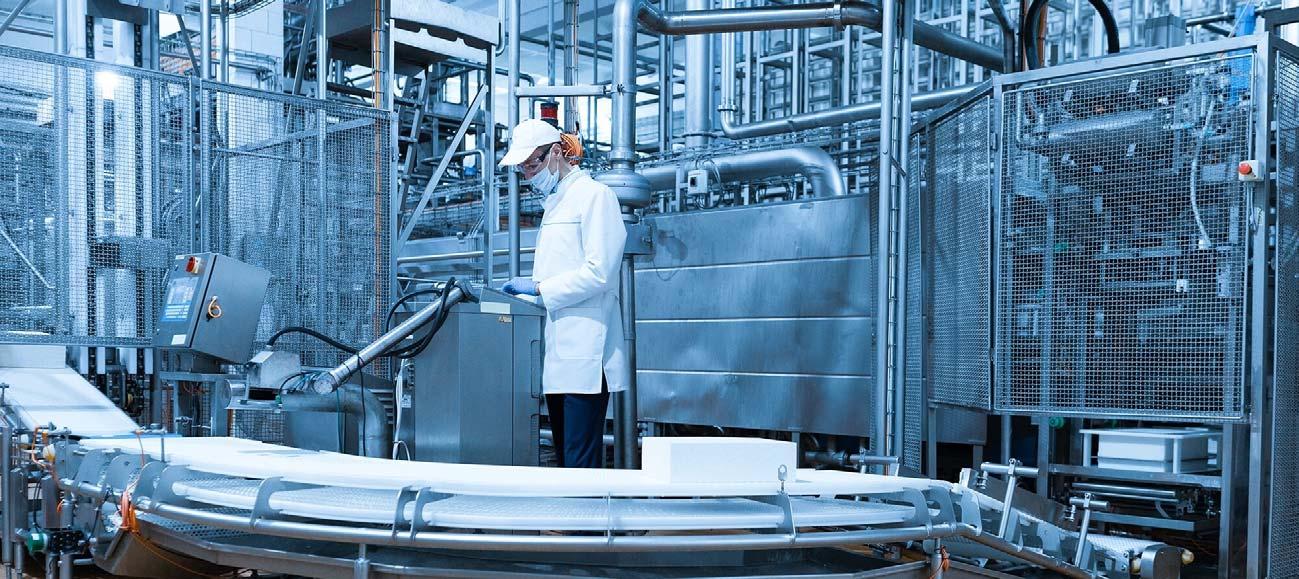
anti-infectives, cardiovascular, antidiabetic, and nutraceuticals. This acquisition, along with their existing subsidiary Micro Nova Pharmaceutical Ind. Ltd in Nigeria, demonstrates Micro Labs’ long-term vision to expand its global footprint.
Innovation remains a cornerstone of Micro Labs’ operations. The introduction of Trisopt, the world’s first triple drug fixed-dose combination for glaucoma management, showcases their commitment to developing novel solutions for unmet medical needs. This indigenous development, manufactured at their Sikkim facility, underscores their investment in research and development and ability to deliver cutting-edge treatments.

Earlier, in September 2024, Micro Labs had launched Linapride DM, an affordable treatment for diabetes in India. Given the staggering number of individuals affected by diabetes in India, this launch reflects their commitment to making essential medications accessible, particularly for those who may need multiple medications to manage the disease.
A cornerstone of Micro Labs’ enduring success has been its focus on quality Active Pharmaceutical Ingredients (APIs). The company has consistently invested in backward integration and world-class API manufacturing facilities, ensuring reliable supply chains and uncompromised product quality. Reflecting on this, CMD Dilip Surana said: “For us, quality is not negotiable. Our investment in building strong API capabilities has been central to our growth story—helping us maintain global standards, win the trust of healthcare professionals, and deliver affordable, effective medicines to millions of patients.”
Micro Labs has demonstrated consistent financial performance, with revenues growing steadily and operating margins remaining stable. Their strong financial risk profile, including low gearing and healthy cash accrual, positions them well for future growth. The firm is also investing in expanding their manufacturing capabilities, with plans
for expanded annual capex and evaluation of inorganic growth opportunities.
Predominantly a prescription drug company, Micro Labs is also aggressively pursuing the marketing route for its OTC segment, committing to a 360-degree marketing approach that combines traditional, digital, and consumer engagement strategies. Diya Surana explained: “The Dolo brand has built immense trust among consumers. With Micro Wellness, we are taking this trust forward through a 360-degree marketing strategy that reaches people across touchpoints—whether it’s doctors, pharmacies, or directly through consumers. We believe wellness is not just about treatment but about building a healthier lifestyle, and we want our communication to reflect that vision.”
Micro Labs is proving that it is a dynamic pharmaceutical company that is actively evolving to meet the demands of a changing healthcare landscape. By expanding its product offerings into wellness, strategically acquiring companies to bolster its global presence, investing in research and development, and maintaining a strong financial position while engaging in social responsibility, Micro Labs appears poised for continued growth and innovation in the years to come, under Dilip Surana’s entrepreneurial acumen.
Once upon a time, Dolo nce upon a Dolo nce upon a time, Dolo nce upon a Dolo nce upon a time, Dolo broke into the most broke into the most broke into the most broke into the most most overcrowded paracetamol overcrowded paracetamol overcrowded paracetamol overcrowded paracetamol overcrowded paracetamol market on a simple market on a market on a simple market on a premise - superior effectiveness. premise - effectiveness. premise - superior effectiveness. premise - effectiveness. While everyone else including MNC giants were content offering giants were content a 500 mg dosage, which was a 500 which was which clearly ineffective for the new clearly ineffective for the ineffective for generation of viral fevers, Dilip generation of fevers, Surana delivered 150 mg more mg more Surana delivered 150 mg more mg more which made all the difference - made all thefor patients as well as the patients as well as the for patients as well as the patients as well as the for patients as well as the prescribing doctors. In hindsight, prescribing doctors. In hindsight, prescribing doctors. In hindsight, prescribing doctors. In hindsight, any brand could have done it, brand any brand could have done it, brand any brand could have done it, but no one did it in time. Can the no one in time. Can but no one did it in time. Can the no one in time. Can but no one did it in time. Can the Suranas do such a unique do such a unique do strategy again, this time in again, time Wellness?
The house of Dolo has quietly built a second growth engine in consumer wellness, and 2025 is the year it starts to hum. Under a newly structured Micro Wellness umbrella, the company is extending its trusted Rx equities into an over-the-counter (OTC) portfolio aimed at everyday ailments: sore throats, acidity, aches and pains, and habit support.
The logic is simple - leverage a household name like Dolo, meet a widening demand for self-care, and win the pharmacy counter with familiar branding and fast relief. As Diya Surana, Head of Strategy, Digital Transformation and OTC Wellness, put it, the wellness push “aligns with the growing demand for lifestyle solutions,” complementing Micro Labs’ chronic-care base.
The Micro Wellness Division already has three aces up its sleeve. Dolosils


Lozenges targets the cough-and-throat segment with a classic antiseptic duoamylmetacresol and dichlorobenzyl alcohol - positioned for quick sootheand-go relief - in an accessible bridge from prescription cough brands to an OTC offering.
The next ace, Gastrium Suspension extends the company into the highvelocity gastro aisle, treating acidity, reflux and indigestion, which is one of India’s most shopped OTC subcategories. Rounding out pain and mobility, Dolo Ultra pain-relief gel taps the mother brand’s equity to address muscle and joint discomfort with a quick-absorbing, non-greasy topical cream. These products are already available on major e-pharmacies, marking a national rollout.
Strategically, Micro Labs is executing a de-risked house-of-brands approach anchored in Dolo’s recognition. The playbook is to migrate select legacy Rx equities to consumer formats like sprays,

gels, lozenges, suspensions etc, keeping a pricing aimed for the mass-premium segment, and building fast moving brands that pharmacists can recommend on autopilot.
Micro Wellness is likely to have a phased pipeline - Dolosils, Gastrium and Dolo Ultra among the near-term rollouts, followed by extensions such as Dolo pain-relief spray and a consumer thermometer, Dolo Fevometer. Expect pharmacies to have a cohesive OTC aisle block under the Dolo banner soon.
The Suranas’ strategy is to add lifestyleled categories that grow faster than the prescription market. Beyond the initial trio of products, Micro Wellness has signaled a nicotine-replacement gum (Nicobyt) and other self-care lines, pointing to a broader everyday-health franchise strategy with shopper marketing and behavior-change campaigns like “Quitting is Winning.”
The commercial upside is promising to say the least. India’s OTC consumerhealth market in vitamins/supplements and gastro is among the country’s largest and most impulse-driven pharmacy baskets. Micro Labs’ own commentary and media coverage reveal a calculated move to capture that velocity. The company benefits from a formidable distribution backbone and prescriber trust built over decades, advantages that can mean the difference between a market leader and the also-rans.
But the categories Micro Labs is entering now are overcrowded, dominated by advertising-heavy players. Winning will require distinctive claims grounded in speed of relief, clinician credibility, and precise retail execution or in other words visibility at the chemist counter. Still, the brand math is compelling; if Dolosils becomes the go-to sore-throat lozenge, Gastrium the everyday antacid, and Dolo Ultra the first choice pain gel, Micro Labs can convert Dolo’s prescription fame into a sticky consumer habit. With Diya Surana helming Overall Strategy as well as OTC Wellness, the company’s foray looks less like a detour and more like an inevitable twin engine of growth.


WITH COURAGE, PASSION, AND CONFIDENCE, A PERSON CAN ACHIEVE ANYTHING. IAS OFFICER VARUN BARANWAL IS A LIVING EXAMPLE OF THIS. HAILING FROM THE SMALL TOWN OF BOISAR IN MAHARASHTRA, BARANWAL ONCE RAN A PUNCTURE SHOP TO EARN A LIVING FOR HIMSELF AND HIS FAMILY. BUT THROUGH HIS HARD WORK AND PASSION, HE HAS BECOME AN IAS OFFICER.
Varun Baranwal’s father repaired bicycles, which provided for their daily bread and butter. However, his untimely death in 2006 left the family facing a financial crisis. This responsibility fell on Baranwal’s shoulders and he had to take over his father’s bicycle repair shop for a living. He passed the 10th grade, securing second place in the city. However, instead of enrolling in Intermediate for further studies, Baranwal spent his days and nights repairing bicycle punctures. Although he wanted to continue his education after the 10th grade, financial constraints prevented him from pursuing Intermediate.
However, seeing his dedication, an acquaintance, Dr. Kampli, secured his college admission. Thus, Baranwal was able to resume his studies. “I never spent a single rupee on my studies. Someone or the other paid for my books, forms, and fees. My doctor paid my initial fees, but after that, I was worried about how I would pay the monthly school fees,” he said.
Baranwal initially sought admission to medical college after completing his 12th grade. However, due to the high fees, he decided to switch to engineering. He was accepted into MIT College in Pune. Struggling to pay his college fees, he attended classes during the day, and repaired bicycles in the evenings, as well as provided tuition. Remarkably, he topped his first semester of engineering. Following this achievement, the college awarded him a scholarship.

After completing his engineering studies, he secured a job with a multinational company. While his family wanted him to stay with the MNC, he aspired to take the Civil Services exam. Eventually, an NGO came to his aid, providing him with the necessary books. In 2016, he successfully qualified for the IAS, achieving an all-India rank of 32.
Varun Baranwal’s inspiring journey from modest beginnings to becoming an IAS officer highlights the transformative power of perseverance, passion, and unwavering belief. Despite financial challenges and personal sacrifices, his indomitable spirit and commitment to education have made him a shining example for aspiring civil servants and those facing adversity.
(Credit: News18)
However, seeing his dedication, an acquaintance, Dr. Kampli, secured his college admission. Thus, Baranwal was able to resume his studies. “I never spent a single rupee on my studies. Someone or the other paid for my books, forms, and fees. My doctor paid my initial fees, but after that, I was worried about how I would pay the monthly school fees.

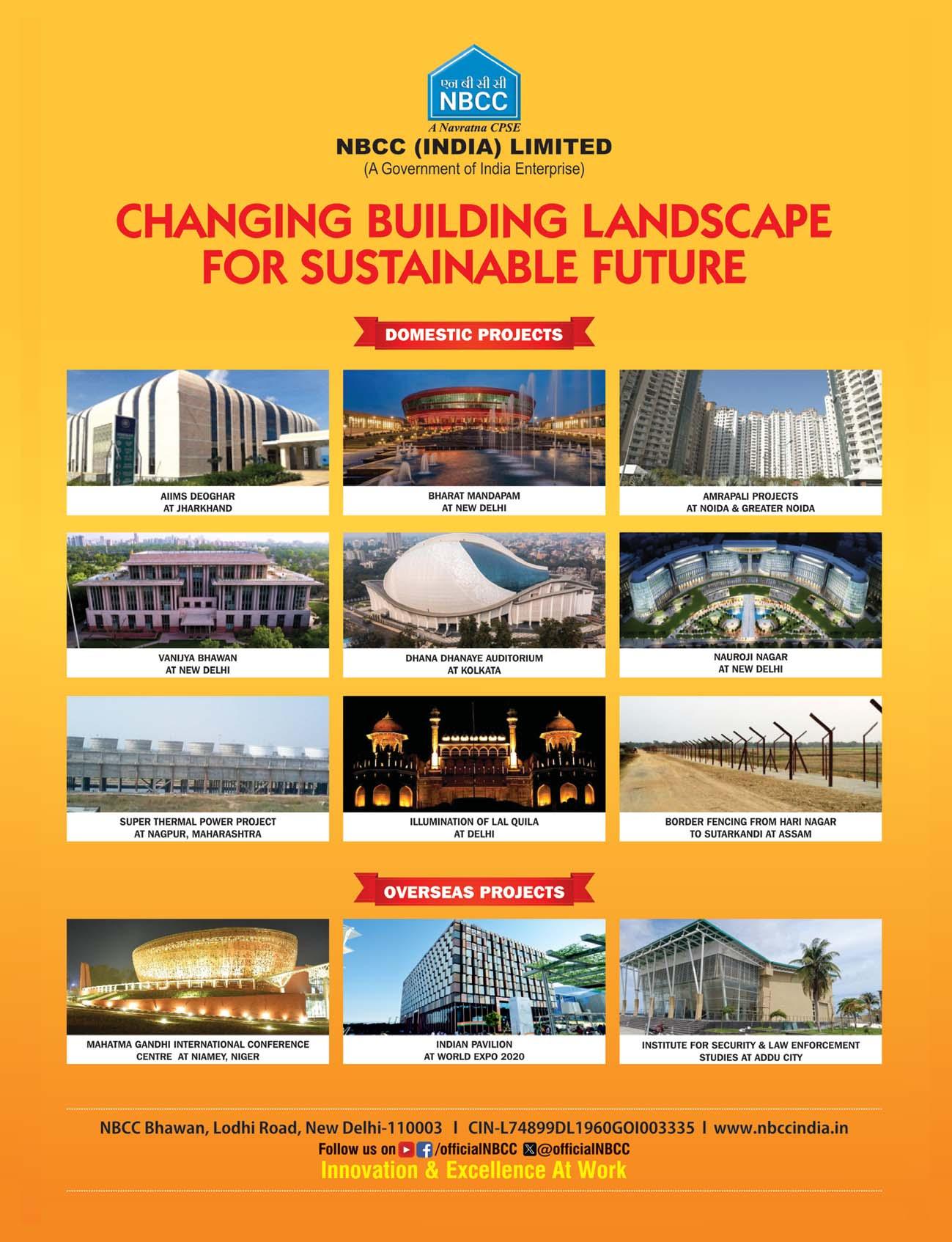
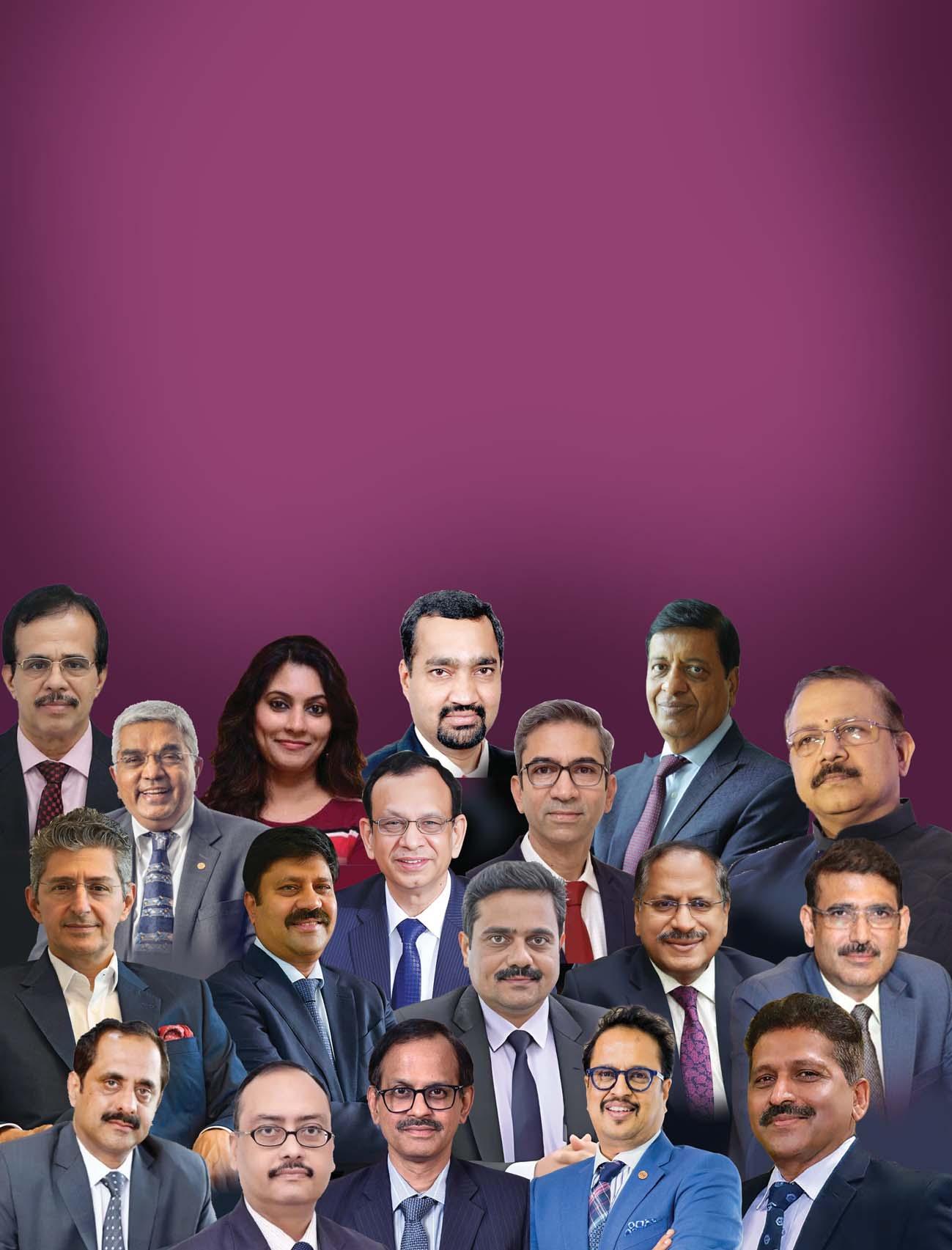
INDIA INC.’S Q1 FY26 SCORECARD IS ONLY MIXED AT BEST, BUT SOME COMPANIES STAND OUT FOR FACING DOWN ADVERSITY. IN THIS EXCLUSIVE COMPILATION, WE DISSECT RESULTS FROM SEVERAL SUCH OVERCOMERSFROM THE SURGING PROFITS OF BANKS AND INDUSTRY MAINSTAYS TO THE RESILIENT COMEBACKS IN MANUFACTURING, REAL ESTATE, AND INSURANCE. WITNESS THEIR REVENUE CLIMBS, PROFIT PRESSURES, OPERATIONAL BREAKTHROUGHS, AND THE RELENTLESS DRIVE OF THEIR VISIONARY MDS & CEOS WHO TURNED CHALLENGES INTO OPPORTUNITIES IN Q1, AND BEYOND.
n Q1 FY26, Avanti Feeds Limited, led by its Chairman & MD Indra Kumar, showcased significant resilience and growth despite persistent margin pressures in its core feed business. Revenue for the quarter climbed to Rs 1,606 crore, up 6.64% year-on-year, buoyed largely by booming processed shrimp exports which offset weaker domestic sales in the feed segment. EBITDA improvement stemmed from operational efficiency and cost rationalisation, which helped contain the impact of rising input prices. Net profit surged to over Rs 185 crore, marking a 34.8% rise as gains in export volumes and prices outpaced the challenges in feed segment margins and currency fluctuations. No significant debt-related concerns were disclosed, with the business model relying primarily on manufacturing and exports, based on a traditionally strong and clean balance sheet. Key issues during the quarter were volatility in raw material costs and heightened competition from international suppliers, but Indra Kumar’s leadership ensured strategic procurement, expansion into higher-margin export markets, and ongoing quality innovations. By strengthening farmer relationships and focusing on technologydriven supply chains, Avanti Feeds has weathered industry pressures efficiently. The company remains committed to sustainable aquaculture growth, product diversification, and market expansion, with a positive outlook for leveraging its leadership and capabilities in a fluctuating global environment.


U Small Finance Bank, under the steady leadership of its Founder, MD & CEO Sanjay Agarwal, delivered a robust revenue growth in Q1 FY26 despite some challenges in its asset quality metrics. The bank’s revenue expanded by 21% year-on-year to Rs 5,189 crore, illustrating continued traction in retail lending and deposits as branch expansions and enhanced product mix gathered pace. EBITDA growth remained strong, supported by ongoing digitalisation and efficient cost management that buffered against increased operational expenditures. Net profit for the period rose by 15.6% to INR 580.9 crore, outpacing market forecasts and demonstrating the sustainable earnings power of AU’s expanding portfolio. The quarter did, however, reveal a sequential rise in gross nonperforming assets to Rs 2,751.3 crore, nudging the GNPA ratio up to 2.47%, a sign that some customer segments continue to feel macro pressures. Debt ratios were contained through prudent risk management, though the bank faces persistent challenges from tightening margins and elevated credit costs. Facing these hurdles head-on, Sanjay Agarwal and his team have doubled down on digital banking initiatives, customer engagement, and product innovation. The bank’s resilience flows from a leadership team focused on risk mitigation, operational discipline, and nurturing customer trust, ensuring AU Small Finance Bank stays agile in turbulent markets. Looking forward, the bank intends to strengthen its retail and MSME portfolios and ramp up technology investments, all of which are expected to deliver sustainable growth and profitability in the coming quarters. AU SFB has also obtained an inprinciple approval for universal banking licence, which also bodes well for the lender.
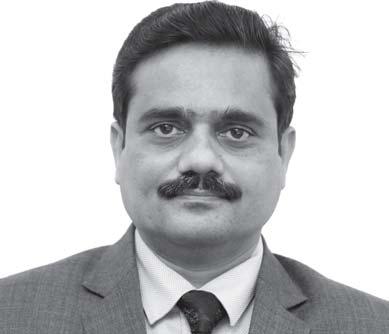
Bank of Baroda, led by its MD & CEO Dr. Debadatta Chand, reported a resilient Q1 FY26 performance marked by revenue growth and operational stability, even as profit headwinds persisted. The bank registered a consolidated revenue of Rs 38,404 crore, representing a 7.27% increase year-on-year, as domestic and international deposits saw singledigit expansion reflecting continued customer trust. EBITDA remained steady, with operational efficiency initiatives offsetting much of the cost pressures from inflation and network expansion. However, consolidated profit after tax slipped by 26.62% to Rs 3,469 crore due to rising interest costs and a 1.4% decline in net interest income, primarily attributable to exceptional items involving tax refunds. Asset quality was kept in check, with GNPAs contained and effective risk management cushioning against macroeconomic uncertainty. Debt ratios improved slightly, underpinned by disciplined capital allocation. The bank’s challenges included softer loan demand, competitive pressures, and ongoing regulatory changes that weighed on profitability. Dr. Debadatta Chand’s leadership focused on digital innovation, strategic branch rationalisation, and renewed attention to MSME and retail segments, helping the bank adapt to shifting market conditions and regulatory landscapes. Moving ahead, Bank of Baroda is poised to benefit from its strategic pivots, technology investment, and sector expertise, signalling an optimistic outlook for its growth journey in FY26.
Bank of Maharashtra, under MD & CEO AS Nidhu Saxena, reported another quarter of robust growth in Q1 FY26, with profit after tax rising 22.3% year-on-year to Rs 1,593 crore. Revenue reached Rs 7,879 crore, marking a 16.4% uptick as steady growth in advances and deposits continued. EBITDA for the quarter stood at Rs 5,465 crore, reflecting healthy operating performance and efficient cost management. EPS improved to Rs 2.00, up from Rs 1.80 in the same quarter last year, signifying resource optimization and improved profitability. The bank maintained strong asset quality, with its gross NPA ratio improving to 1.74% and net NPA declining slightly to 0.18%, both among the lowest in the sector. Credit risk and potential bad debts have been managed effectively, as evidenced by reduced provisions and contingencies year-over-year. Elevated costs remain a challenge, with total expenses growing by nearly 19% compared to last year, primarily due to expansion and operational activity. Despite these pressures, MD & CEO Nidhu Saxena has focused on digital initiatives, process automation, and branch network expansion, positioning the bank for strong future growth. The leadership’s direction toward expanding the retail and agricultural portfolio, coupled with prudent risk containment, continues to drive Bank of Maharashtra’s success. The outlook remains positive with steady earnings momentum and innovation, creating confidence that the bank will continue to outperform its peers.
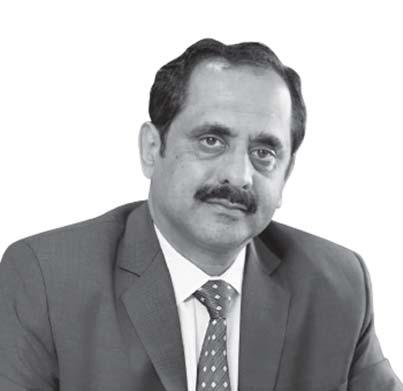
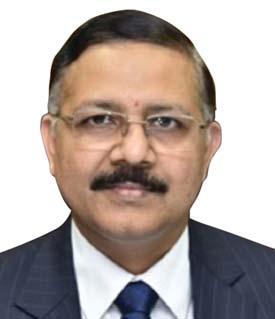
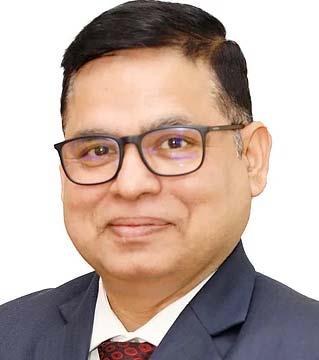
Central Bank of India, under the leadership of its outgoing MD & CEO MV Rao, posted a robust Q1 FY26 with strong profit growth and enhanced asset quality. Net profit surged 32.84% year-on-year to Rs 1,169 crore, driven by solid advances, deposit gains, and effective cost controls. The bank’s total business expanded 10.84% to Rs 7,04,485 crore, with total deposits increasing 11.41% to Rs 4,28,890 crore, supported by a rising CASA ratio of 46.88% indicating cheaper funds. Gross advances grew by 9.97% to Rs 2,75,595 crore, reflecting Central Bank’s strengthened retail, agricultural, and MSME lending focus. EBITDA and operating profits improved alongside treasury gains and operational efficiencies. The bank made noteworthy progress on asset quality, with gross NPA ratio improving marginally to 3.13% from previous quarters and net NPA dipping to 0.49%, reflecting the management’s commitment to rigorous risk assessment and recoveries. Capital adequacy ratio stood solid at 17.66%, signifying a strong capital position. MV Rao attributed these results to the bank’s diversified loan portfolio combined with digitization and customer-centric initiatives, which helped navigate economic volatility. Challenges remain in sustaining growth momentum amid competitive pressures and macro uncertainties, but with a strategic focus on retail expansion and balanced assetliability management, Central Bank is poised for continued performance improvement under its incoming MD & CEO Kalyan Kumar. The leadership, currently led by its Executive Directors, maintains an optimistic outlook for FY26 with a disciplined approach to risk, technology adoption, and market expansion underpinning the bank’s future trajectory.

Federal Bank, led by MD & CEO KVS Manian, delivered healthy results in Q1 FY26 as profitability felt the impact of rising provisions while core business continued to grow steadily. The bank posted a standalone net profit of Rs 861.75 crore, down 14.6% year-onyear, largely due to a sharp increase in provisions for bad loans concentrated in the agri microfinance segment. Net interest income rose 2% to Rs 2,337 crore, supported by growth in retail and commercial lending, with total advances growing over 9% and deposits up 8% over the year prior. The bank’s CASA base expanded 12% year-on-year, showing improving deposit quality and funding cost management. Gross non-performing assets (GNPA) rose slightly to 1.91%, mainly influenced by the stressed agricultural microfinance portfolio; net NPA edged up to 0.48%, reflecting controlled deterioration amid provisioning efforts. Operating income increased 7.6%, buoyed by the highestever other income at Rs 1,113 crore driven by fee income and treasury gains. KVS Manian emphasized the diversified business model, strong recovery in fee income, and strategic focus on maintaining asset quality as key to overcoming the current sectoral stress. Despite margin pressures and provisions, ongoing investments in technology and customer service, particularly in gold loans, credit cards, and commercial banking, position Federal Bank for gradual recovery and sustainable long-term growth. The outlook remains cautiously optimistic with management targeting normalizing slippages and continued business expansion in FY26.
ven while news has surfaced recently that Deutsche Bank’s India Unit is up for sale, Swadeshi Banking remains strong as ever, and the best example is Tamil Nadu headquartered traditional private sector bank, City Union Bank. It recently celebrated its 120th anniversary, which is also a matchless tribute to Swadeshi Banking. The event was attended by Smt. Droupadi Murmu, Honorable President of India, Sri RN Ravi, Honorable Governor of Tamil Nadu, Smt. Nirmala Sitharaman, Honorable Union Minister of Finance & Corporate Affairs, and Smt. P Geetha Jeevan, Honorable Minister for Social Welfare & Women Empowerment of Tamil Nadu, among other dignitaries. Despite its traditional roots, CUB as it is often called, has been an innovator in tech-led banking. Under MD & CEO Dr N Kamakodi’s leadership, the bank recently posted a strong Q1 FY26 performance marked by 16% growth in net profit to Rs 305 crore from Rs 264 crore in the previous year. Interest income climbed 16% to Rs 1,605 crore, supported by 20% growth in deposits to Rs 65,734 crore and 16% rise in advances to Rs 54,020 crore, showing healthy business expansion across retail and SME segments. Net interest income grew accordingly by 15%, with the net interest margin stable at 3.54%, reflecting balanced deposit
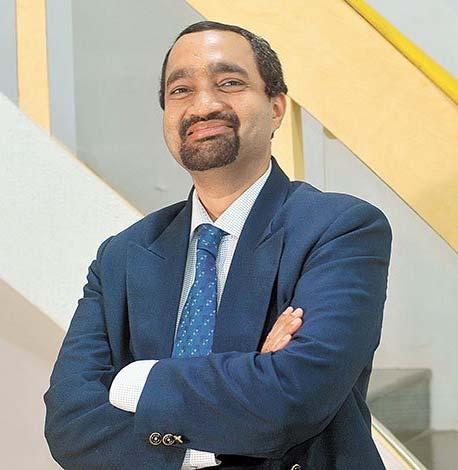
pricing and credit yields. Operating expenses increased 15% to Rs 418 crore, in line with business growth and investments in infrastructure and technology. Operating profit rose 21% to Rs 451 crore, bolstered by higher fee income and treasury gains. Asset quality remained stable; gross NPA decreased to Rs 1,617 crore, with the gross NPA ratio improving to 2.99% from 3.88%, while net NPA ratios fell to 1.20%, reflecting tight credit control and recovery efforts. Dr Kamakodi’s leadership emphasized digital banking expansion, process optimization, and deepening of customer relationships, which contributed to improved operational efficiency and resilience. Despite macroeconomic uncertainties, City Union Bank is optimistic about maintaining solid growth, enhancing profitability, and further improving asset quality over the coming quarters, backed by strategic initiatives and prudent risk management.


Brigade Enterprises, led by its Executive Chairman MR Jaishankar, began FY26 on a strong note, with its residential business driving a robust 18.9% year-on-year revenue increase to Rs 1,281 crore in Q1. Net profit surged 95% versus last year to Rs 158 crore, buoyed by new launches and strong sales across Bengaluru, Chennai, and Hyderabad. EBITDA for the quarter reached Rs 103 crore, a 10% year-on-year improvement, supported by expansion in the office segment and higher sales realization per square foot. Sales bookings rose to Rs 1,118 crore, despite a drop in sales volumes, as realisation per square foot climbed 24% to Rs 11,782, reflecting resilient demand in the housing market. However, there were headwinds, like the quarter-over-quarter revenue and profit declines due to seasonal factors and delayed launches. Shankar’s leadership has focused on pipeline expansion and land bank growth, enabling Brigade to capitalize on strategic opportunities and offset market fluctuations. Other challenges included rising costs and competition from new entrants, but the firm’s diversified project portfolio and strong foothold in South India continue to bolster its performance. The future outlook remains optimistic as Brigade Enterprises ramps up launches in residential and commercial segments, further leveraging its expertise and market reputation to sustain momentum through FY26.
CSB Bank, steered by its MD & CEO Pralay Mondal, logged a steady Q1 FY26 despite headwinds from technology migration costs and margin pressure. The Thrissur-based bank saw net profit rise of 5% year-on-year to Rs 118 crore, reflecting solid growth in advances and deposits amid a challenging macroeconomic environment. Total deposits surged 20% to Rs 35,935 crore, while net advances expanded robustly by 31% to Rs 32,552 crore, largely boosted by a 36% jump in gold loans. Net interest income demonstrated a modest 5% increase to Rs 379 crore, although net interest margin compressed to 3.54% from last year’s 4.36%, impacted by elevated deposit costs and competitive pressures. The quarter featured a major transformational milestone with the bank successfully completing its Core Banking System (CBS) migration and rollout of more than 50 surround systems, aimed at enhancing operational capabilities and customer experience. Gross NPAs were slightly higher at 1.84%, with net NPAs marginally lower at 0.66%, reflecting prudent risk management despite sectorwide asset quality concerns. Costs rose due to the tech overhaul and increased operational efforts, but prioritizing stabilization and performance enhancement remains paramount for the leadership. Pralay Mondal emphasized the bank’s cautious yet scalable growth strategy, particularly in gold loans, SME, and wholesale segments, ensuring resilience in an evolving financial landscape. The outlook for CSB Bank is positive, with ambitions to restore margins to around 4% by fiscal year-end while consolidating advances and deposits growth. Focused investments in tech and customer-centric initiatives position CSB Bank well to capitalize on opportunities ahead.
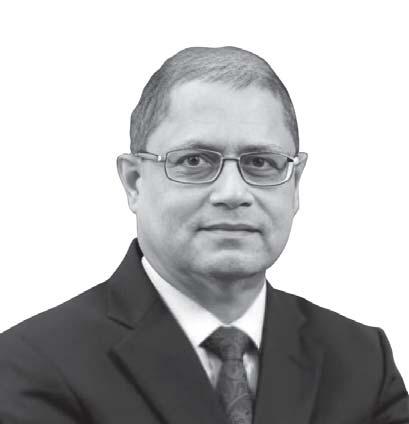
Garden Reach Shipbuilders & Engineers (GRSE), under Chairman & MD Commander PR Hari, IN (Retd), kicked off FY26 with impressive financial results reflecting sharp growth in revenues and profitability. The Kolkatabased defence shipbuilder reported total income of Rs 1,382 crore for Q1 FY26, a 28% increase yearon-year, driven by heightened execution of naval and coast guard projects. Revenue from operations rose 30% to Rs 1,310 crore, supported by the maturing stages of several production programs and expedited deliveries. EBITDA improved strongly by 42% to Rs 184 crore, underpinning enhanced operational efficiencies and effective cost control. Profit before tax surged 45% to Rs 167 crore, while profit after tax grew 38% to Rs 120 crore, highlighting the company’s improving bottom-line health and sustained financial discipline. EPS rose to Rs 10.49 versus Rs 7.61 in the prior year period. CMDE Hari noted that the strong start to FY26 lends confidence toward maintaining growth momentum, with a robust project pipeline and strategic investments in R&D and capacity expansion. While challenges remain in raw material sourcing and project timelines, GRSE’s leadership has effectively navigated these through prioritizing advanced manufacturing techniques and closer client collaboration. This positions GRSE well for continued scale-up in defence shipbuilding, tapping into both domestic and export opportunities in the coming years.

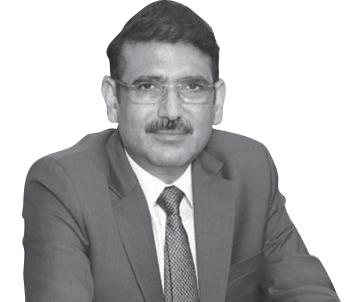
Indian Railway Finance Corporation (IRFC), led by Chairman and MD Manoj Kumar Dubey, delivered its strongest-ever Q1 FY26 results, solidifying its crucial role as India’s premier railway financier. Total revenue rose 2.2% year-onyear to Rs 6,918 crore, reflecting continued growth in loan disbursements to the Indian Railways and an expanding funding portfolio. Net profit for the quarter jumped 11% to Rs 1,746 crore, up from Rs 1,577 crore last year, driven by robust operational efficiency and a steady rise in interest income. IRFC’s Net Interest Margin improved to 1.51%, marking progress in capital allocation and cost control despite a challenging interest rate environment. The company sanctioned new projects worth Rs 25,000 crore and disbursed Rs 3,000 crore, with an ambitious target to sanction Rs 60,000 crore and disburse Rs 30,000 crore for the full fiscal year. IRFC is now pursuing a strategy dubbed ‘IRFC 2.0’ focused on expanding its client base beyond Indian Railways to related ecosystem entities and aiming to cross Rs 5 lakh crore in assets under management by FY27. The balance sheet remains robust, with no reported NPAs, and IRFC continues to maintain strong investment-grade ratings. CMD Dubey’s leadership has prioritized diversification into higher-margin segments and cautious risk management, ensuring IRFC sustains profitability while supporting India’s massive infrastructure expansion goals. The company’s ability to navigate interest rate volatility and inflation pressures highlights its systems and financial discipline. With its strategic growth framework, IRFC is well-positioned to remain a cornerstone in national railway financing, capitalizing on increased capex and government support in the coming years.
Embassy Developments Ltd (EDL) has reported a mixed performance in its Q1 FY26 results, with strong revenue momentum tempered by profit pressures. Consolidated revenue rose by 39% year-on-year to Rs 680.92 crore, reflecting the scaling up of residential and commercial projects after the company’s merger with Indiabulls Real Estate. Chairman Jitu Virwani, who took charge of the unified entity earlier this year, has set a decisive tone for the business, steering it with a blend of long-term vision and pragmatic expansion. The company has also laid out ambitious targets for FY26, aiming to deliver Rs 22,000 crore in Gross Development Value, of which a large portion will come from the residential segment. This forward-looking strategy suggests confidence in India’s real estate growth story and in Embassy’s ability to capture market share. However, profitability remains an area of concern. Operating profit for the quarter stood at Rs 173.55 crore, down nearly 60% compared with the previous quarter and modestly lower than the same period last year. Profit Before Tax came in at a negative Rs 164.80 crore, despite improving by more than 100% year-on-year, highlighting the volatility inherent in the post-merger transition. And bottomline slipped to a loss of Rs 165.85 crore, largely attributed to integration costs and front-loaded investments in new projects. Despite these challenges, the overall narrative is one of cautious optimism. Embassy’s sharp revenue growth and bold expansion targets provide a strong foundation, while its leadership under realty veteran Jitu Virwani signals steady guidance through a period of transition.
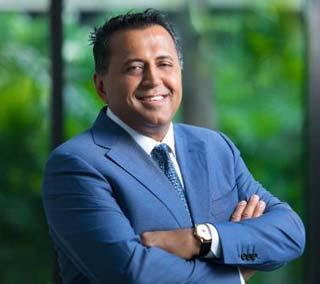
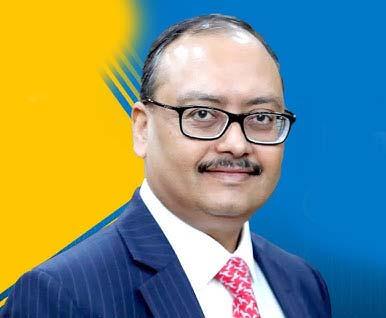
Bank of India, helmed by MD & CEO Rajneesh Karnatak, posted a solid performance in Q1 FY26, highlighted by a 32% year-on-year jump in net profit to Rs 2,252 crore. The quarter showcased strong growth in global advances, which rose by 12%, driven by a 20% surge in retail loans and 17% growth in MSME lending. Deposits kept pace, rising 9.07% year-on-year, as the bank’s strategies in the retail and MSME spaces showed results. EBITDA and operating profit climbed 9% to Rs 4,009 crore, buoyed by broad-based improvement in business volumes and healthy non-interest income. However, net interest income contracted by 3.3%, reflecting margin pressures amid rising deposit costs and slower credit repricing. The bank made significant strides in asset quality, with its gross NPA ratio declining to 2.92%, indicative of enhanced credit discipline and targeted recoveries. The capital adequacy ratio improved, standing strong at 17.39%. Despite a softer NII, the overall profitability was supported by treasury gains, improved asset quality, and cost discipline. Major challenges remain around sustaining margins and driving consistent deposit growth in a competitive banking landscape. Rajneesh Karnatak’s hands-on leadership is evident in the bank’s investments in digitization, recovery initiatives, and sharper focus on retail and MSME segments, helping Bank of India overcome regulatory and market headwinds. With a strategic outlook, Bank of India aims to increase advances by 12–13% and deposits by 10–11% in FY26, showcasing confidence in its ability to deliver on growth targets despite short-term pressures.
Keystone Realtors, led by its Chairman & MD Boman R Irani, faced a challenging Q1 FY26 with net profit down 36.3% year-on-year to Rs 16.33 crore from Rs 25.65 crore in Q1 FY25. Revenue slipped 34% to Rs 288.64 crore due to lower project completions and deferred revenue recognition, even as operational expenses decreased 32% year-onyear to Rs 270.73 crore. EBITDA for the quarter dipped to Rs 29 crore from Rs 58.2 crore last year, reflecting reduced throughput and high upfront costs for new launches. Despite this, the business showed resilience in sales performance with pre-sales jumping 75% yearon-year to Rs 1,068 crore, and collections rising to Rs 575 crore, a 19% increase year-on-year. Three new projects launched in Q1 FY26 brought a gross development value (GDV) of Rs 3,967 crore, achieving 57% of full-year guidance and surpassing last year’s launch value by over 2x. Additionally, the company added cluster redevelopment and luxury projects in the high-value Mumbai Metropolitan Region, pushing total business development for the quarter to a GDV of Rs 7,727 crore, which is over 1.25 times its annual guidance. CMD Boman R Irani Irani attributes the profit dip mainly to deferred revenue from ongoing projects; with income recognition occuring only upon delivery under prevailing accounting norms. Gross debt stood at Rs 304 crore with a debt-to-equity ratio of 0.11, while net debt remains nil, underscoring continued financial discipline. With a healthy balance sheet, asset-light model, and strong new pipeline, Keystone expects a rebound in earnings as new projects begin generating revenue in H2 FY26, sustaining an optimistic mediumterm outlook.


Jyothy Labs, led by MD & CEO MR Jyothy, reported a subdued Q1 FY26 with modest revenue growth balanced by margin compression and profit decline. The company posted revenue from operations of Rs 751 crore, a 1.35% increase year-on-year, supported by stable performance across its core categories of fabric care, dishwashing, and personal care. Profit after tax for the quarter fell 4.95% to Rs 96.8 crore, reflecting pressure from higher raw material costs and elevated advertising expenditure as the company sought to maintain its market presence. EBITDA was impacted by inflationary input prices, and total expenses rose alongside expanded marketing investments aimed at boosting volume growth and defending market share. Segment-level performance remained mixed, with fabric care showing resilience but home care and dishwashing battling subdued demand in some regions. Share price volatility persisted, with Jyothy Labs’ stock declining over the past twelve months as broader consumer sector sentiment softened. MR Jyothy’s leadership continues to emphasize brand-building, operational efficiencies, and product innovation to offset commodity cost headwinds. The sale of the company’s stake in Jyothy Kallol Bangladesh Limited resulted in a onetime loss, adding to quarterly profit pressures. With no critical debt issues, the business retains flexibility to pursue long-term growth investments and expansion of distribution. The outlook remains cautiously optimistic, as Jyothy Labs invests in new product launches and supply chain enhancements to drive future shareholder value in a competitive FMCG landscape.

Karnataka Bank’s Q1 FY26 reflected a mixed performance, with profitability down but operational resilience improving. The bank has a new MD & CEO in Raghavendra S Bhat, who joined post Q1, and is a former veteran of Karnataka Bank itself who had retired as its Chief Operating Officer earlier. Net profit for the quarter fell 27% year-on-year to Rs 292 crore, primarily due to lower treasury earnings and higher provisions. Aggregate deposits increased 3% to Rs 1,03,242 crore, while aggregate business grew marginally to Rs 1,77,509 crore. Gross advances stood at Rs 74,267 crore, representing a slight dip versus last year, as cautious lending and risk containment took precedence. Net interest income was Rs 756 crore, supported by stable core margins and prudent credit deployment. Gross NPAs improved to 3.46% from 3.54% last year, and net NPAs declined to 1.44% from 1.66%, marking progress in asset quality and recovery initiatives. EBITDA and operating profit remained steady despite inflation and cost pressures.
Raghavendra S Bhat highlighted investments in infrastructure and digital processes made last fiscal year as foundational for future growth and efficiency, promising improved results as these investments mature. Major challenges remain around achieving higher loan growth and expanding low-cost deposits in a competitive market. Under its new MD & CEO Raghavendra S Bhat’s guidance, Karnataka Bank continues to prioritize retail, agriculture, and MSME lending while driving process innovation. With disciplined risk management and enhanced digital capability, the bank is confident of a stronger operational showing over the next few quarters, with a renewed focus on profitability and growth.
EI Industries, led by Chairman and Managing Director Anil Gupta, registered robust results in Q1 FY26, reflecting its ongoing expansion and leadership in the cables and wires sector. The company posted a stellar 25.44% year-on-year revenue growth, reaching Rs 2,590.32 crore, benefiting from 32% growth in the core cables and wires segment and solid export momentum, with export revenue advancing by 61% for the quarter. EBITDA rose 28% to Rs 297.63 crore, with EBITDA margin improving to 11.49% compared to 11.25% last year, driven by operational efficiencies and higher sales volumes. Net profit jumped 30.28% year-on-year to Rs 195.75 crore, and PAT margin expanded to 7.56%, demonstrating healthy conversion of sales into bottomline. KEI’s domestic institutional cable sales grew 24%, while distribution network of B2C sales increased 22% yearon-year, reflecting robust demand from both industrial projects and retail markets. Operating expenses, however, tracked higher in line with revenue growth as material and employee costs were up, while the EPC projects segment saw a significant decline of 56% amid the company’s increased strategic focus on core product lines. CMD Anil Gupta highlighted the commissioning of Phase 1 of its major Sanand manufacturing facility, which is set to boost capacity and address anticipated demand surges, especially in EHV cables and exports by FY27. KEI countered competitive pressure by expanding its dealer base to over 2,094 active channels and streamlined supply chain operations. KEI maintains a strong order book of Rs 3,921 crore and projects a revenue CAGR of 20% over the next two to three years post the Sanand expansion. With its diversified order book, strategic investments, and broadening market footprint, KEI Industries remains well-positioned to capitalize on India’s infrastructure and industrial growth story.
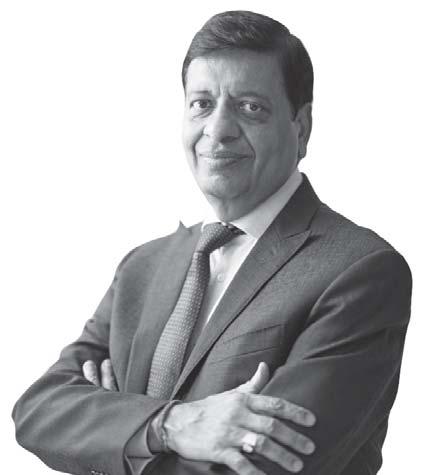

arur Vysya Bank, under MD & CEO
B Ramesh Babu, delivered a robust Q1 FY26 with all-round improvements in profit, asset quality, and business size. Net profit increased 13.5% year-on-year to Rs 521 crore, compared to Rs 459 crore in Q1 FY25. Total income rose 12.8% yearon-year, reaching Rs 3,016 crore as of June 30, 2025, underpinned by strong growth in advances and healthy interest earnings. Net interest income (NII) expanded 5.1% to Rs 1,080 crore, while net interest margin (NIM) for the quarter stood at 3.86%, slightly lower than last year’s 4.14% due to increased deposit costs. Karur Vysya’s total business volume reached Rs 1,96,024 crore, marking a 15.27% increase from Q1 last year, with total deposits crossing the Rs 1 lakh crore milestone at Rs 1,06,650 crore, which was up by 15.49% YoY. Advances grew 15.01% YoY to Rs 89,374 crore, showing solid credit growth across retail, MSME, and corporate segments. Commission and fee-based income also climbed 5% to Rs 251 crore, supporting the bank’s revenue streams. Operating expenses increased to Rs 721 crore, with the cost-to-income ratio stable at 47.24%. Asset quality metrics improved distinctly, as gross NPA fell to 0.66% from 1.32% last year, while net NPA declined to 0.19%. The provision coverage ratio edged up to 96.76%. Capital adequacy ratio under Basel III rose to a robust 17.36%, supporting future growth plans. CEO Ramesh Babu’s leadership continues to drive digital innovation, operational discipline, and customer base expansion to build long-term resilience and sustained profitability. The outlook remains positive as Karur Vysya Bank leverages its improved financial position to pursue prudent growth and sector leadership in FY26.
Life Insurance Corporation of India (LIC), under the guidance of CEO & MD R. Doraiswamy, delivered a resilient Q1 FY26 with steady growth across all metrics despite a challenging macro environment. Net profit rose 5% year-on-year to Rs 10,986 crore, up from Rs 10,461 crore in Q1 FY25, as improved product mix and greater efficiency drove profitability. Total income for the quarter expanded to Rs 2,22,864 crore from Rs 2,10,910 crore a year ago, on the back of stable growth in new business premiums and strong renewal collections. Net premium income rose 4.8% year-on-year to Rs 1,19,200 crore, underlining LIC’s dominance with a 63.5% market share by first-year premium income. The Value of New Business (VNB), a key profitability metric, surged 20.7% to Rs 1,944 crore. Assets Under Management (AUM) also increased 6.5% from Rs 53.6 lakh crore to Rs 57.05 lakh crore, affirming LIC’s industry-leading scale. Despite the positive top-line and bottom-line growth, individual policy sales in Q1 declined by 15% YoY, suggesting some pressure on volume as the product mix shifted toward more profitable segments. LIC continued to optimize its balance sheet and boost bancassurance channel performance, with bancassurance and non-par product business reaching new highs. CEO R. Doraiswamy emphasized continued digital initiatives, channel partner expansion, and new product launches tailored to shifting customer preferences. With a strategy targeting double-digit profit growth for the full year, LIC remains confident in its ability to further cement its dominance in the Indian life insurance sector and deliver long-term value.
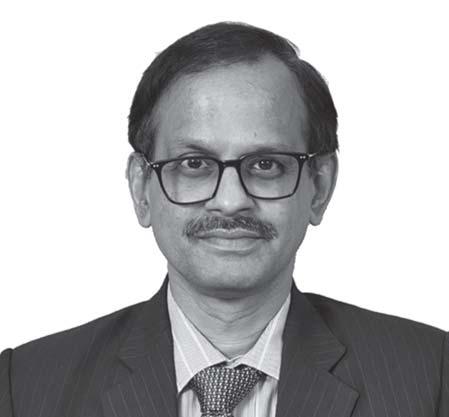
anappuram Finance, led by Chairman & MD VP Nandakumar and its new CEO Deepak Reddy who took charge post Q1 on August 1st, achieved a 10% YoY revenue raise in its mainstay of gold loans to Rs 1,904 crore. The gold loan segment remained profitable too with profit before tax in gold loans coming in at Rs 539 crore, but was down from Rs 619 crore last year. But reflecting the nationwide and sectorwide slump in microfinance, Manappuram’s microfinance revenue dropped over 53% to Rs 361 crore, sharply impacting profit. The microfinance segment swung to a PBT loss of Rs 437 crore versus a profit of Rs 775 crore a year ago. This resulted in a steep setback in Q1 FY26 as consolidated net profit slumped 75% year-on-year to Rs 138 crore from Rs 555 crore a year ago. Total revenue declined 9% to Rs 2,262 crore, with solid gains in the gold loan segment cushioning a significant contraction in microfinance and vehicle lending. While this dramatic reversal might seem to be a reflection of heightened delinquencies and provisioning in the microfinance book, it is more likely to be an impact of an accelerated one-off cleaning up of the microfinance book post the coming in of Bain Capital Asia as a co-promoter. Bain had invested Rs 4385 crore for acquiring an 18% stake in Manappuram Finance, earlier this year. Asset quality pressure led to higher credit costs and a compressed bottom line. However, the Manappuram Board has responded by announcing an interim dividend of Rs 0.50 per share, affirming confidence in the company’s underlying financial resilience. CMD VP Nandakumar’s leadership is now focused on recalibrating credit processes in microfinance, expanding the gold loan network, and restoring overall profitability. Manappuram’s balance sheet remains adequately capitalized, and the group continues to diversify funding and digitize its distribution model. Management expects a gradual improvement in profitability as the company stabilizes the microfinance vertical and leverages robust gold loan demand through FY26.


azagon Dock Shipbuilders, under the stewardship of its Chairman & MD Capt. Jagmohan, IN (Retd.), reported Q1 FY26 results marked by strong revenue but a sharp profitability decline. Total revenue grew 11.4% year-on-year to Rs 2,626 crore, up from Rs 2,357 crore in the corresponding quarter last year, thanks to solid execution of defence contracts and forward movement in shipbuilding orders. However, profit after tax dropped 35% YoY to Rs 452 crore, compared to Rs 696 crore in Q1 FY25, which is a steeper contraction than what most analysts had forecast. This steep fall in profit could be attributed to negative operating leverage and increased input costs, as EBITDA plunged 53% to Rs 302 crore and margins fell from 27.2% to 11.5% quarter-on-quarter. This reflects cost escalation in key projects, timing mismatches in project deliveries, and possible absorption of fixed costs over a larger base. Despite the margin squeeze, Mazagon Dock’s order book and revenue growth underline longterm demand from Indian Navy and Coast Guard contracts. CMD Capt. Jagmohan has prioritized ramping up supply chain efficiency, cost optimization, and timely execution. Looking ahead, Mazagon Dock’s leadership remains focused on enhancing operational efficiencies, executing a robust order pipeline, and regaining profitability as raw material costs and project cycles normalize in coming quarters. The ongoing Q2 would be the first full quarter under the new CMD.
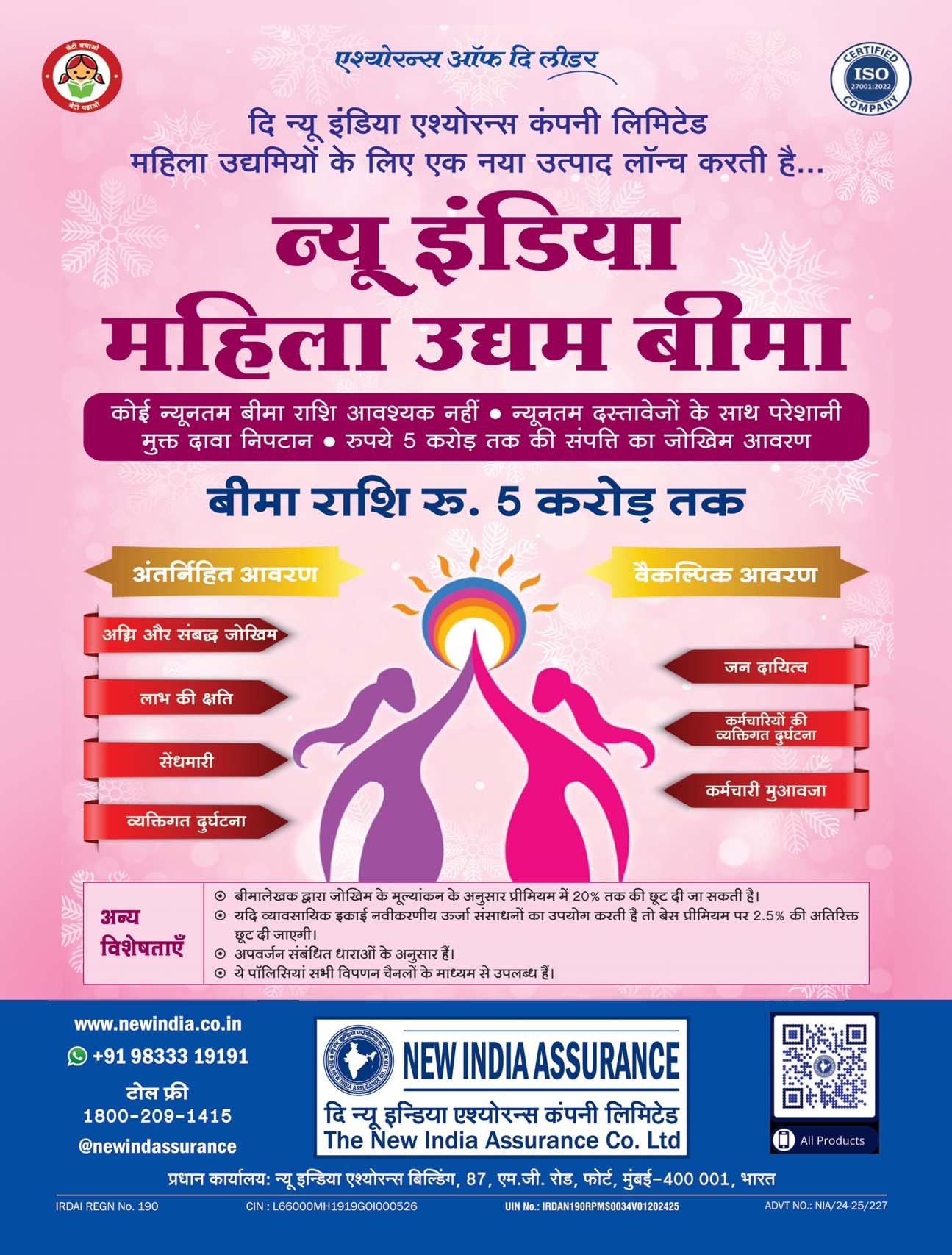
THE IPHONE 17 SERIES IS OUT, AND AS IMPRESSIVE AS THE IPHONE 17 AND IPHONE 17 PRO MAY BE, THIS YEAR’S HEADTURNER IS THE IPHONE AIR. WITH A SLIM DESIGN THAT MAKES PEOPLE AROUND YOU SAY, “WOW,” IT’S UNLIKE ANY IPHONE WE’VE SEEN BEFORE. BUT THE WIDE WORLD OF ANDROID HAS SOME EXCELLENT IPHONE AIR ALTERNATIVES.
At just 5.6mm thick and weighing 165g, the iPhone Air is a breeze to hold, making it a very comfortable smartphone to use throughout the day. More than anything else, it is an excellent recommendation for people who want to make a style statement, spec sheet be damned.
If you’re looking at the other side and thinking the grass is greener, know that Android phones can turn heads too, be it through style or much better tech. Here are some great Android phones you can buy instead if you want to make an iPhone Air-like statement.
The iPhone Air isn’t the only impressively thin phone on the block; Samsung edged out Apple by releasing its own thin phone earlier in the year.
The Samsung Galaxy S25 Edge is just as thin as the iPhone Air (a 0.2mm difference) and just as light (about 2g lighter), so you’ll still be turning heads while also running Android, your favorite OS.
In fact, the Galaxy S25 Edge is better than the iPhone Air. For starters, you get a

slightly bigger display, a more versatile rear camera setup with an ultrawide camera, a second speaker at the bottom for stereo output, faster USB speeds, and slightly faster charging. The Galaxy S25 Edge also has a physically larger battery in its svelte body, though iOS optimizations make direct battery capacity comparisons redundant. One UI 8 on the Galaxy S25 Edge runs incredibly, and you get many more AI features right away than Apple intends to deliver in the near future.
While all these physical traits make the Galaxy S25 Edge a great competitor against the iPhone Air, its pricing clinches it the trophy. While the iPhone Air starts at $999, the Galaxy S25 Edge started at $1,099 at launch, but you can routinely find it discounted to as low as $700. That’s $300 back in your pocket for just as much wow factor, if not more.
Yes, the Galaxy S25 Edge is not perfect. The battery life is mediocre, the thermals are poor, there is no telephoto camera, and I would have loved some faster charging. However, all of these limitations stay true for the iPhone Air too. People buying these thin phones know their limits, yet choose style over the spec sheet — and that’s okay. Android is about choice after all.
The Galaxy Z Flip 7 with its cover screen on.
If you are looking for a thin and light phone that can impress people, Samsung has another phone in store for
you. The Galaxy Z Flip 7 looks like a regular smartphone, but it flips shut to become a super-compact foldable that easily slides into pockets and purses.
When unfolded, the Galaxy Z Flip 7 is just 6.5mm thin (vs 5.6mm on the iPhone Air), and you’ll barely notice the 1.1mm difference. What you will notice is the smaller size when folded shut and the larger screen size when folded open — it’s the best of both portability and usability. The cherry on top is that you don’t have to open the phone to use it, as you can do most phone things on the smaller cover display.
The Galaxy Z Flip 7 also pips the iPhone Air in the camera department. It gets a very capable 50MP primary camera and a 12MP ultrawide camera on the rear. Since the phone can be used when shut, you can use the rear cameras for incredibly detailed selfies. If you’d prefer to open the phone up, there’s another 10MP camera inside. The Galaxy Z Flip 7 also has a significantly larger 4,300mAh battery and slightly faster charging with faster USB speeds.
The Galaxy Z Flip 7 launched at $1,099 for its 256GB variant. However, you can routinely get it for as low as $950, undercutting the iPhone Air’s launch price. This makes the Galaxy Z Flip 7 the overall winner, hands down.
The Galaxy Z Flip 7 offers some of Samsung’s most impressive flip phone hardware ever, featuring a 4.1-inch edge-to-edge cover screen and a thickness of just 13.7mm when closed. It also has a larger 6.9-inch inner display, good general performance, and seven years of Android updates.

If you want to make an even bolder style statement than the iPhone Air and would love some bling along the way, Motorola recently launched a special edition of the Razr (2025). Called “The Brilliant Collection,” this is a flip phone laden with Swarovski crystals. The phone comes in Pantone’s “Ice Melt” shade, coupled with a leather-like material on the bottom half of its back. Over 30 Swarovski crystals are placed across the lattice on the back, three more on the front for good measure, and one more on the hinge.
For even more bling, the Razr (2025) in The Brilliant Collection comes with the Moto Buds Loop open-style earbuds. The earbuds have the same Ice Melt hue, and there are Swarovski crystals along the loop section.
Much like the Galaxy Z Flip 7, the Motorola Razr (2025) is a flip-style foldable. The specifications aren’t overkill but remain practical enough to serve most needs. The standard variant comes in at $600, but The Brilliant Collection will set you back $1,000, the same as the iPhone Air.
One can argue that the Razr (2025) in its Swarovski avatar is not the best value, especially since the much better Motorola Razr Plus (2025) can be yours for $850 in a unique Pantone Mocha Mousse color, sans the Swarovski bling and the earbuds. However, Swarovski has its own appeal, and the Moto Buds Loop earbuds help sweeten the deal. Motorola also said that the phone will be available in limited quantities, making it perfect for those who prefer to stand out from the crowd.
The primary theme for the iPhone Air is
its thinness, and it’s actually Samsung that doubled down on thinness this year to give us some incredible phones. The Galaxy Z Fold 7 marks its presence as it is even thinner than the iPhone Air, at just 4.2mm when unfolded. When you fold this book-style foldable, you get a more conventional 8.9mm, but most users will still be in awe of the piece of technology in their hands. For context, the iPhone Air is 11.32mm thick when you count its camera island, so the Fold 7 remains the thinner phone if you consider the phone as a whole.
At 215g, the Galaxy Z Fold 7 is a fair bit heavier than the iPhone Air, but not so much heavier than a conventional glass-slab smartphone. When folded shut, the Fold 7’s cover screen can be used as a regular-sized smartphone. When open, you get an expansive 8inch display, akin to a tablet in your pocket.
The Galaxy Z Fold 7 is a proper flagship, so you get all the overkill specifications that you’d expect with the premium price tag. There’s very little to complain about here, even against the top-of-theline Android flagships, and there’s nothing really that the iPhone Air can do better than the Galaxy Z Fold 7. Samsung Galaxy Z Fold 7 in Mint standing on table in a V formation
The Galaxy Z Fold 7 is expensive at its $2,000 starting price, no doubt, and it might even be a bit too expensive for people considering the iPhone Air. But if grabbing attention is your motto and money is no matter, then the Galaxy Z Fold 7 is one of the best pieces of tech you can do so with, at least until Samsung’s tri-fold comes along.
The Samsung Galaxy Z Fold 7 offers an 8-inch OLED screen, a 200MP camera, the Snapdragon 8 Elite for Galaxy chipset, and a 4,400mAh battery. The Galaxy AI experience is baked in, offering tools across the camera, Circle to Search, and much more. Best of all, Samsung continues to evolve its foldable hinge assembly, promising reduced visibility of the crease.
The iPhone Air’s claim to fame is being impressively thin, while the OnePlus 13‘s is that it packs an impressive spec
sheet while still being a very manageable smartphone. It’s not a super slim phone, but it features some of the best spec combinations on Android phones in the US at a great price without feeling like an absolute brick in your hand.
The OnePlus 13 is 8.5mm thin and weighs 210g, which is thinner and lighter than several other flagships of its caliber. It also features a larger 6.82-inch display that is excellent to use. It also packs the best camera setup on this list, featuring three 50MP cameras on the rear and a 32MP front camera. It delivers both quality and versatility, as you have a dedicated ultrawide and telephoto camera.
At 6,000mAh, the OnePlus 13 also features the biggest battery and best battery life among phones on this list, easily lasting a day of heavy use and about one and a half to two days of use on lighter loads. When you run out of battery, you get 100W of wired charging that tops up 50% of the battery in just about 13 minutes. There’s also 50W wireless fast charging with the proprietary wireless charger. Looks are subjective, but I also like how the OnePlus 13 looks. It isn’t an absolute headturner like the iPhone Air, but it holds enough identity and character of its own, especially in the uniquely blue Midnight Ocean color.
Sealing the deal in OnePlus 13’s favor is its $900 launch price tag, which goes down to $800 frequently on sale, and which can be further sweetened with a $100 trade-in bonus when trading in any device in any condition. If you are okay with a conventional Android flagship that packs a tight punch while still looking great, the OnePlus 13 should be your choice, and that $700 effective price is tough to argue against.

SCIENCE SAYS STOP ASKING ‘WILL THIS MAKE ME HAPPY?’ AND START ASKING YOURSELF THIS INSTEAD. PREDICTING WHETHER THE OUTCOME OF A DECISION WILL MAKE YOU HAPPY IS OFTEN IMPOSSIBLE.
PREDICTING A DECISION’S IMPACT ON YOU IS NOT.

appiness is a result. Happiness is also a driver; research shows we work harder when we’re happier.
So when you need to make a major decision - to start a business, change careers, enter into a relationship, try to accomplish a huge goal, etc. - it’s natural to ask yourself a simple question: “Will this make me happy?”
Makes sense, except it doesn’t. Where major personal decisions are concerned, most people are terrible at predicting what will make them happy, if only because there’s no way to really know whether something will make you happy until you do that something.
Take me: I wanted to be a plant manager, and spent nearly 20 years working to achieve that goal only to realize, once I got there, that I didn’t enjoy it. It didn’t make me unhappy, but it also didn’t make me happy.
And we also tend to be terrible at using happiness as a filter for smaller decisions. Cutting a corner on a property renovation project may feel good in the moment, but I feel bad about myself later. Skipping a workout may feel good in the moment, but it doesn’t help me be as fit and healthy as I want.
That’s why asking yourself, “Will this make me happy?” isn’t a great way to make large or small decisions.
Instead, Jungian psychoanalyst James Hollis, the author of What Matters Most: Living a More Considered Life, recommends asking yourself a different question:
Ask yourself of every dilemma, every choice, every relationship, every commitment, or every failure to commit: “Does this choice diminish me, or enlarge me?”
Say you’re trying to decide whether to start a business or a side hustle. It’s impossible to predict whether being an entrepreneur will make you happy; you have to do it to really know.
Whether it will enlarge or diminish you is easy to predict. Start your own business and you’ll naturally gain new skills. You’ll meet new people. You’ll gain new perspectives. You’ll learn things, especially about yourself.
Even if your business isn’t particularly fun, and even if it fails, the journey will absolutely enlarge you.
Or say you’re trying to decide whether to embark on achieving a personal goal. Plenty of people describe feeling empty after achieving a major life goal; crossing
EVEN IF YOUR BUSINESS ISN’T PARTICULARLY FUN, AND EVEN IF IT FAILS, THE JOURNEY WILL ABSOLUTELY ENLARGE YOU.
“finish a triathlon” off your bucket list might not make you happy.
But training to do a triathlon will definitely enlarge you. You’ll build greater self-discipline and perseverance. You’ll improve your health and fitness. You’ll build relationships with people on the same journey. You’ll learn things, especially about yourself.
Even if the happiness you feel from crossing the finish line doesn’t last long, the journey will enlarge you.
As for being diminished? If you’re a leader, choosing to ignore an interpersonal conflict between employees might “feel” good in the moment (avoiding conflict usually brings a sigh of relief), but deciding to ignore the problem reduces your effectiveness as a boss and may diminish how you view yourself as a leader.
Or deciding to take a business shortcut: While the near-term results might make you happy, the prospects for your business could be poorer over the long term. And taking that shortcut might diminish how you view yourself as an entrepreneur. (If I decide to take a shortcut on a renovation project, it definitely diminishes how I feel about myself as a craftsperson.)
Try it. Whenever you have a choice, don’t ask yourself if it will make you happy. Ask yourself, “Does this choice diminish me, or enlarge me?”
Then, whenever possible, choose enlargement. While it might not be fun, especially in the moment, to push past your comfort zone, the only way to grow — the only way to enlarge yourself — is to do things that make you a little uncomfortable.
But oddly enough, since success and fulfillment tend to go hand-in-hand, you’ll likely find the result leaves you feeling happier as well.
Because the closer you get to the person you aspire deep inside to be — the more your self-image matches reality — the happier you will be.
(Credit: Jeff Haden for Inc.)
EXPERTS CAUTION THAT THIS FEES CAN HAVE A SIGNIFICANT IMPACT ON LONG-TERM RETURNS, ESPECIALLY WHEN COMPOUNDED OVER DECADES.
magine two friends, Ramesh and Neha, who each invested Rs 10,00,000 in mutual funds 20 years ago. Ramesh chose a fund with a 2 per cent expense ratio, while Neha opted for one with a 0.5 per cent ratio. Both funds delivered the same gross return of 10 per cent annually. Today, Neha’s portfolio is worth around ~62,00,000, about ~15,00,000 more than Ramesh’s. A huge difference, right. Actually, expense ratio fees nibbled into Ramesh’s wealth over the course of 20 years.
This quiet wealth killer is the expense ratio, the annual fee charged by mutual funds. For most mutual fund investors, expense ratios are an often-overlooked detail. But experts warn that these fees can have a significant impact on longterm returns, especially when compounded over decades.
“Expense ratios are the annual fees that mutual funds charge for managing your money. These may range from 0.2 per cent to around 2 per cent,” says Arjun Guha Thakurta, executive director at Anand Rathi Wealth. While passively managed index funds tend to have lower expense ratios (0.2 per cent-0.7 per cent), actively managed funds can go as high as 2 per cent.
“Over the long term, even a 1 per cent difference in costs can erode wealth substantially. If a fund consistently delivers returns above its benchmark, a higher expense ratio may be justified. Otherwise, that extra 1 per cent is simply a drag on your wealth,” Thakurta explains.
Navy Vijay Ramavat, managing director at Indira Group, agrees. “Expense ratios are deducted daily from fund assets, reducing NAV and lowering returns. For example, a fund generating 10 per cent returns before expenses with a 2 per cent expense ratio delivers only 8 per cent net returns. Over 20 years, that small difference could result in

~267000 less wealth per ~1000000 invested, a 43.6 per cent difference in final accumulation,” he notes.
Should investors prioritise low-cost index funds to minimise expenses? Not always, Thakurta says. “In a developing market like India, small and midcap companies offer significant growth potential. Here, active funds, despite higher costs, may justify their fees if they generate consistent alpha.”
Ramavat suggests a balanced approach. “For core portfolio allocations, low-cost index funds can provide broad market exposure at minimal cost. Active funds can be used selectively in niche segments where managers have a proven ability to outperform.”
As a rule of thumb, expense ratios below 1 per cent for equity funds and 0.5 per cent for debt funds are considered low in India. Ratios above 1.5 per cent for equity and hybrid funds or 0.75 per cent for debt funds are on the higher side, says Thakurta.
SEBI also prescribes upper limits based on fund type and size, providing a
regulatory framework to assess reasonableness.
“Switching from regular to direct plans can shave off 0.3 per cent to 0.7 per cent annually, adding up to meaningful savings over time,” Ramavat points out.
He also recommends using a coresatellite portfolio, combining low-cost index funds for the bulk of investments with carefully chosen active funds in specialised areas. “Regular monitoring is critical. If a fund’s expense ratio increases without an improvement in performance, consider switching,” Ramavat adds. However, he cautions against hasty exits. “For existing holdings, weigh tax implications before making a move.”
Expense ratios may look like a small percentage, but their impact on compounding is huge. By making informed choices and ensuring that every rupee paid in fees delivers value, investors can significantly boost longterm wealth creation.
(Credit: Amit Kumar for Business Standard)
AA VERITABLE AVALANCHE OF INFLUENCERS, NEWS HEADLINES, AND WELL-MEANING FRIENDS AND FAMILY OFFER CONFLICTING ADVICE ON WELLNESS. BUT QUICK FIXES AND FADS MAY DO LITTLE FOR OUR HEALTH, AND SOME EVEN PROVE HARMFUL. INSTEAD, TRY TO WORK THESE HEALTHY HABITS INTO YOUR DAILY ROUTINES. IF YOU’RE A PARENT, SHARING AND MODELING THEM CAN HELP CHILDREN AND TEENS EMBRACE WELLNESS, TOO. SO, IF YOU’RE OVERWHELMED BY FADS AND HYPE AROUND WELLNESS, READ ON.
1) Bring Mindfulness Into Your Day 1) Bring Into Day 1) Bring Mindfulness Into Your Day 1) Bring Into Day 1) Bring Mindfulness Into Your Day
Mindfulness and meditation are overlapping techniques proven to ease stress, improve sleep, and enhance concentration. “Anxiety and stress are very common issues in my practice,” says Dr. Armand. Worrying too often about the past or future is rarely helpful. The too-frequent release of stress hormones affects our heart, brain, and sleep, all of which have downstream consequences for our health.
Practicing mindfulness - whether simply by appreciating birds and plants on a walk in green space, or using suitable apps anchors you in the present moment. This can calm anxiety, improve focus and concentration, and amp up positive feelings. When applied to eating, mindfulness may help with weight loss by encouraging people to slow down to savor meals.
Meditation knits together body and


mind by focusing on sensations, such as breathing, images, or a repeated word or phrase. One exercise that works equally well for adults and younger people is box breathing. The rhythmic pattern of breathing helps regulate the nervous system, reining in anxiety and stress, lowering heart rate and blood pressure, and boosting focus.
2) Prioritize Sleep 2) Prioritize 2) Prioritize Sleep 2) Prioritize 2) Prioritize Sleep
Sleeping poorly can leave you feeling awful - snappish, foggy-headed, slow moving - and take a toll on your health over time. By contrast, getting sufficient, restful sleep supports the immune system, helps control weight, and aids physical well-being, mental well-being, memory, judgment, and other cognitive functions. It may even extend longevity. But how much sleep do you need? That varies with age and other factors: most adults need at least seven hours per night, according to the Centers for Disease Control and Prevention. However, sleep quality (a measure of refreshing, uninterrupted sleep versus tossing and turning) may be more
important than nailing seven hours. And it’s worth noting that too much sleepnine hours or more in one analysis of multiple studies - is linked to higher risk for early deaths, too.
Be aware that sleep patterns and circadian rhythms that help rule sleep and wakefulness change over time. Good sleep hygiene can help. Tips include getting regular exercise, setting regular bedtime and wake-up times, avoiding caffeine in the afternoon and evening and large meals and alcohol before bedtime, and turning off screens at least 30 minutes before going to bed.
If you have trouble falling asleep, wake repeatedly at night, or often feel tired during the day, talk to your doctor about ways to improve your sleep. In some cases, sleep apnea, which can raise risk for many health issues, or another sleep disorder may be preventing restful sleep.
3) Eat Real, Whole Foods 3) Eat Real, Whole Foods 3) Eat Real, Whole Foods
Eat Real, Whole Foods
A wealth of evidence shows that diets rich in vegetables, fruits, legumes and pulses like lentils, peas, and beans, and minimally processed foods support longevity and vitality. Plant-based and plant-forward diets are better for our health: research links them to lower rates of heart disease, certain cancers, and chronic illnesses like diabetes and obesity. They’re better for the planet, too. When foods are processed, their health and nutritional value often decline, partly due to additives. “Industries are adding ingredients like excess salt, sugar,


artificial sweeteners, colorings, and other chemicals that may be unhealthy or trigger reactions in the brain to keep us craving more,” says Harvard doctor Dr. Wynne Armand.
4) Move More, Sit Less 4) More, Sit Less 4) Move More, Sit Less 4) More, Sit Less 4) More,
The hurry of life often short-circuits opportunities to be active. So, swap out the thought “What saves me time?” for a healthier one: “What keeps me mobile, flexible, and functioning well within my world?” Polishing off exercise requirements through a 30-minute block once daily is great, but you may reap even greater health and well-being benefits if you seek out ways to stay active throughout the day.
“Stop thinking about efficiency and think instead about pleasurable or creative ways to keep your body active,” suggests Dr. Armand. Combine exercise with work or pleasure: instead of meeting on Zoom, walk and talk. Instead of sitting with friends for a meal, socialize over coffee followed by a walk.
Of course, many people experience mobility challenges due to age, illness, or accident. Look for opportunities that suit your needs or move beyond your comfort zone, possibly through adaptive sports.
5) Protect your body from everyday 5) Protect body from toxins toxins toxins toxins toxins
Air pollution, microplastics, and forever chemicals known as PFAS (perfluoroalkyl and polyfluoroalkyl substances) are difficult to dodge in
modern life. Breathing in tiny particles (called particulate matter, or PM10, PM2.5, PM0.1) or ingesting microplastics and harmful chemicals affects your health in many ways.
For example, notes Dr. Armand, tiny pollutant or wildfire smoke particles travel deep into the lungs and may escape into the bloodstream, thus reaching tissues and organs throughout the body. This contributes to heart attacks, strokes, lung problems, and other health conditions. The use of gas stoves, which create nitrogen dioxide and release airborne PM2.5s, irritates lungs and is linked with higher risk for childhood asthma. Microplastics have been found in foods, water, cosmetics, and nearly everywhere in the human body. Their health impact is being investigated and may include raising risk for cancer, inflammatory bowel disease, and respiratory and vascular problems. These tips can help you reduce potentially harmful exposures at home: Use a water filter to reduce your

exposure to PFAS, microplastics, and other contaminants.
Swap out kitchen plastics with glass (such as inexpensive mason jars or glass food containers), stainless steel water bottles, and lead-free dinnerware.
Run a correctly-sized air purifier with a MERV 13 or higher filter when wildfire smoke or pollution affects air quality near you. Local news reports can help you understand when air quality is in an unhealthy range, particularly for people who are most vulnerable, such as children, older adults, people with lung disease, and people who work outdoors. Vent gas stoves when cooking. Opening windows can also help. Better still, cook as much as you can using electric or induction appliances.

People with prediabetes can significantly reduce their risk of progressing to diabetes by engaging in at least 150 minutes of moderate-intensity exercise per week, according to a study published online June 25, 2025, by Cardiovascular Diabetology–Endocrinology Reports. Researchers examined the health data of 130 prediabetic adults who participated in a cardiovascular risk reduction program. The program included consultations with specialists in internal medicine, nutrition, psychology, and physiotherapy. People were encouraged to make lifestyle changes, such as reducing their intake of simple carbohydrates, increasing fiber intake, exercising for at least 150 minutes per week, and aiming for weight loss of at least 7% if they were overweight or obese.
Q. I always feel cold even in
Q. I always feel cold even in feel cold in summer and it often interferes summer and often often with my quality of life. What my quality life. What quality life. might cause this? cause this?
A. Many people can feel cold while others around them are comfortable. There is nothing necessarily wrong with that, but I would suggest you visit your doctor. There are many possible reasons for feeling cold. For example: Low body weight. Both fat and muscle mass help keep the body warm. Muscle activity generates heat, and fat acts as insulation. If you have lost significant weight recently or have always been thin, you might be more sensitive to colder temperatures. Skipping meals. Some people get cold when they miss meals or consume too few calories. When this happens, the body naturally conserves energy and thus produces less heat.
(Credit: Francesca Coltrera, Editor, Harvard Health Blog) SEASONAL
IN THE HEART OF MYSURU, JSS ACADEMY OF HIGHER EDUCATION AND RESEARCH (JSS AHER) CONTINUES TO SCALE NEW HEIGHTS AS A LEADER IN HEALTHCARE EDUCATION, RESEARCH, AND COMMUNITY SERVICE. IN 2025, THE INSTITUTION STRENGTHENED ITS NATIONAL AND GLOBAL STANDING BY CLIMBING TO 21ST IN THE NIRF UNIVERSITIES CATEGORY AND 38TH OVERALL, WHILE ITS CONSTITUENT COLLEGES SECURED LEADING RANKS IN MEDICINE, DENTAL SCIENCES, AND PHARMACY. ON THE WORLD STAGE, JSS AHER ALSO EARNED THE 56TH

POSITION IN THE TIMES HIGHER EDUCATION (THE) IMPACT RANKINGS, REFLECTING ITS SUSTAINED COMMITMENT TO THE UNITED NATIONS’ SUSTAINABLE DEVELOPMENT GOALS. AT THE SAME TIME, THE UNIVERSITY HAS INVESTED IN CLINICAL EXCELLENCE, INAUGURATING ADVANCED FACILITIES SUCH AS THE KINEVO 900 ROBOTIC NEUROSURGICAL MICROSCOPE AT JSS HOSPITAL. CONVOCATIONS CELEBRATING HUNDREDS OF NEW GRADUATES, RESEARCH CONCLAVES IN INDIA AND ABROAD, AND THOUGHT LEADERSHIP ON THE FUTURE OF EDUCATION HAVE ADDED TO ITS VIBRANCY. THESE ACHIEVEMENTS UNFOLD UNDER THE VISIONARY GUIDANCE OF ITS CHANCELLOR HIS HOLINESS JAGADGURU SRI SHIVARATHRI DESHIKENDRA MAHASWAMIJI, WITH THE STRATEGIC LEADERSHIP OF DR. CG BETSURMATH (EXECUTIVE SECRETARY, JSS MVP), PRO-CHANCELLOR DR. B SURESH, VICE CHANCELLOR DR. H BASAVANA GOWDAPPA, AND REGISTRAR DR. B MANJUNATHA, WHO TOGETHER CONTINUE TO CHART A PATH OF GROWTH ROOTED IN INNOVATION, SERVICE, AND GLOBAL RELEVANCE.



Adefining highlight of 2025 was JSS AHER’s strong performance in the National Institutional Ranking Framework (NIRF). The university secured the 21st position among universities in India, marking a notable rise from the previous year’s 24th rank. It also achieved 38th place in the Overall category, underlining its growing stature across multiple disciplines.
The constituent colleges too recorded impressive results. JSS Medical College was ranked 37th among medical institutions nationwide, while JSS Dental College and Hospital reinforced its reputation with a 10th place finish among dental colleges. In the field of pharmaceutical sciences, JSS AHER’s two colleges continued to lead the way - JSS College of Pharmacy, Ooty,
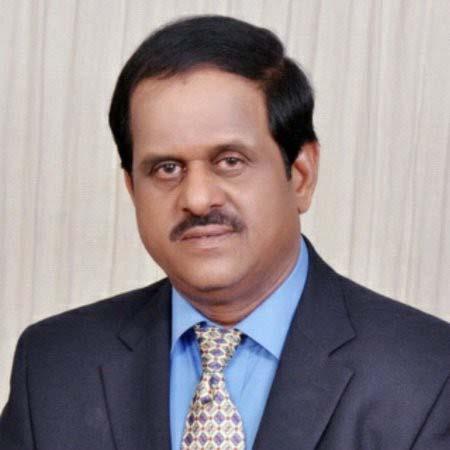

claimed the 4th position, while JSS College of Pharmacy, Mysuru, secured 7th place at the national level.
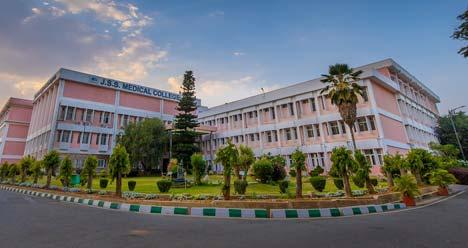


Together, these achievements present a holistic picture of excellence across streams, like medicine, dentistry, pharmacy & more, and demonstrate how the institution’s integrated model of education, research, and healthcare is translating into measurable recognition. Complementing its NIRF success, JSS AHER also shone in the Times Higher Education (THE) Impact Rankings 2025, where it achieved an impressive 56th position globally for its contributions to the United Nations’ Sustainable Development Goals.
Under Pro Chancellor Dr. B Suresh’s leadership, JSS AHER is continuing to upgrade its hospital infrastructure, even while being tightly integrated

with academic aims. The JSS Hospital now houses the KINEVO 900 neurosurgical microscope, a state-ofthe-art robotic imaging system. This tool supports minimally invasive neurosurgery with improved visualization, greater safety margins, and shorter operative times. Its presence elevates the training and clinical capabilities of neurosurgeons and gives students exposure to advanced surgical modalities. When such equipment is powered by a hospital that also functions as a teaching site, an additional benefit is that students learn in the latest realworld contexts. This alignment of healthcare and education is central to JSS AHER’s institutional model. At JSS AHER, leadership sets the tone for progress. The Chancellor His Holiness Jagadguru Sri Shivarathri Deshikendra Mahaswamiji provides


spiritual direction and a value-based foundation, ensuring that the institution’s growth remains anchored in compassion, inclusivity, and sustainability. His presence at academic ceremonies and strategic events reflects his deep commitment to education as a transformative force in society.
Executive Secretary of JSS Mahavidyapeetha, Dr. CG Betsurmath, continues to be the administrative leader, ensuring that the university’s academic excellence is complemented by social impact. His leadership in change management and strategic planning has been crucial in the steady rise of JSS AHER across national and international rankings.
Pro-Chancellor Dr. B. Suresh, a towering figure in pharmaceutical sciences, has guided research-driven programs and international collaborations that strengthen the institution’s global footprint. His long-term vision for the upcoming Varuna Global Campus shows a keen ambition to align JSS AHER with the world’s most forward-looking universities.
Vice Chancellor Dr. H. Basavana Gowdappa, with decades of experience in medical education, leads the academic and research initiatives with a focus on interdisciplinary learning and
The ceremonies also highlight inclusivity, with women consistently among leading achievers. These events provide emotional resonance, reinforcement of identity, and motivation for future students, reminding everyone that JSS AHER is not just about degrees, but legacy and impact.
employability. He is supported by Registrar Dr. B. Manjunatha, whose stewardship ensures efficiency and compliance in the university’s wideranging academic operations. Together, this leadership team blends spiritual ethos with pragmatic administration to drive JSS AHER forward.
Convocations at JSS AHER are more than ceremonies, they are occasions that reflect institutional culture, values, and aspirations. In recent convocations, over 260 pharmacy students across BPharm, PharmD, DPharm, and MPharm programs graduated to applause, under blessings from the Chancellor His Holiness Jagadguru Sri Shivarathri Deshikendra Mahaswamiji and in the presence of Executive Secretary Dr.
Betsurmath, Vice Chancellor Dr. H Basavana Gowdappa, and Registrar Dr. B Manjunatha.
Outstanding achievers were honored with gold medals, with names such as MJ Saroj, Anirudh Kamath, Kamakshi Shriya, Anju James, Katikala Tanvi, Lakshmi S, Meghana R, Darshan R, Bindushree G, Thummuru Jayasree Reddy, Shirisha G, Megha Kudpaje, and Harsha Pratap Singh standing out. These awards emphasize a merit culture, benchmarking of excellence, and the university’s commitment to recognizing top performers.
The ceremonies also highlight inclusivity, with women consistently among leading achievers. These events provide emotional resonance, reinforcement of identity, and motivation for future students, reminding everyone that JSS AHER is not just about degrees, but legacy and impact.
JSS AHER’s academic heartbeat can be felt strongly in its research culture. The institution regularly hosts Research Conclaves, one of the most prominent and recent ones being held in Ooty, bringing together faculty, students, and external scholars for interdisciplinary exchange. Presentations, panel discussions, poster sessions, and collaborative networking fostered cross-pollination of ideas.
These conclaves are complemented by departmental symposia, guest lectures, and workshops in life sciences, public health, biotechnology, and clinical disciplines. Support from national funding agencies such as the DBT, CSIR, and ICMR, along with international partnerships, accelerates research momentum.
Beyond infrastructure and funding, thought leadership is also visible in public discourse. Senior leaders from JSS AHER have participated in forums on the future of education, the role of artificial intelligence, and societal needs. In one widely noted discussion, Dr. CG Betsurmath, with Vice Chancellor Dr. H Basavana Gowdappa and Registrar Dr. B Manjunatha, emphasized that AI will not replace human roles but demand adaptability and continuous upskilling. This messaging underscores the institution’s positioning as forwardlooking yet human-centric.
True to its ethos, JSS AHER continues to ground itself in social missions.
Community health camps, rural outreach programmes, and awareness initiatives in public health, noncommunicable disease screening, and health education continue to expand. For instance, its departments like Community Medicine regularly organize wellness campaigns that bridge academic learning with social service.
These efforts do more than serve
communities, as they also enrich student learning, inform policyrelevant research, and strengthen institutional legitimacy. They also help JSS AHER’s performance in ‘outreach and inclusivity’ metrics used by national and global ranking frameworks. Its strong showing in THE Impact Rankings, especially in SDG 7 (Affordable and Clean Energy) where it achieved global 2nd rank, reflects a sustained alignment between academic output and realworld impact.
Looking forward, the underconstruction Varuna Global Campus is among JSS AHER’s boldest ventures. Envisioned to span over 100 acres, this campus is expected to host thousands of students, research scholars, incubation units, and advanced academic programs in digital health, biomedical engineering, hospital management, and allied sciences.
JSS AHER today stands as a multi-dimensional institution: university, hospital, research hub, and social engine. The steps it has taken, like achieving higher national rankings, upgrading clinical infrastructure, fostering research ecosystems, and planning ambitious expansions, are not isolated moves, but highly calibrated patterns of growth.

By situating education, research, innovation, and healthcare delivery in one integrated ecosystem, the Varuna campus aims to transcend the traditional boundaries of academia. Start-ups and incubators in health-tech, translational medicine, and regulatory policy labs are expected to coexist alongside classrooms and hospitals. This expansion is not just infrastructural, but strategic. It underscores JSS AHER’s intention to become a global node of excellence, attracting top talent, forging international collaborations, and influencing healthcare education norms, not just regionally, but globally.
JSS AHER today stands as a multidimensional institution: university, hospital, research hub, and social engine. The steps it has taken, like achieving higher national rankings, upgrading clinical infrastructure, fostering research ecosystems, and planning ambitious expansions, are not isolated moves, but highly calibrated patterns of growth.
Under the spiritual vision of Chancellor His Holiness Jagadguru Sri Shivarathri Deshikendra Mahaswamiji and the innovative vision of Pro Chancellor Dr. B Suresh, the university has combined continuity and innovation. Its 2025 NIRF performance, especially in specialty colleges such as medicine, dental sciences, and pharmacy, is a public affirmation of that vision.
As JSS AHER readies the Varuna campus, deepens global partnerships, and continues to invest in both infrastructure and human capital, it carries forward a legacy of healing, inquiry, and social commitment. The institution is not merely preparing graduates but shaping ethical professionals, responsive researchers, and leaders who will carry forward not just the name of JSS, but its mission of transforming communities through knowledge and service.
IN AN AGE WHEN MANUFACTURING HEADLINES ARE DOMINATED BY GLOBAL SUPPLY-CHAIN SHOCKS AND GEOPOLITICAL JOCKEYING, FEW INDIAN ENGINEERING STORIES FEEL AS CONFIDENTLY FUTURE-FACING AS DYNAMATIC TECHNOLOGIES. ONCE A NICHE HYDRAULICS MAKER, THE BENGALURU-HEADQUARTERED COMPANY HAS QUIETLY REINVENTED ITSELF INTO A MULTI-VERTICAL ENGINEERING GROUP. DYNAMATIC IS TODAY A TIER-1 SUPPLIER TO AIRBUS AND BOEING, A PARTNER FOR REGIONAL AIRCRAFT ASSEMBLY LINES, AND AN INCREASINGLY IMPORTANT CONTRIBUTOR TO INDIA’S DEFENCE MANUFACTURING AMBITIONS. MUCH OF THAT REINVENTION IS CREDITED TO ONE PERSON - ITS MD & CEO DR. UDAYANT MALHOUTRA, POPULARLY KNOWN AS ‘TOBY’, HIS NICKNAME. HOWEVER, TOBY HIMSELF WOULD BE THE FIRST PERSON TO DISPUTE THAT CREDIT, RATHER CREDITING THE WHOLE TEAM FOR DYNAMATIC’S DYNAMIC TRANSFORMATION WHICH IS STILL ONGOING.
Despite not being an engineer by training himself, Toby is known in the industry for his strategic eye, willingness to invest in aerospace capability, and insistence on design-plusmanufacture, which are factors that transformed Dynamatic from an old-line components shop into a diversified engineering conglomerate with global customers and growing defence credentials.
Dynamatic’s strategy may appear simple in hindsight, but it was nothing but simple. From just making parts, Dynamatic shifted to overdrive by designing them; and from being a supplier, Dynamatic became an integrator; and above all the Dynamatic team took up system-level responsibility which made all the difference in winning global orders from aerospace majors.
Dynamatic broadened systematically from hydraulics into complex aerostructures, precision machining for aerospace, homeland security solutions, metallurgy and foundry work, automotive components, medical engineering services, and turnkey engineering solutions. That climb up the value chain - from low-margin commodity work to mission critical
systems and assemblies - is what allowed the company to win marquee contracts and capture the higher margins and strategic relationships that come with them.
More than anything else, Dynamatic is today known for its aerospace prowess.The company has won multiyear contracts from Airbus to manufacture and assemble a broad family of doors for the A220, which is a high-visibility win that positioned an Indian firm as the global source for critical aircraft hardware.
Winning that contract proved pivotal for the firm as it signalled OEM trust in Dynamatic’s design controls, quality systems and capacity to scale. Beyond aircraft doors, the company has been selected for other aerostructures and assemblies, and it has forged partnerships to localise manufacturing in India. This met the expectations of both global OEMs’ move to diversify manufacturing hubs, as well as India’s ‘Make in India’ program.
Dynamatic’s aerospace momentum hasn’t stopped at manufacturing doors or small components. The company has announced collaborations to produce rear fuselages and to establish finalassembly capabilities, with the best example being a partnership with
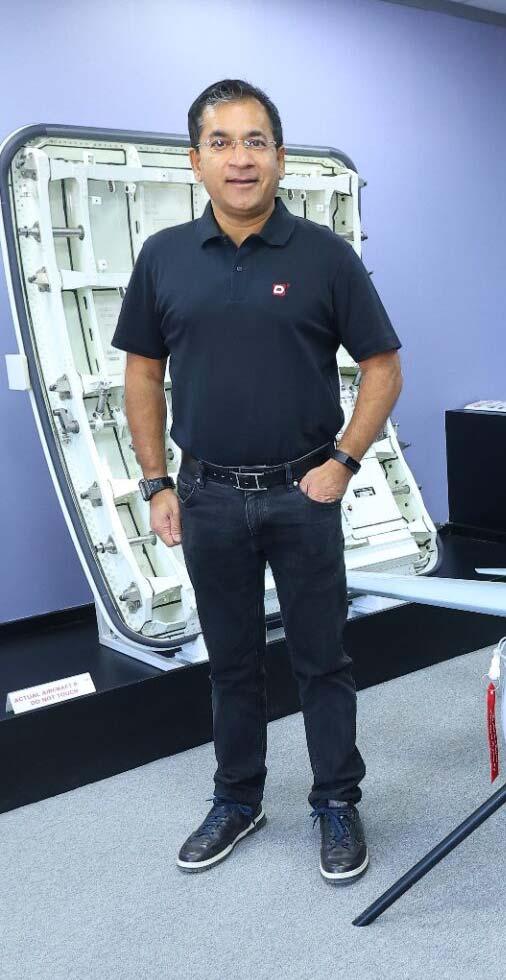
Deutsche Aircraft for their D328eco regional turboprop’s rear fuselage assembly line in Bengaluru.
These moves signal a determined climb from being a component supplier to a systems partner, offering higher value and greater relevance to OEM programs. It has also entered into cosourcing deals like the A220 supply chain partnership with Aequs, with its ultimate ambition being to build an ecosystem that can confidently take up complex manufacturing work for global aerospace giants.
Parallel to its civil aerospace push, Dynamatic has been making steady inroads into defence and homeland security. Its long experience in hydraulics, especially in pumps and actuators used in military platforms, gave it a technical foot in the door.


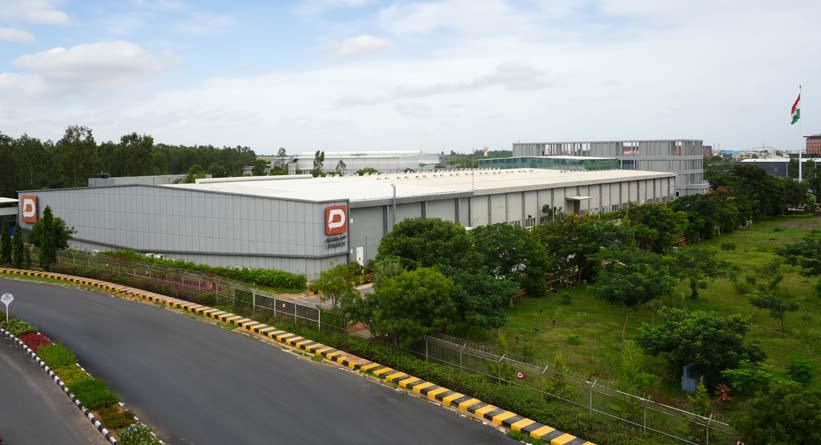
Under Malhoutra, the company invested big to meet defence specifications, achieve security clearances, and localise critical manufacturing that was once imported.
Thanks to such consistent efforts, Dynamatic is now positioned as a trusted supplier for defence OEMs and integrators, contributing to India’s strategic push toward self-reliance in defence manufacturing and even aiming for exportable systems. While much of the sector is lumpy and projectdriven, the company’s combination of aerospace pedigree and defence-grade manufacturing makes it a natural fit as India scales indigenous production.
Hydraulics remains a core business, especially as the engineering skillset where Dynamatic’s story began and has served as the foundation of its manufacturing culture. While the segment is more mature and competitive than aerospace, it provides steady revenues and provides an
engineering testbed for tighter tolerances and systems thinking that translate readily into the aerospace world.
On the automotive side, Dynamatic has continued to serve global OEMs with precision machined components and assemblies. The company’s strategy has been to modernise processes, adopt advanced machining and automation, and migrate from commodity components to system level assemblies, which is a significant value addition appreciated by global customers, even while generating higher margins. While some analysts expected the company to exit the automotive business to focus on aerospace, Dynamatic has upgraded it to a higher orbit.
Thanks to this dual focus and excellence in both, Dynamatic Technologies is today a leading private R&D organisation with numerous patents and inventions to its credit, and partners global marquee customers from both segments like Airbus, Boeing & Bell
SEASONAL MAGAZINE
Helicopter from aircraft sector, and BMW, Audi, Daimler, Mercedes, John Deere and Cummins from the automotive side, both on a single source basis.
Dynamatic has also strategically undertaken backward integration, by diversifying to metallurgy, foundry capabilities and in-house materials expertise. Aerospace and defence parts demand strict metallurgical control and traceability, and creating such manufacturing capabilities internally itself, reduces supply-chain risks and improves lead times.
Hence, Dynamatic expanded successfully into alloy production, heat treatments and specialised metallurgy, which were steps designed to shorten the critical path for complex assemblies and give OEMs a single point of responsibility, which proved to be an attractive proposition for such customers managing global supply chains. Engineering services provided by Dynamatic like design, testing & validation, further reinforce this backward integration.
Dynamatic factories are located across 7 cities, four of them in IndiaBangalore, Chennai, Coimbatore & Nasik. The other three cities with Dynamatic factories are Swindon & Bristol in the United Kingdom and Schwarzenberg in Germany. While all these facilities are noted for their green and clean features, one of its sprawling facilities in Bengaluru also features a museum on Indian folk arts and an organic farm as part of its CSR and sustainable initiatives.
Dynamatic Technologies and its subsidiaries and divisions including Dynauton Systems, which is into Unmanned Aerial Vehicles and Loitering Munitions, employs around 50 scientists and 500 engineers, and is a leading R&D Organization, with numerous inventions and patents to its credit. Its R&D expertise spans Mechanical Engineering, Advanced Computer Aided Engineering, Materials & Metallurgical Engineering, Fluid Dynamics and Defense & Aerospace Engineering.
Prowess in precision engineering and regulatory frameworks made Dynamatic a natural fit for the medical device
components and other such highly regulated engineering services. While this division is still smaller than aerospace or hydraulics, it offers diversification into secularly growing markets like medical implants, surgical instruments etc that value traceability and microprecision. For Dynamatic, medical engineering represents a lowervolatility revenue stream that leverages the company’s existing manufacturing skills and quality systems.
Team strength is how Dynamatic made everything possible, and this effort was led by Dr. Udayant Malhoutra who guides the team to be obsessed about design aesthetics and engineering finesse. Thanks to such team efforts, today, Dynamatic is seen as a global ambassador for India’s precision engineering and manufacturing capabilities.
The University of Engineering and Management, Kolkata had conferred the degree of Doctor of Engineering & Technology (Honoris Causa) on Udayant Malhoutra, and he has also served on the Board of Governors of IIT Kanpur, and as the Chairman of both National Sector Skills Council for Strategic Manufacturing, and National Institute of Design, Amravathi.
Sustained team efforts have catapulted the company into a role where it doesn’t just make what others design but designs what others need. That shift required investments in cleanrooms, quality systems, highly skilled engineers, and above all patient capital. These were choices that would have looked risky to short-term shareholders but proved critical to winning and executing aerospace and defence contracts.
Dynamatic’s unique business mix, which is a blend of capital-intensive aerospace projects, cyclical automotive work, and steady hydraulics revenue, makes its financial performance complex. Recent quarterly disclosures show the company continuing to grow its top line, led by aerospace, even as
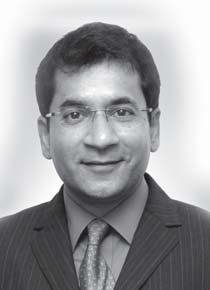
“MONEY AND VALUATION WILL CHASE SUSTAINABILITY AND SOCIETAL IMPACT, AND NOT THE OTHER WAY AROUND”
1) You took over Dynamatic Technologies 1) You over 1) You took over Dynamatic Technologies 1) You over when it was primarily a hydraulics when it was primarily hydraulics primarily manufacturer. What was the first big manufacturer. was first manufacturer. What was the first big manufacturer. was first first decision that set it on its aerospace and decision set it on its aerospace and defence trajectory? defence defence trajectory? defence defence
The collapse of the Soviet Union created a situation where the Indian Army was unable to source hydraulic products for India’s T-72 battle tanks. Dynamatic developed these indigenously, eventually winning a National Award for this work. We then worked on other developmental programs with the DRDO including CVRDE, ADE & ADA.
2) Many see your leadership as a case study 2) Many see a case study 2) Many see your leadership as a case study 2) Many see a case study 2) case in moving up the value chain. How did in moving up the value How did up the you convince global OEMs like Airbus and you global OEMs and you convince global OEMs like Airbus and you global OEMs and you convince global OEMs like Airbus and Boeing to entrust Dynamatic with critical Boeing to entrust Dynamatic with critical assemblies? assemblies? assemblies? assemblies?
There was no strategy other than ensuring quality, reliability, safety, traceability and global best value. This is also an ongoing process.
3) The A220 door contract was a turning 3) door was a turning 3) The A220 door contract was a turning 3) door was a turning a point. What were the toughest challenges point. were challenges point. What were the toughest challenges point. were challenges were in meeting Airbus’s quality and in meeting Airbus’s quality and in meeting Airbus’s quality and in meeting Airbus’s quality and certification requirements? certification requirements?
The processes are the same as we have been following for the past two decades. Basically, it is all about a zero compromise philosophy in design, engineering and manufacturing.
4) Your Bengaluru campus blends high- 4) Your Bengaluru blends blends tech engineering with an art museum and tech engineering with an art and tech engineering with an art museum and tech engineering with an art and tech
organic farmland. How does this organic farmland. How organic farmland. How does this organic farmland. How environment influence creativity and environment influence creativity environment influence creativity and environment influence creativity environment problem-solving? problem-solving? problem-solving? problem-solving?
Our workforce is drawn from the Bangalore Urban and the Bangalore Rural Districts. The first is home to the largest cohort of globally renowned engineers in the world, whereas the rural district produces highly skilled craftsmen drawn from the artisan community around here. This blend of engineering and craftsmanship is essential for excellence in aerospace manufacturing.
5) With global OEMs diversifying
5) With OEMs diversifying With their supply chains, where do you their supply chains, do you their supply chains, where do you their supply chains, do you see Dynamatic positioned five years see Dynamatic positioned five years from now in the global aerospace from now in the global aerospace from now in the global aerospace from now in the global aerospace ecosystem? ecosystem? ecosystem? ecosystem?
Our definitive plan is to continue to excel and to keep growing our business internationally.
assets. How do you avoid assets. How do you assets. How do you avoid assets. How do you overextending in capacity if demand overextending in demand overextending in capacity if demand overextending in demand slows? slows? slows? slows?
It is always a choice between competence ownership and capital efficiency. Every company faces similar choices. We believe we are navigating this challenge competently.
10) You have positioned Dynamatic 10) You Dynamatic as a systems partner, not just a as a systems partner, not just a as a systems partner, not just a as a systems partner, not just a just component supplier. How do you component supplier. How do you supplier. How do ensure that you don’t stretch the that you ensure that you don’t stretch the that you company’s technical bandwidth too company’s technical bandwidth too thin across multiple high-stakes thin across multiple high-stakes thin across multiple high-stakes thin across multiple high-stakes programmes? programmes?
When we reach a point where we feel stretched, we will definitely say no.
some legacy segments experienced softness. For example, the company’s Q1 FY2026 presentation reported yearon-year revenue growth overall with aerospace up strongly while hydraulics declined modestly.
6) Aerospace contracts are
6) Aerospace contracts are are but also high-risk. How do you mitigate but also high-risk. How do but the dangers from delays, cancellations, the dangers delays, cancellations, the dangers from delays, cancellations, the dangers delays, cancellations, and shifting specifications from global and shifting specifications from OEMs? OEMs?
6) Aerospace contracts are high-profile
6) Aerospace contracts are high-profile
We have designed our business for risk mitigation, with customers coming from diverse sectors like Commercial Aircraft, Military Aircraft, Helicopters and Business Jets. This has reduced the concentration risk. Customer specifications are stable and often developed in close cooperation with Tier-1 vendors like ourselves.
7) Dynamatic’s stock has shown
7) Dynamatic’s stock has notable volatility in recent years. Do notable volatility in recent Do notable volatility in recent years. Do notable volatility in recent Do in you believe your long-cycle strategy you believe long-cycle strategy you believe your long-cycle strategy you believe long-cycle strategy believe is fully understood by investors, or is is fully understood or is is fully understood by investors, or is is fully understood or is market patience wearing thin? market patience wearing market patience wearing thin? market patience wearing
We communicate clearly about our business and its long-term nature. We have quality investors who hold long-term. We do not comment about our stock price.
8) Defence orders can be politically 8) Defence orders can influenced and lumpy in execution. influenced and lumpy in influenced and lumpy in execution. influenced and lumpy in How do you plan to create a steadier How do you plan to a steadier you revenue stream in such an revenue in such an revenue stream in such an revenue in such an an unpredictable sector? unpredictable sector?
You cannot. That’s why we also have our hydraulics business which provides granular cash-flow to the company. Then we have the newer Dynauton division which is into UAVs and drones, where we have done the entire hardware and software work ourselves in India. This division has significant scaling potential given the global geopolitical risks, and the role UAVs and drones are playing in modern defence systems. This division thus has the potential to surprise investors, if everything plays out well.
9) Vertical integration brings control, 9) Vertical integration brings control, integration but it also locks capital into fixed but it locks into fixed but it also locks capital into fixed but it locks into fixed but
11) From the way the stock has run From the way the stock has run
11) From the way the stock has run
From the way the stock has run run up from Rs 10 to Rs 9000 in less from 10 to 9000 in less up from Rs 10 to Rs 9000 in less from 10 to 9000 in less from than two decades, and then two decades, and then than two decades, and then two decades, and then and corrected sharply, do you think sharply, do you think corrected sharply, do you think sharply, do you think do investors sometimes have too high investors sometimes too high too expectations? expectations? expectations? expectations? expectations?
We also have high-quality investors who have bought into the company when the stock price was in low double digits, and still holding strong. We also have investors who buy into dips. But yes, as you said, some investors might have too high expectations, especially in the short-term, which is not the correct way to go about, either in business or investing.
12) What is your business 12) What is your business philosophy guiding Dynamatic philosophy guiding then? then?
This short-term outlook centred on money and valuation is especially strong in countries like India, whereas in developed economies like in the US & Europe, they have woken up to the fact that a business needs to be sustainable first by contributing to the community around it. True and sustainable wealth creation is possible only on such a foundation. Spiritually, I am a Buddhist, and hence this comes naturally to me.
13) How do you follow such 13) How you policies in Dynamatic? in Dynamatic? policies in Dynamatic? in Dynamatic?
Everything we do is in sync with that philosophy. That is why this campus is fully solar powered and with rainwater harvesting too. Our focus is on community impact and societal change. This is also why we have an upskilling centre where we train the children of local craftsmen into sustainable jobs, by facilitating them to work with our world class engineering talent. It is a jump from handicraft to aircraft, but we have proven that this is possible. It is also why we took over a 650 year old heritage foundry in Germany and utilizing it perfectly and sustainably.
On the capital markets, the Dynamatic stock has hence demonstrated volatility, which is typical for a mid-cap engineering firm driven by lumpy contract wins. But on a longer horizon, Dynamatic has rewarded investors as the aerospace wins and defence relevance crystallised. Hardcore Dynamatic fans in the market care less about its quarterly beats than about the durability of long-cycle contracts and the company’s execution pedigree on complex aerostructures.
For Dynamatic and its investors, no single endorsement matters more than OEM trust. Dynamatic’s supplier relationships with Airbus and Boeing for doors, structural components and assemblies have been the clearest market signal that the company can meet global aerospace manufacturing standards at scale. These relationships also provide a steady stream of followon opportunities.
The path forward for Dynamatic is however not without hazards. Aerospace contracts are capitalintensive and certification-heavy, and delays, quality issues or programme cancellations can be painful. Defence work can also be episodic and politically driven. Currency swings and raw-material inflation bite into margins, adding to Toby and team’s challenges. However, the firm also enjoys several macro tailwinds including the global OEM strategy to diversify manufacturing bases, India’s strategic push for indigenous defence production, and rising demand for regional aircraft and MRO capacity. This can create a multi-year if not multidecade window of opportunity for Dynamatic.
Dynamatic’s story is perhaps the best case study on how a visionary, patient, and strategic team can power the ambition to move up the value chain, and transform the entire organization. It is also a vivid example of how India can nurture home-grown champions in precision engineering and aerospace.
SEASONAL MAGAZINE
Manappuram Finance, a name synonymous with gold-backed lending in India, is poised for a transformational leap. With Bain Capital acquiring a significant stake in the company, the gold loan giant is shifting from a promoter-driven entity to a professionally managed non-banking financial company (NBFC) of global standards. This move, spearheaded by the visionary leadership of VP Nandakumar, Managing Director & CEO of Manappuram Finance, reflects a calculated strategy to enhance corporate governance, drive efficiencies, and attract global investors. The deal is widely hailed as a win-win for not only the current promoter group led by VP Nandakumar and Bain Capital, but for all stakeholders like employees and minority shareholders, as this paves the way for a possibly brighter future even while it removes a key overhang on the company future as well as its stock.
The significant stake acquisition by Bain Capital, a globally renowned private equity giant, in Manappuram Finance, marks a pivotal moment in the company’s history, as it transitions from a familypromoted business to an institutionally managed financial powerhouse. The infusion of capital and expertise from Bain is expected to propel Manappuram into a higher growth trajectory, with a sharper focus on diversification and digital transformation.
Bain Capital is acquiring an 18% stake in Manappuram Finance for Rs 4,385 crore ($525 million) at Rs 236 per share, representing a 30% premium over the then prevailing market price. Currently, Manappuram is trading near the issue price to Bain. The deal values Manappuram Finance at approximately Rs 20,000 crore ($2.4 billion).
The transaction has triggered an open offer as per SEBI regulations, which may allow Bain to further increase its holding depending on shareholder response. Thus Bain Capital will have the option to increase its stake to over 40%, securing a more influential role in the company’s strategic direction.
The VP Nandakumar-led current promoter group, which currently holds 35%, will see its stake diluted to
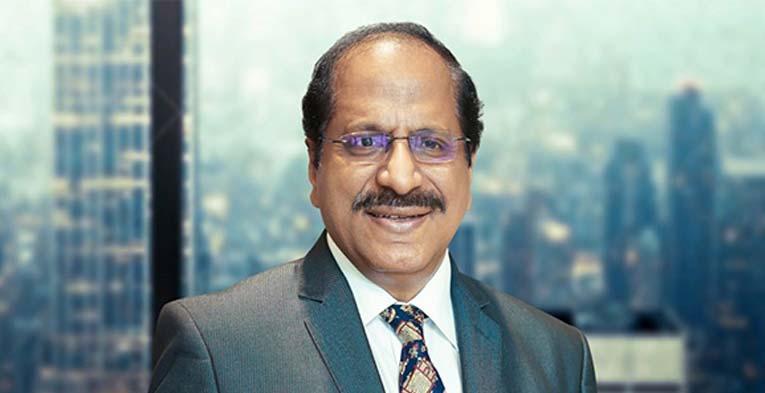
approximately 28.9% post-transaction. Bain Capital will also gain executive board representation and operational control, marking its position as a copromoter of the company alongside Nandakumar.
This shift underscores the transition of Manappuram from a traditionally managed lender to a modern, institutionally governed NBFC. The deal is especially hailed as a win-win for both parties, as initially Bain wanted to buy only the flagship gold loan business, and to buy it fully, whereas Nandakumar preferred a part stake sale of the whole listed firm.
While it can be thought that Nandakumar eventually prevailed over Bain in the negotiations, with the contours of the final deal appearing as more favorable to Nandakumar, reality is that it is a win-win for both, as Bain would have struggled without a seasoned gold-loan entrepreneur like Nandakumar as co-promoter and mentor. It is a win-win for Manappuram investors and employees too, as this deal secures a bright future for all stakeholders.
Under the leadership of VP Nandakumar, Manappuram has consistently demonstrated resilience and innovation. From expanding beyond gold loans to venturing into microfinance, housing finance, and vehicle loans, the company has shown remarkable adaptability. The Bain Capital deal underscores Nandakumar’s ambition to make Manappuram a major force in the financial services sector.
By welcoming Bain Capital as a strategic promoter, Nandakumar has taken a crucial step toward institutionalizing the management, improving governance structures, and ensuring sustainable long-term growth. This move aligns with global trends where financial institutions transition from being promoter-led to professionally managed entities, ensuring greater transparency and accountability.
Bain Capital’s investment in Manappuram Finance is not an isolated move. Bain has a strong track record of investing in and scaling up Indian

companies across sectors. Some of its key India portfolio companies include Axis Bank where Bain Capital’s investment played a significant role in strengthening the lender’s capital base and operational efficiencies.
Similarly, Bain had infused significant capital into L&T Finance Holdings, enabling it to improve its asset quality and digital capabilities, thus propelling the NBFC into the frontline of this highly competitive sector.
Hero FinCorp is another Indian financial services firm that has scaled with Bain’s support, by expanding its reach and diversifying its product offerings. Bain’s expertise was also visible in technology sector investing, with Genpact, the noted business process management major benefitting significantly from Bain’s operational expertise and global connections.
Given this impressive track record, Bain’s involvement in Manappuram Finance is expected to bring not just financial resources but also operational expertise, risk mitigation strategies, and access to a global investor pool.
The financial world has taken note of this game-changing deal, with major credit rating agencies and brokerage firms weighing in on the implications of Bain Capital’s entry into Manappuram Finance.
S&P Global Ratings has suggested that the deal will likely enhance Manappuram’s governance and risk management frameworks, positioning it for sustained long-term growth, while Fitch Ratings sees the Bain Capital stake
as a positive development that could lead to a re-rating of Manappuram Finance’s credit profile, given the expected improvements in corporate governance and operational efficiency.
Brokerages such as Jefferies, ICICI Securities, and Motilal Oswal have issued optimistic outlooks on Manappuram Finance post-acquisition. They highlight the potential for improved asset quality, lower cost of capital, and a broader product suite, all of which could lead to higher valuations and stronger financial performance in the coming quarters.
As Manappuram Finance embarks on this transformative journey, the company stands to benefit immensely from Bain Capital’s expertise. The focus is expected to shift toward a stronger digital lending platform, enhanced credit underwriting models, and a diversified lending portfolio beyond gold loans.
VP Nandakumar’s leadership will be critical in steering this transition, ensuring that Manappuram retains its core strengths while evolving into a professionally managed, globally recognized NBFC. The Bain Capital stake acquisition is more than just a financial transaction; it represents a strategic pivot that could redefine the future of Manappuram Finance and set a precedent for other Indian NBFCs aspiring to achieve global excellence.
With the support of Bain Capital and the confidence of analysts and investors, Manappuram Finance is well on its way to establishing itself as a world-class financial institution, ready to compete on a wider stage.
SEASONAL MAGAZINE
In the heart of India’s rapidly evolving power and infrastructure landscape, REC Limited stands as a titan, driving the nation’s energy transition and infrastructure growth with unparalleled ambition. As a Maharatna Central Public Sector Enterprise under the Ministry of Power, REC has solidified its position as a cornerstone of India’s electrification and sustainable development goals. Recent developments, ranging from mega investment plans to leadership transitions, bond issuances, and strategic partnerships, underscore REC’s pivotal role in shaping India’s future. Under its new CMD Jitendra Srivastava, REC is destined to leverage its unique position in the power and infrastructure financing sector, to stay ahead as a standout performer in both financial markets and national development.
In April 2025, REC welcomed a new Chairman and Managing Director (CMD), Jitendra Srivastava, a 2000-batch Indian Administrative Service (IAS) officer from the Bihar cadre. Srivastava’s appointment, approved by the Appointments Committee of the Cabinet, marks a significant transition for REC as it diversifies its operations beyond traditional power financing into broader infrastructure projects.
Srivastava brings a wealth of experience from key administrative and leadership roles across sectors such as finance, power, education, public health, and infrastructure. Prior to joining REC, he served as Joint Secretary in the Department of Drinking Water and Sanitation under the Ministry of Jal Shakti, and held critical positions in Bihar’s Home Department and Public Health Engineering Department.
His academic credentials, including a Bachelor of Arts (Honours) in Economics from Hansraj College, Delhi University, and an MBA in Finance from Cochin University of Science and Technology, equip him with the financial acumen and strategic vision needed to steer REC through its ambitious growth phase.
Srivastava’s appointment comes at a time when REC is expanding its footprint in renewable energy and infrastructure. His diverse experience positions him to navigate the complexities of financing large-scale projects while aligning with the government’s clean energy and infrastructure development goals. Srivastava is poised to lead REC into a new era of innovation and growth.
REC’s recent investment commitments reflect its bold vision to transform India’s infrastructure landscape. One of the most significant developments is REC’s recent Memorandum of Understanding (MoU) with the Mumbai Metropolitan Region Development Authority (MMRDA), signed during the India Global Forum Mumbai NXT 25 event in 2025.
This landmark agreement pledges Rs 1 lakh crore over the next five years to finance a wide range of infrastructure projects in the Mumbai Metropolitan Region (MMR). The MoU, executed by Harsh Baweja, Director (Finance) at REC, and Dr. Ankush R Nawale, Financial Advisor at MMRDA, focuses on urban mobility, affordable housing, and essential civic infrastructure.
Maharashtra Chief Minister Devendra Fadnavis and other senior officials witnessed the signing, highlighting its importance to the region’s development.
REC’s Rs 1 lakh crore commitment reflects their strong dedication to
supporting large-scale infrastructure projects that will significantly improve the living standards for the people of Mumbai Metropolitan Region.
This partnership also underscores REC’s growing role in urban transformation and sustainable development, beyond its original mandate which is reflected in its earlier name and branding, Rural Electrification Corporation.
Beyond Mumbai, REC has also signed an MoU with the Energy Management Centre (EMC), Government of Kerala, for Rs 18,360 crore in financing for pumped storage projects (PSPs) over the next five years. Signed during the Global Green Hydrogen & Renewable Energy Summit 2025, this agreement aligns with India’s renewable energy goals, particularly in enhancing energy storage to address the intermittency of solar and wind power.
These investments demonstrate REC’s strategic focus on renewable energy infrastructure, a critical component of India’s commitment to achieving 50% non-fossil fuel-based energy capacity by 2030.
REC’s financing prowess extends to highimpact renewable energy projects, exemplified by its Rs 2,147 crore term loan agreement with Chenab Valley Power Project Limited (CVPPL) for the 1,000 MW Pakal Dul Hydro Electric Project in Jammu & Kashmir.
Signed on February 11, 2025, this agreement supports the development of a project estimated to cost Rs 12,669 crore, located on the Marusadar River in Kishtwar district. The project is a cornerstone of India’s efforts to bolster renewable energy capacity and energy security in the region.

This follows REC’s earlier commitment of Rs 1,869.265 crore to CVPPL for the 624 MW Kiru Hydro Electric Project, also in Kishtwar. These agreements highlight REC’s critical role in financing hydropower, a renewable energy source that complements India’s solar and wind initiatives.
By supporting such projects, REC is helping India harness its hydropower potential while fostering economic growth in strategically important regions like Jammu & Kashmir.
To fund its ambitious investment plans, REC has been actively tapping the bond
market and expanding its borrowing program. In 2025, the company raised Rs 5,000 crore through two bond issuances - Rs 3,000 crore via five-year bonds at a 6.87% coupon rate and Rs 2,000 crore via 10-year bonds at a 6.86% coupon rate.
These bonds, listed on the BSE and NSE, received an overwhelming response from investors, reflecting strong confidence in REC’s financial stability and growth prospects. Assigned “AAA” ratings by CARE Ratings, ICRA, and India Rating & Research, the bonds underscore REC’s low credit risk and high investor appeal.
In December 2024, REC had raised Rs 2,195 crore through bonds with tenures of 10 years and four months (Rs 1,620 crore at 7.10%) and 15 years (Rs 575 crore at 7.14%). These issuances demonstrate REC’s ability to secure costeffective financing to support its expanding loan book.
Looking ahead, REC’s board has approved a revised borrowing plan of Rs 1.8 lakh crore for FY26, up from Rs 1.6 lakh crore. This includes Rs 1.55 lakh crore through domestic bonds, debentures, capital gains bonds, rupee term loans, and external commercial borrowings (ECBs), alongside Rs 10,000 crore in short-term loans and Rs 5,000 crore via commercial papers.
The flexibility to interchange instruments ensures REC can adapt to market conditions and funding needs, positioning it to sustain its robust loan growth of 15-21% over recent quarters. REC’s financial performance and strategic initiatives have earned it high praise from analysts. CLSA, a leading brokerage, maintains a “high-conviction outperform” rating on REC, citing its bestin-class loan growth, return on equity (ROE) of 19-20%, and an attractive dividend yield, which now stands around 4%.
The brokerage highlights REC’s strong sanction pool, with 55% of sanctions from the past 2.75 years still undisbursed, primarily in generation, renewable, and infrastructure segments. This pool supports expectations of double-digit to mid-teen loan growth through FY 26-27.
CLSA also notes REC’s impeccable asset quality, with no slippages since FY22 and gross non-performing assets (NPAs) reduced to 2% as of December 2024, a

significant improvement from a peak of 7.2% in the last bad cycle. The company’s cautious approach to financing, primarily targeting government-owned projects, further mitigates asset quality risks.
Including CLSA, most analysts covering REC have “buy” ratings now. The company’s consistent dividend payouts - Rs 15.4 per share in FY25, including a fourth interim dividend of Rs 3.6 per share - further enhance its appeal to incomefocused investors.
REC’s role in India’s power and infrastructure financing sector is unparalleled, driven by its status as a Maharatna company and its 20% market share in power sector financing. Unlike its parent, Power Finance Corporation (PFC), which focuses on large-scale power generation projects, REC specializes in transmission, distribution, and rural electrification, aligning with government initiatives to expand energy access in underserved areas.
Of REC’s outstanding loans of Rs 5,65,621 crore, 88% are to state entities, with top states including Tamil Nadu, Telangana, and Maharashtra, while 33% of its portfolio is in infrastructure and logistics.
REC’s financing model addresses critical challenges in the renewable energy sector, such as intermittency, grid stability, and land acquisition. By providing long-term loans, bridge financing, and structured financial products, REC mitigates risks associated with high upfront costs and long gestation periods.
Its support for projects like pumped storage and hydropower aligns with India’s goal of achieving 500 GW of non-fossil fuel-based capacity by 2030, as outlined by the Ministry of New and Renewable Energy.
REC’s parent, PFC, holds a 52.63% stake and is a leading NBFC focused on power generation and infrastructure financing.
While PFC’s loan book is larger, REC’s specialized focus on rural electrification and transmission complements PFC’s strengths, creating synergies that enhance their combined impact on India’s power sector.
The historical trend of external appointments for REC’s top management, including high-caliber professionals like Jitendra Srivastava to the CMD post, ensures fresh perspectives and robust leadership, distinguishing REC from many of its peers.
REC’s financial performance continues to be a proof of its resilience. For Q3 FY25, the company reported an 18.42% year-on-year revenue increase to Rs 14,272 crore and a 23.21% rise in net profit to Rs 4,076 crore. Its loan book growth, low NPAs, and high ROE position REC as a leader among NBFCs.
The company’s ability to secure AAArated bonds and maintain investor confidence further bolsters its financial stability. Strategically, REC is diversifying into non-power infrastructure, as evidenced by its MMRDA partnership, while maintaining its core focus on renewable energy and rural electrification.
The inauguration of a state-of-the-art Experience Centre in Gurugram recently, showcases REC’s contributions to the power and infrastructure sectors. Featuring digital displays and interactive exhibits, the centre serves as a knowledge hub, reinforcing REC’s commitment to innovation and transparency.
REC Limited is at the forefront of India’s energy and infrastructure transformation, leveraging its financial strength, strategic investments, and visionary leadership to drive sustainable growth. Under Jitendra Srivastava’s guidance, REC is poised to capitalize on its Rs 1.8 lakh crore borrowing plan, mega investment commitments, and robust loan agreements to power India’s renewable energy and infrastructure ambitions.
With a stock that combines high dividend yields, strong fundamentals, and analyst confidence, REC remains an investment worth considering and a vital partner in India’s journey toward a cleaner, more connected and electric future. Since its IPO and listing in 2008, that is within 17 years, REC has grown investor wealth by more than 30 times.
SEASONAL MAGAZINE


TURNING 50 IS OFTEN A TIME FOR REFLECTION, AND FOR PURAVANKARA LTD., ONE OF INDIA’S LEADING LISTED REAL ESTATE DEVELOPERS, IT’S ALSO A MOMENT OF REITERATING ITS FOREVER COMMITMENTS. PRESENT NOW ACROSS 9 CITIES, WITH 51 MILLION SQ FT DELIVERED, AND WITH 80,000+ HAPPY FAMILIES AS CUSTOMERS, PURVA HAS COME A LONG WAY FROM 1975. AS THE COMPANY MARKS ITS GOLDEN JUBILEE IN 2025, PURAVANKARA IS NOT JUST BASKING IN HALF A CENTURY OF BUILDING DREAMS, BUT LAUNCHING BOLD PROJECTS WORTH TENS OF THOUSANDS OF CRORES, DRIVING INNOVATION IN JOINT DEVELOPMENTS ACROSS MAJOR METROS, AND LEVERAGING A 15 MILLION SQ FT LAUNCH PIPELINE TO KEEP RIVALS ON THEIR TOES. AMIDST MAJOR REDEVELOPMENTS IN MUMBAI, BLOCKBUSTER LAUNCHES IN KOCHI, AND ROBUST SALES MOMENTUM IN BENGALURU, THE LEADERSHIP TEAM LED BY FOUNDER & CHAIRMAN RAVI PURAVANKARA AND MD ASHISH PURAVANKARA, IS STEERING THIS MOST ENDURING REAL ESTATE BRAND INTO AN ERA BRIMMING WITH AMBITION AND PROMISE.
It has been a season of celebration for Puravankara Ltd. - the company traces its roots back to 1975 - as its golden jubilee year coincides with some of the most defining moments in its storied journey. Marking 50 years isn’t merely a retrospective exercise for this Bengaluru headquartered realty giant; it’s about showcasing how a legacy of trust can be translated into bold expansion and relentless ambition.
Alongside nostalgic commemorations, Puravankara has electrified the real
estate sector with a trailblazing Rs 2,100 crore redevelopment of eight housing societies in Mumbai’s Chembur, a project that will unlock over 1.2 million sq ft of premium residential real estate on a coveted four-acre plot.
The Chembur initiative is emblematic of Puravankara’s determined push into Western India redevelopment - the company has recently secured marquee sites at Breach Candy, Lokhandwala, and Pali Hill, with ongoing and upcoming Mumbai and Pune projects now spanning 14
million sq ft and expected to deliver a staggering Rs 18,000 crore in gross development value, with Rs 7,700 crore from redevelopment alone.
In Bengaluru, Puravankara has cemented its leadership with strategic land deals and joint ventures, headlined by the recent Rs 1,000 crore joint development agreement in East Bengaluru’s Balagere. This 5.5-acre project will bring to market 0.83 million sq ft of high-end residences within the next few months, an unmistakable signal of Puravankara’s confidence in the region’s high-
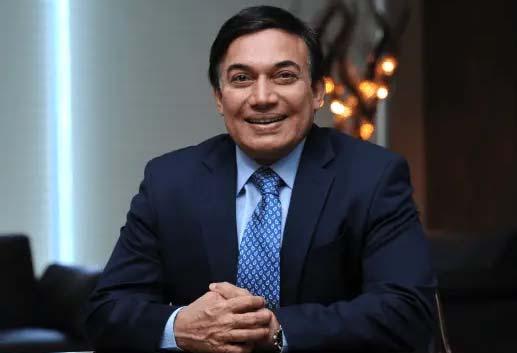



powered IT-linked housing demand. The company’s futuristic approach is further seen in its Rs 3,300 crore joint venture with KVN Property Holdings LLP for a 24.59-acre site in North Bengaluru’s Hardware Park, expected to offer 3.48 million sq ft of saleable space, tapping into a major planned infrastructure and the airport corridor. These deals add fresh muscle to Puravankara’s expanding 15 million sq ft launch pipeline, around two-thirds of which are slated for the country’s maximal growth markets and premium locations.
Apart from its megaprojects in Mumbai and Bengaluru, Puravankara has also made waves with a striking new launch in Kochi. Coming up along Marine Drive, the Kochi project boasts swish amenities, spacious layouts, and a prestigious address - setting new standards for Kerala’s luxury housing segment. With the Kochi launch feeding directly into Puravankara’s 15 million sq ft pipeline, the company is determinedly positioning itself for leadership in tier-1 and emerging metros alike.
Amid this expansion, Puravankara’s Q1 FY26 business update offers a snapshot of solid financial health. The company notched a 6% year-on-year growth in pre-sales, raking in Rs 1,124 crore for the quarter. Even without new launches, average price realization climbed an impressive 9%, reflecting robust demand and successful premiumization strategies. Customer collections hit Rs 857 crore,

ensuring liquidity and execution momentum even as market headwinds persisted.
This reilience comes after a challenging period spanning Q3, Q4 and much of FY25, as Puravankara faced sectoral volatility, input cost surges, and selective project delays. Despite these setbacks, FY25’s overall tally told a story of recovery and resurgence. Pre-
sales had surged to Rs 5,006 crore on a record 5.67 million sq ft of sales volume, with quarterly pre-sales in Q4 reaching Rs 1,282 crore and annual revenue crossing Rs 2,090 crore. The company attributes this rebound to disciplined land acquisition, an unwavering focus on Western markets, and deft capital allocation.
Key subsidiaries have also played a

significant role in this resurgence. Starworth Infrastructure & Construction, Puravankara’s construction arm, recently bagged a Rs 272 crore order for a major Bengaluru project, a proof to the group’s integrated infrastructure capabilities and its growing appeal as an endto-end urban solutions provider.
Provident Housing, its affordable housing vertical under the stewardship of Executive Director Amanda Joy Puravankara, continues to turn heads with strong pre-sales and a slew of value-focused launches. Amanda’s strategic direction at Provident highlights Puravankara’s seriousness about affordable and mid-income segments, which are critical levers for both growth and social impact as urbanization accelerates.




Brand Purva directly is also present in the affordable segment, with a recent proof being the high-profile pre-launch of Lakevista at Purva Windmere in Chennai, aimed at the aspirational middle class.
The engine driving these audacious moves is Puravankara’s robust leadership matrix. Founder & Chairman Ravi Puravankara’s vision has been complemented by the strategic agility of Managing Director Ashish Puravankara. The company’s Twin CEO approach - dividing
leadership responsibilities across West and South India as well as residential and commercial sectors - has helped create regional and sectoral specializations, faster execution, and sharper focus on micro-market nuances.
As Puravankara looks ahead to the remainder of its jubilee year and beyond, the path appears lined with promise and challenges. The company’s outsized project pipeline, new joint ventures, and sector-defining launches point to a group with the
scale and intent to reshape Indian residential real estate.
If Puravankara continues to execute effectively despite a complex regulatory framework, input cost pressures, and rapidly evolving buyer preferences, Puravankara’s golden narrative will keep shining bright. As it celebrates 50 years, the company stands as both a symbol of heritage and innovation possible in India’s realty future, which is ever-evolving, ever-ambitious, and in no mood to slow down.
FOR YEARS, NUTRITION HAS OFTEN BEEN FRAMED IN FAIRLY SIMPLE TERMS: FOOD AS FUEL AND NUTRIENTS AS THE BODY’S BUILDING BLOCKS. PROTEINS, CARBOHYDRATES, FATS AND VITAMINS – ABOUT 150 KNOWN CHEMICALS IN TOTAL – HAVE DOMINATED THE PICTURE. BUT SCIENTISTS NOW ESTIMATE THAT OUR DIET ACTUALLY DELIVERS MORE THAN 26,000 COMPOUNDS, WITH MOST OF THEM STILL UNCHARTED.
Worldwide, poor diet is linked to around one in five deaths among adults aged 25 years or older. In Europe, it accounts for nearly half of all cardiovascular deaths. But despite decades of advice about cutting fat, salt or sugar, obesity and dietrelated illness have continued to rise. Clearly, something is missing from the way we think about food.
For years, nutrition has often been framed in fairly simple terms: food as fuel and nutrients as the body’s building blocks. Proteins, carbohydrates, fats and vitamins – about 150 known chemicals in total –have dominated the picture. But scientists now estimate our diet actually delivers more than 26,000 compounds, with most of them still uncharted.
Here is where astronomy provides a useful comparison. Astronomers know that dark matter makes up about 27% of the universe. It doesn’t emit or reflect light, and so it cannot be seen directly but its gravitational effects reveal that it must exist.
Nutrition science faces something similar. The vast majority of chemicals in food are invisible to us in terms of research. We consume them every day, but we have little idea what they do. Some experts refer to these unknown molecules as “nutritional dark matter”. It’s a reminder that just as the cosmos is filled with hidden forces, our diet is packed with hidden chemistry.
When researchers analyse disease, they look at a vast array of foods, although any association often cannot be matched to known molecules. This is the dark matter of nutrition – the compounds we ingest daily but haven’t been mapped or studied. Some may encourage health, but others may increase the risk of disease. The challenge is finding out which do what.
The field of foodomics aims to do exactly that. It brings together genomics (the role of genes), proteomics (proteins), metabolomics (cell activity) and nutrigenomics (the interaction of genes and diet).
These approaches are starting to reveal how diet interacts with the body in ways far beyond calories and vitamins. Take the Mediterranean diet (filled with fruits, vegetables, whole grains, legumes, nuts, olive oil and fish, with limited red meat and sweets), for example, which is known to reduce the risk of heart disease.
But why does it work? One clue lies in a molecule called TMAO (trimethylamine N-oxide), produced when gut bacteria metabolise compounds in red meat and eggs. High levels of TMAO increase the risk of heart disease. But garlic, for example, contains substances that block its production. This is one example of how diet can tip the balance between health and harm.
Gut bacteria also play a major role. When compounds reach the colon, microbes transform them into new
chemicals that can affect inflammation, immunity and metabolism.
For example, ellagic acid – found in various fruits and nuts – is converted by gut bacteria into urolithins. These are a group of natural compounds that help keep our mitochondria (the body’s energy factories) healthy.
This shows how food is a complex web of interacting chemicals. One compound can influence many biological mechanisms, which in turn can affect many others. Diet can even switch genes on or off through epigenetics – changes in gene activity that don’t alter DNA itself. History has provided stark examples of this. For example, children born to mothers who endured famine in the Netherlands during the second world war were more likely to develop heart disease, type 2 diabetes and schizophrenia later in life. Decades on, scientists found their gene activity had been altered by what their mothers ate –or didn’t eat – while pregnant.
Projects such as the Foodome Project are now attempting to catalogue this hidden chemical universe. More than 130,000 molecules have already been listed, linking food compounds to human proteins, gut microbes and disease processes. The aim is to build an atlas of how diet interacts with the body, and to pinpoint which molecules really matter for health.
The hope is that by understanding nutritional dark matter, we can answer questions that have long frustrated nutrition science. Why do certain diets work for some people but not others? Why do foods sometimes prevent, and sometimes promote, disease? Which food molecules could be harnessed to develop new drugs, or new foods?
We are still at the beginning. But the message is clear – the food on our plate is not just calories and nutrients, but a vast chemical landscape we are only starting to chart. Just as mapping cosmic dark matter is transforming our view of the universe, uncovering nutritional dark matter could transform how we eat, how we treat disease and how we understand health itself.
(Credit: Prof. David Benton, Professor Emeritus (Human & Health Sciences), Medicine Health and Life Science, Swansea University)
GOOGLE LLC’S DEEPMIND RESEARCH UNIT TODAY ANNOUNCED A MAJOR UPDATE TO A COUPLE OF ITS ARTIFICIAL INTELLIGENCE MODELS, WHICH ARE DESIGNED TO MAKE ROBOTS MORE INTELLIGENT. WITH THE UPDATE, INTELLIGENT ROBOTS CAN NOW PERFORM MORE COMPLEX, MULTISTEP TASKS AND EVEN SEARCH THE WEB FOR INFORMATION TO AID IN THEIR ENDEAVORS.

The newly released models include Gemini Robotics 1.5, which drives the robots, and Gemini Robotics-ER 1.5, which is an embodied reasoning model that helps them to think.
DeepMind originally released these models in March, but at the time they were only capable of performing singular tasks, such as unzipping a bag or folding a piece of paper. But now they can do a lot more. For instance, they can separate clothes in a laundry basket by light and dark colors, and they can pack a suitcase for someone, choosing clothes that are suitable for the predicted weather conditions in London or New York, DeepMind said. For the latter task they’ll need to search the web for the latest weather forecast. They can also search the web for information they need to perform other tasks, such as sorting out the recyclables in a trash basket, based on the guidelines of whatever location they’re in. In a blog post, DeepMind Head of
Robotics Carolina Parada said the models will help developers to build “more capable and versatile robots” that actively understand their environments.
In a press briefing, Parada added that the two models work in tandem with each other, giving robots the ability to think multiple steps ahead before they start taking actions. “The models up to now were able to do really well at doing one instruction at a time in a way that is very general,” she said. “With this update, we’re now moving from one instruction to actually genuine understanding and problem-solving for physical tasks.”
Gemini Robotics 1.5 and Gemini Robotics-ER 1.5 are known as “visionlanguage-action” or VLA models, but they’re designed to do different things. The former transforms visual information and instructions into motor commands that enable robots to perform tasks. It thinks before it takes actions, and shows this thinking
process, which helps robots to assess and complete complex tasks in the most efficient way.
As for Gemini Robotics-ER 1.5, this is designed to reason about the physical environment it’s operating in. It has the ability to use digital tools such as a web browser, and then create detailed, multi-step plans on how to fulfill a specific task or mission. Once it has a plan ready, it passes it on to Gemini Robotics 1.5 to carry it out.
Parada said the models can also “learn” from each other, even if they’re configured to run on different robots. In tests, DeepMind found that tasks only assigned to the ALOHA2 robot, which has two mechanical arms, could later be performed just as well by the bi-arm Franka robot and Apptronik’s humanoid robot Apollo.
“This enables two things for us,” Parada said. “One is to control very different robots, including a humanoid, with a single model. And secondly, skills that are learned on one robot can now be transferred to another robot.”
Google said Gemini Robotics-ER 1.5 is being made available to any developer that wants to experiment with it through the Gemini application programming interface in Google AI Studio, which is a platform for building and fine-tuning AI models and integrating them with applications. Developers can read this resource to get started with building robotic AI applications.
Gemini Robotics 1.5 is more exclusive, and is only being made available to “select partners” at this time, Parada said.
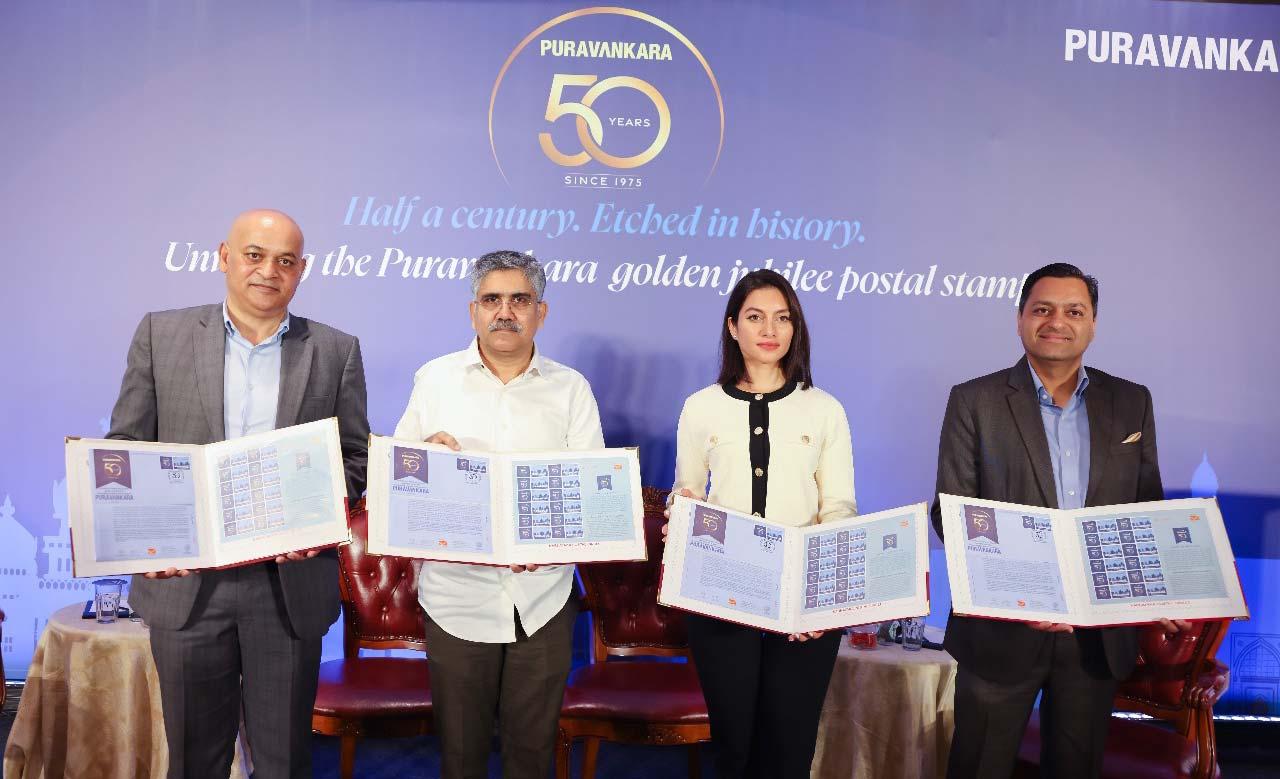
Bengaluru: Puravankara Limited (NSE: PURVA | BSE: 532891), one of India’s most admired and trusted real estate developers, today commemorated its 50-year milestone with the release of a customised ‘My Stamp’ by the Department of Posts, Government of India. The launch marks a significant moment in the company’s illustrious journey, honouring its legacy of excellence in building homes of international quality with trust and transparency since 1975.
The Golden Jubilee ‘My Stamp’ tells
the story of Puravankara, which began in 1975 in Mumbai, where the dream took root, and later found its home in Bengaluru, from where it expanded to nine cities.
The stamps’ bold, contemporary design marks the milestone years 1975- 2025 and proudly carries the Puravankara name, framed by iconic buildings from both Mumbai and Bengaluru - a nod to the cities that shaped its past and will shape its future. Clean lines, a celebratory palette, and its thoughtful symbolism make the stamp a timeless keepsake of the company’s
legacy and forward-looking spirit.
On the stamp release, Sri K. Prakash, IPOs Chief Postmaster General, Karnataka Postal Circle, said,” Stamps are not just miniature pieces of art - they are powerful storytellers of history, achievements, and culture. India Post has been engaged in the service of the people, and through initiatives like ‘My Stamp’, we celebrate the contributions of companies towards shaping India’s future.”
Sharing his thoughts on the occasion, Ravi Puravankara, Founder & Chairman, Puravankara Limited, said, “This is a moment of pride and reflection for all of us at Puravankara. The launch of the ‘My Stamp’ by India Post celebrates our 50-year journey and acknowledges the countless individualsemployees, partners, and customers - who have been part of this incredible legacy. From our humble beginnings in Mumbai to becoming a nationally respected brand, our foundation has always been built on trust, transparency, and timely delivery. As we look to the future, we remain committed to innovation, sustainability, and

creating a sustainable world for people to live their dreams.”
Speaking at the event, Amanda Puravankara, Additional Director, Puravankara Limited, added, ”The ‘My Stamp’ is more than a commemorative token; it is a symbol of the values we have nurtured over five decadescustomer centricity, quality, and enduring relationships. It is also a pledge to the future. We are embracing new technologies, green practices, and design excellence to meet the evolving aspirations of homebuyers. Our journey is far from over. The next 50 years will be about scaling new heights while staying rooted in our legacy.”
The stamp was officially unveiled
by Mr. K. Prakash, IPOs, Chief Postmaster General, Karnataka Postal Circle. The event was attended by senior dignitaries from India Post, including Sri Sandesh Mahadevappa, IPOs, DPS, Karnataka Circle; Smt. V Tara, IPOs, DPS, Karnataka Circle; Sri H. M. Manjesha, Chief Postmaster, Bengaluru GPO; and Sri Ranjith Kumar, IPOs, SSPOs Bengaluru East Division. Also present were Ms. Amanda Puravankara, Additional Director, Puravankara Limited; Mr. Mallanna Sasalu, CEO – South; Mr. Rajat Rastogi, CEO – West & Commercial Assets; the leadership team of Puravankara; and esteemed partners who have been part of the company’s five-decade-long journey.
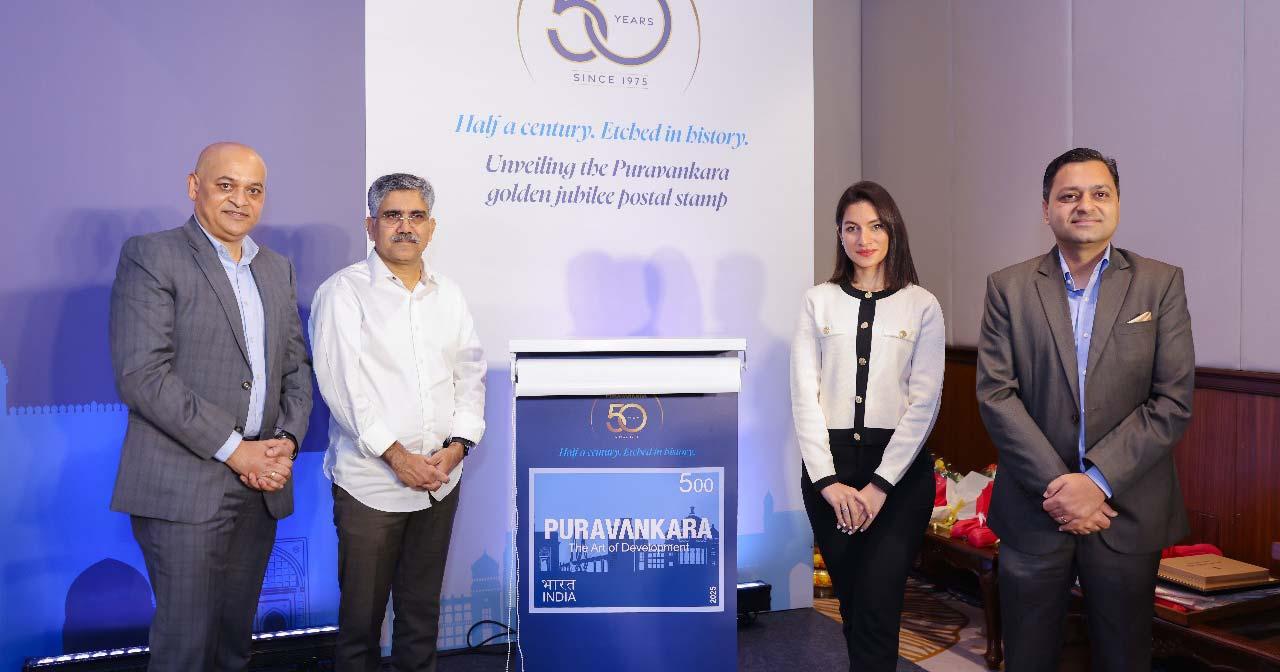

HOW NMDC IS GROWING FINANCIALLY, GEOGRAPHICALLY AND STRATEGICALLY HOW NMDC IS GROWING FINANCIALLY, GEOGRAPHICALLY AND STRATEGICALLY
INDIA’S LARGEST IRON ORE MINER, NMDC LTD, HAS BEEN SCRIPTING ONE OF THE MOST COMPELLING TURNAROUND STORIES IN INDIA’S PUBLIC SECTOR DOMAIN. UNDER THE ASTUTE LEADERSHIP OF CHAIRMAN AND MANAGING DIRECTOR AMITAVA MUKHERJEE, THE HYDERABADBASED MINER HAS NOT ONLY FORTIFIED ITS FUNDAMENTALS BUT ALSO REPOSITIONED ITSELF ON THE GLOBAL MAP WITH AMBITIOUS EXPANSION PLANS, AN INTERNATIONAL OFFICE IN DUBAI, SUSTAINABILITY AWARDS, AND THE POTENTIAL REVIVAL OF ITS KEY STEEL SUBSIDIARY.
In Q1 FY26, NMDC registered a record-breaking 31% jump in iron ore production, touching 11.99 million tonnes (MT), compared to 9.19 MT in the same quarter of the previous year. Sales also saw a 14% increase to 11.51 MT, marking one of the best quarters in the company’s history. June 2025 alone recorded NMDC’s highest-ever monthly production since inception, with 3.57 MT output and 3.58 MT in sales.
CMD Amitava Mukherjee credited this performance to “resilience, innovation, and a balanced strategy,” adding that NMDC is steadily moving toward its vision of leading India’s mining and steel sectors. These results are particularly significant given the industry’s cyclical nature and underline the company’s operational efficiency and strategic focus.
The last three years have been transformative for NMDC. After facing margin pressures and policy headwinds around 2021-22, the company emerged stronger by refocusing on core operations, enhancing efficiencies, and deploying capital prudently. This revitalization is clearly reflected in its fundamentals, including rising production volumes, improved realisations, and consistently strong EBITDA margins.
On the stock market, NMDC has rewarded investors handsomely. Its share price has more than doubled over the last three years, riding on improved earnings visibility, a high dividend yield of nearly 5% now, and continued government support for infrastructure and steel demand. The company has become a preferred play for both institutional and retail investors seeking value and stability.
In July 2025, NMDC conducted a pig iron auction from its Nagarnar steel plant where bids jumped to Rs 31,450 per tonne - a Rs 350/tonne increase from the last auction held just two weeks prior. Meanwhile, its iron ore auctions in Chhattisgarh fetched premiums of up to 15%, underscoring the strong demand for quality ore and the company’s pricing power in key markets. These improved auction
realisations have given NMDC better monetization of its volumes, contributing to higher profitability and returns.
Under Mukherjee’s leadership, NMDC has aggressively stepped onto the global stage. A major milestone was the inauguration of its international office in Dubai, which will act as a strategic hub for monitoring global mining opportunities, acquiring critical mineral assets, and building supply chain resilience for India’s clean energy ambitions.
“Dubai represents a gateway to global opportunity,” said Mukherjee, adding that NMDC is poised to “redefine the mining landscape” with this international expansion. The company is actively evaluating acquisitions in Africa, Australia, and South America, focusing on lithium, cobalt, copper, and other critical minerals vital to the energy transition.
To facilitate these global ambitions, NMDC is also setting up a whollyowned subsidiary at Gujarat’s GIFT City - likely to be named NMDC Global - which will serve as the investment holding company for all overseas ventures. With Rs 70,000 crore earmarked for projects over the next three years, including slurry pipelines and critical mineral ventures, the company is clearly betting big on international diversification.
Sustainability is emerging as a key theme in NMDC’s narrative. In July 2025, four of its mines were awarded the prestigious 5-Star Rating by the Indian Bureau of Mines - placing it among just 95 awardees out of over 1,200 operational mines. The rating recognises excellence in scientific mining, environmental protection, and social responsibility.
Mukherjee called the recognition a testament to NMDC’s “dedication to sustainability, innovation, and responsible mining.” This ESG focus not only boosts the company’s brand but also ensures its alignment with
global investor expectations and compliance mandates.
Perhaps the most exciting frontier for NMDC is the turnaround brewing at its key subsidiary, NMDC Steel Ltd. The steel plant in Nagarnar recently achieved a record hot metal output of 3,759 tonnes, operating at an impressive 117% of its blast furnace capacity. While this subsidiary is still in the red, revenue growth has been encouraging, and operational efficiencies are improving rapidly. With robust government support and synergies from its parent company, NMDC Steel appears poised for a full-fledged revival, which could significantly enhance NMDC’s consolidated earnings and investor appeal.
With a production goal of 100 million tonnes per annum by 2030, NMDC is actively seeking reservations for key iron ore blocks across India. These include strategic deposits in Odisha, Chhattisgarh, Karnataka, Maharashtra, and Jharkhand.
The company has cited the economically unviable premium rates of current auctions and has urged state governments to grant preferential leases for strategic mining. This kind of forwardlooking resource planning, coupled with a consistent performance record, sets NMDC apart as a cornerstone of India’s mineral selfreliance.
With visionary leadership, robust operational performance, a shareholder-friendly dividend policy, international expansion, and ESG leadership, NMDC is emerging as a national asset shaping India’s resource security and industrial growth. As NMDC Steel gears up for profitability, and critical mineral acquisitions gather steam, investors and stakeholders alike have enough reasons to be optimistic about NMDC’s next decade.
SATHYABAMA INSTITUTE OF SCIENCE AND TECHNOLOGY (SIST) IN CHENNAI, RENOWNED FOR ACADEMIC ACHIEVEMENTS AND INDUSTRY PARTNERSHIPS, IS RAPIDLY MOVING TOWARD REGIONAL PROMINENCE UNDER THE LEADERSHIP OF CHANCELLOR DR. MARIAZEENA JOHNSON. ITS CELEBRATED CONVOCATION CEREMONIES AND IMPRESSIVE PLACEMENT RATES HAVE EARNED WIDESPREAD ADMIRATION AMONG STUDENTS, PARENTS, AND RECRUITERS. YET, LIKE ALL AMBITIOUS INSTITUTIONS, SATHYABAMA’S JOURNEY IS NOT WITHOUT ITS SHARE OF CHALLENGES. CONCERNS REMAIN OVER AVERAGE STUDENT INTAKE QUALITY, CRITICISM OF THE RIGIDITY AND INTENSITY OF THE ACADEMIC EXPERIENCE, AND CALLS FOR GREATER DIVERSITY AND INTERNATIONALIZATION ON CAMPUS. THE UNIVERSITY HAS ALSO FACED ENVIRONMENTAL, ADMINISTRATIVE, AND RESEARCH-RELATED CHALLENGES THAT HAVE SPARKED DEBATE AMONG STAKEHOLDERS. AS SATHYABAMA PURSUES GROWTH IN PLACEMENTS, RESEARCH, AND GLOBAL REPUTATION, ONGOING SCRUTINY FROM ALUMNI, FACULTY, AND THE ACADEMIC COMMUNITY ENSURES THAT THE NARRATIVE IS DYNAMIC, REFLECTING BOTH PROGRESS AND THE IMPERATIVE FOR MEANINGFUL, STUDENT-CENTERED REFORM.



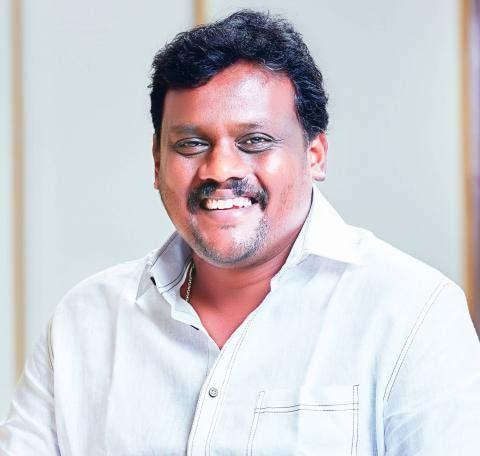
In the heart of Chennai’s bustling academic corridor stands a deemed university of progressive learning and transformational education, the Sathyabama Institute of Science and Technology (SIST). A name that has become synonymous with academic rigor, innovative research, and industry integration, Sathyabama has in recent years accelerated its ascent to regional prominence. Much of this transformation has been driven by the visionary leadership of Dr. Mariazeena Johnson, its dynamic Chancellor, whose commitment to excellence continues to steer the institution into the future.
However, as the university gains national attention, some voices have questioned whether the average quality of students admitted each year - as judged by public entrance and board exam marks - has kept pace with its rising ambitions. There is growing interest in seeing public data on whether this metric is on an upward trajectory, supporting the institution’s brand of academic excellence.
Recently, Sathyabama had opened its arms to celebration as it hosted its 34th Convocation Ceremony. Over 5,000 graduates proudly walked across the stage, receiving their degrees in a grand event held at the Institution Auditorium. The ceremony was an emotional and inspirational milestone, not just for the graduates but also for their teachers and families.
Among the attendees were Sathyabama’s top leadership, including Chancellor Dr. Mariazeena Johnson, President Dr. Marie Johnson, and the Vice Presidents J Arul Selvan, Maria Bernadette Tamilarasi, and Maria Catherine Jayapriya. The event was also graced by the presence of Indian filmmaker Atlee Kumar, a former Sathyabama student, who received an Honorary Doctorate for his remarkable contributions to Indian cinema.
Atlee Kumar’s emotional speech reminiscing about his early dreams and journey from the campus corridors to film sets struck a chord with the audience and added a touch of heartfelt pride to the ceremony.
Underlining the institution’s commitment to high standards, 54 Sathyabama students were conferred with gold medals for academic excellence, setting the stage for another generation of achievers to lead with both intellect and integrity.
And just two months earlier, Sathyabama’s sprawling campus was vibrant with pride and celebration as it hosted Excellence Day 2025. This annual event, which has become a tradition of institutional pride, was presided over by Dr. Mariazeena Johnson, alongside President Dr. Marie Johnson and the three young Vice Presidents.
What marked this year’s event as particularly special was the staggering 91.87% placement rate recorded for the final-year students. A total of 3120 job offers were extended by 303 companies, which is proof of Sathyabama’s deep-rooted industry partnerships and the consistent quality of its graduates.
Yet, a closer look at placement data raises pertinent questions among students and recruiters. While the overall numbers are high, there have been persistent concerns that many placement offers originate from lower-profile firms with below-average pay scales. Stakeholders are watching keenly to see what strategic steps management is taking to attract more premium recruiters and boost the quality of employment opportunities in line with peer institutions.
The campus placement drive saw the highest annual package touch Rs 41.2 LPA, but with the average package standing at a modest Rs 5.45 LPA. Among the recruiters were top-tier corporates such as Amazon, IBM, Oracle, Capgemini, Accenture, JP Morgan,
Cognizant, and TCS, placing Sathyabama among the elite engineering campuses in India.
But only around 40% of the offers were categorized as Dream, Super Dream, or Elite, a benchmark that reflects both the caliber of students and the evolving opportunities in the modern workplace.
Beyond India Inc., the global footprint of Sathyabama students was evident in the 216 students who secured admissions into leading universities abroad, aided by the Advisory Bureau for Higher Studies. Scholarships from prestigious institutions in the United States, Germany, the UK, Australia, Ireland, and France reflect the growing acceptance of Sathyabama’s academic programs.
Sathyabama’s consistent record in student employability is no accident. It is the result of an integrated academic and training ecosystem. The institute’s Centre of Excellence model, powered by collaborations with industry leaders such as Cognizant, HCL, Capgemini, PwC, and LTIMindtree, enables students to upskill in emerging technologies even before they graduate.
A dedicated Training and Placement Cell ensures that students are continuously groomed through workshops, mock interviews, coding marathons, and industry seminars.
Sathyabama students a competitive edge, both domestically and globally.
The campus of Sathyabama is a city in itself. Located along the Old Mahabalipuram Road (OMR) in Chennai, it is well connected and easily accessible by road, rail, and air. Inside the gates, students find a self-contained academic ecosystem complete with state-of-the-art facilities.
Sathyabama’s consistent record in student employability is no accident. It is the result of an integrated academic and training ecosystem. The institute’s Centre of Excellence model, powered by collaborations with industry leaders such as Cognizant, HCL, Capgemini, PwC, and LTIMindtree, enables students to upskill in emerging technologies even before they
While the emphasis on employability is clear, feedback from some alumni and current students has drawn attention to academic pressures and the limited flexibility in the curriculum. As the educational landscape shifts, there are calls for greater reforms to ensure learning is both holistic and less rigid, enabling students to discover their full potential in and out of the classroom.
Over 380 companies visited the campus in the 2024–2025 academic year, with placements cutting across sectors like Information Technology, Core Engineering, Finance, Consulting, Analytics, and Research. This breadth and diversity in the recruiter base is what gives
Yet the very location that offers vibrancy also poses risks, as highlighted by the severe campus flooding of 2023. This event underscored the urgent need for robust infrastructure planning and disaster preparedness. Many now look for evidence of concrete steps being taken by the university to mitigate and prevent such disruptions in the future, ensuring safety and continuity for all.
The central library, with over 5 lakh books and 16,000+ digital publications, remains the intellectual heartbeat of the campus. From a 100bed hospital offering 24x7 medical care, to fully equipped sports complexes with basketball courts, kabaddi grounds, cricket fields, yoga halls, and indoor arenas, the institute’s commitment to holistic development is clear.
Hostel facilities for both men and women, high-speed internet connectivity, auditoriums, and seminar halls further support a vibrant campus life.
For working professionals, the university’s approach to part-time and flexible learning has occasionally come under scrutiny. The invalidation of Sathyabama’s parttime MTech degrees in 2019 drew criticism, with many awaiting transparent updates on whether these programs have since been reinstated or replaced at undergraduate and postgraduate levels to serve adult learners effectively.
Academically, Sathyabama offers more than 100 courses

across undergraduate, postgraduate, and doctoral levels, spanning disciplines like Engineering, Science, Humanities, Law, Dental Sciences, Pharmacy, Management, Nursing, and Allied Health Sciences. Admission into core programs like BTech is conducted through its own entrance exam, the Sathyabama All India Entrance Examination (SAEEE). For postgraduate programs like MBA and MCA, scores from Sathyabama’s own entrance test too are considered. While academics span a broad landscape, some external observers note that the student body’s geographical and cultural diversity - especially from non-Southern states and overseas - remains relatively limited. Aspiring for regional leadership will likely require more outreach and initiatives to attract a greater mix of students to Chennai’s vibrant campus.
Sathyabama is recognized by the UGC, accredited at A++ grade by NAAC, and holding ISO 9001:2008 certification, Sathyabama is also listed as a Category-I University under UGC autonomy regulations. It is ranked 85th in the NIRF 2024 Overall category, and within the Top 1200-1400 globally as per QS World University Rankings 2026.
Sathyabama has actively forged academic MoUs with institutions across the world, including University of Western Australia, UNINT (Italy), and Taylor’s University (Malaysia). These collaborations have opened new avenues for joint research, student exchange, and dual-degree programs.
Still, there are critics within academia who believe that research at India’s private deemed universities is often measured by quantity rather than realworld impact. For Sathyabama, the challenge lies in ensuring that its expanding research ecosystem is underpinned by meaningful, world-relevant outcomes rather than just impressive metrics. Research and innovation are also front and center of Sathyabama’s mission. With multiple research centers and patents filed annually, students are encouraged to dive deep into problem-solving and inquiry-led learning.
respected name in higher education circles. She has not only expanded the academic footprint of Sathyabama but has also been instrumental in building partnerships that serve students’ aspirations.
Alongside her are President Dr. Marie Johnson, a driving force behind administration, internationalization, and digital transformation; Vice Chancellor Dr. T. Sasipraba, who leads academic affairs; and the trio of Vice Presidents - Maria Bernadette Tamilarasi, J Arul Selvan, and Maria Catherine Jayapriya - who lend strength to the institute’s strategic and operational leadership with their youthful energy. Together, this leadership team ensures that Sathyabama continues to adapt, evolve, and lead.
Sathyabama has a knack for blending culture and education. Some months back, cricketer Jasprit Bumrah had visited the campus for Fresher’s Day, interacting with new students and inspiring them with words of encouragement. His presence added star power to the event and showed the university’s commitment to giving students experiences that go beyond academics.
Sathyabama is recognized by the UGC, accredited at A++ grade by NAAC, and holding ISO 9001:2008 certification, Sathyabama is also listed as a Category-I University under UGC autonomy regulations. It is ranked 85th in the NIRF 2024 Overall category, and within the Top 1200-1400 globally as per QS World University Rankings 2026.
Leadership also faces questions about whether surging enrolments and program expansions are stretching faculty and support structures too thin. The need for careful management of faculty workload, the preservation of teaching quality, and the provision of more personalized student engagement is something that will define the next phase of Sathyabama’s growth story.
At the helm of Sathyabama’s extraordinary growth story is Chancellor Dr. Mariazeena Johnson, an academician, leader, and visionary. Her ability to balance institutional tradition with contemporary relevance has made her a
Sathyabama had also tied up with the Chennai Super Champs, a team in the World Pickleball League (WPBL), as a principal partner. The team is owned by actress Samantha Ruth Prabhu, who launched the team jersey on campus in a high-energy event that celebrated youth and sportsmanship.
This partnership reflects Sathyabama’s willingness to venture into new domains like emerging sports, leveraging its reach to foster engagement, excitement, and excellence among students.
As the world of higher education becomes more dynamic, competitive, and global, institutions that marry tradition with innovation will continue to thrive. Sathyabama Institute of Science and Technology is already on that path, with world-class facilities, visionary leadership, strong industry and alumni networks, and a growing international reputation.
Whether it’s through record-breaking placements, global university admissions, impactful research, or fostering community through sports and culture, Sathyabama is charting a bold and ambitious future. And at the center of it all remains a promise - to empower young minds to rewrite, re-dream, and rethink - just as Chancellor Dr. Mariazeena Johnson so eloquently urged during the convocation.
As students, parents, and recruiters look to Sathyabama with growing respect and anticipation, one thing is clear: the journey of excellence, though promising, will be most sustainable when challenges are openly addressed and reforms earnestly pursued.


As India aspires to become a major maritime hub, Cochin Shipyard Limited (CSL) stands at the center of that ambition. A PSU under the Ministry of Ports, Shipping, and Waterways, CSL is India’s largest shipbuilding and shiprepair facility. But as with any large public-sector enterprise navigating highgrowth waters, the journey of CSL is anything but a straight sail. However, Cochin Shipyard is overcoming all its challenges, one by one, under the visionary leadership of its Chairman & Managing Director Madhu S Nair, one among India’s most qualified and most experienced ship building engineers.
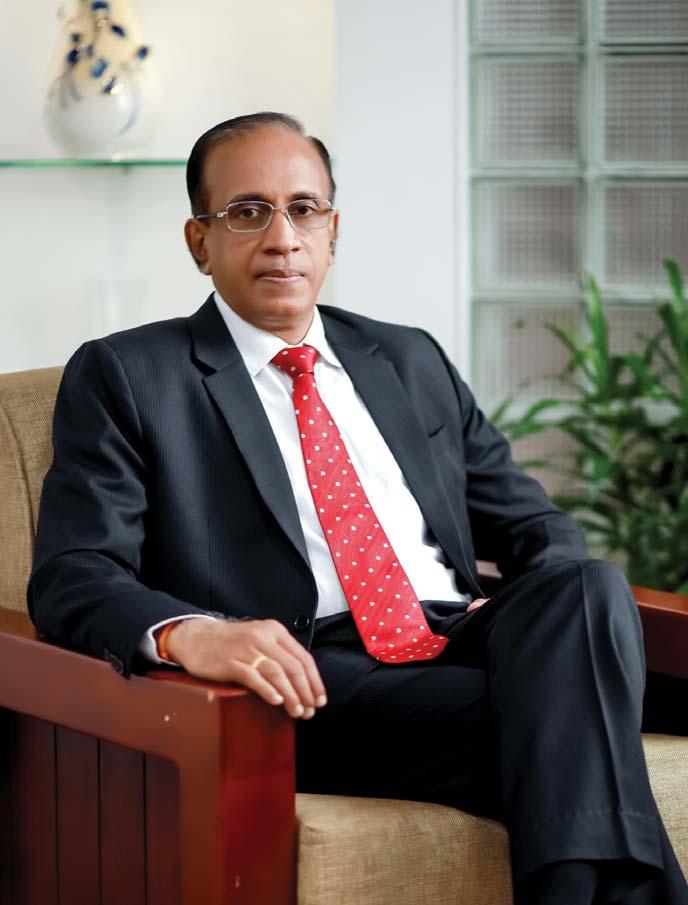
Madhu S Nair Chairman & Managing Director
CSL’s recent performance and strategic tie-ups reveal a complex picture of promise, pressure, and potential challenges. With strong topline growth, high-profile international collaborations, and a robust order book, the fundamentals are impressive. However, profitability stress, valuation concerns, and an overdependence on geopolitical uncertainty for outperformance pose challenges on the horizon.
Cochin Shipyard Limited (CSL), under the dynamic leadership of Chairman & Managing Director Madhu S. Nair, kicked off FY26 with a standout Q1 performance, further cementing its stature as India’s premier shipbuilding and ship-repair enterprise. Revenue for the quarter surged 38.5% year-on-year to Rs 1,068 crore, powered by robust execution of shipbuilding and ship repair contracts as well as deliveries of technologically advanced vessels.
Operating efficiency continued, reflected in a healthy EBITDA performance.The EBITDA for June 2025 quarter was Rs. 296 crores and EBIDTA margin was 28%. EBITDA for the June 2024 quarter was 261 crores and EBITDA Margin was 34%.
strageic leadership continues driving technology upgrades, international forays, and operational excellence.
With a robust order book and projects in the pipelinee, CSL has secured revenue visibility for years ahead. This includes defence mega-projects like next-generation corvettes, frigates, and civilian orders like bollard pull tugs and luxury cruise ships for the Brahmaputra River. The newly signed order with Polestar Maritime for two high-powered tugs alone is worth Rs 250 crore. Earlier, for the full fiscal of FY25, Cochin Shipyard’s revenue had climbed 26% to Rs 4,820 crore. This is a significant jump for a capital-intensive business and reaffirms CSL’s execution capability
Perhaps the biggest feather in CSL’s cap is its July 2025 MoU with South Korea’s HD Korea Shipbuilding & Offshore Engineering (KSOE), a Hyundai group company. This partnership includes joint shipbuilding initiatives, technology transfer, workforce upskilling, and infrastructure upgrades, which make this a strategic collaboration that could dramatically elevate CSL’s global competitiveness.
Although CSL has aggressive expansion plans, execution remains key. PSU enterprises often grapple with slower decision-making, labour issues, and tender-based bureaucracies that can delay project timelines.
CSL’s R&D investments are forwardlooking, from battery-electric “green tugs” to hydrogen-fuel-cell ferries and autonomous surface vessels. The company has also floated a tender for connecting a 500 kWp solar plant to support sustainable operations. In an era where ESG compliance matters, these initiatives bolster CSL’s positioning as a modern, responsible shipbuilder.
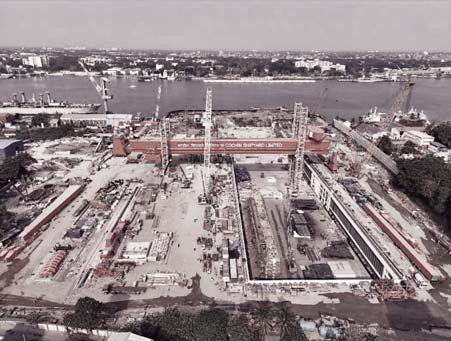
Net profit for Q1 stood at Rs 188 crore, up a modest 8% year-on-year despite the cost escalations, showing margin restraint but resilient bottom-line delivery. Segmental revenues detail strong contributions from ship repairs at Rs 630 crore and shipbuilding at Rs 439 crore, highlighting the benefits of a diversified business model.
CSL’s balance sheet remains robust with low net debt, and its order book stands at an impressive Rs 21,100 crore, backed by a forward pipeline nearing Rs 2.85 lakh crore. Strategic partnerships inked this quarter with global industry leaders, capacity upgrades at dry dock and repair facilities, and expansion into advanced ship types are expected to unlock new growth horizons. Madhu S. Nair’s
amidst a recovering global maritime ecosystem.
Cochin Shipyard, which shot into limelight by building India’s first indigenous aircraft carrier INS Vikrant, continues to pursue such unique projects. Around 40% work is complete on what is billed to be India’s largest and most advanced dredger, being built in collaboration with the Netherlandsbased Royal IHC.
However, CSL is part of the broader defence index, which can be volatile especially in face of geopolitical deescalation. Defence stocks, including CSL, tend to rally in times of global conflict or rising tensions and correct sharply when peace prospects emerge. This dependency creates a cyclical narrative, where investor sentiment is often influenced more by global news headlines.
The shipyard has also entered into multiple MoUs, notably with Dubai’s Drydocks World, to build world-class ship repair and fabrication hubs. These moves are expected to enhance CSL’s topline and diversify its clientele beyond Indian defence forces.
For long-term investors betting on India’s maritime rise, CSL offers a compelling narrative, with strong government support, world-class collaborations, and a diversified order book. Its past work on India’s first aircraft carrier INS Vikrant lends it credibility in complex defence builds.
Cochin Shipyard is going through a pivotal phase. It has the orders, partners, and political support to become a global force in shipbuilding. Under CMD Madhu S Nair’s guidance, CSL is turning this promise into performance, step by step, by tightening margins, executing better, and broadening its vision beyond defence. If the global growth momentum remains in its favor, CSL and its investors are destined to reach greater shores.
THIS SCIENCE-BACKED APPROACH WILL CURE YOUR PROCRASTINATION WITH PRACTICAL TO-DOS.

e’ve all been guilty of enthusiastically penning a comprehensive to-do list, only to then put it off until the very last moment. But what if I told you that there’s a science-backed way to overcome mental roadblocks and tackle your home refresh chores in a fun way?
And that’s through dopamine anchoring. This science-backed method helps you associate otherwise taxing things like decluttering your home with a positive feeling, which makes ticking off chores and making progress a whole lot easier.
Now, let’s gain a deeper understanding of what dopamine anchoring entails, how it benefits us, and how to activate it at home. Associating positive thoughts through rewards is at the heart of this concept.
“Dopamine anchoring refers to a psychological technique of using conditioning to intentionally pair a behavior someone might usually avoid doing with a pleasurable reward,” says Dr. Ashwini Nadkarni, assistant professor of psychiatry at Harvard Medical School.
“This way, your brain forms an association between something that’s either unpleasant or neutral with something that generates a dopamineboosting stimulus, and over time, links the two together to enhance motivation.”
Let’s be real, your home will encounter plenty of different types of mess, especially with the festive season slowly creeping up. And to tackle each space, you will need some sort of motivation to help you through it. This is one situation where dopamine anchoring
comes in handy.
By using dopamine anchoring, you can overcome any mental decluttering roadblocks. Anna Tatsioni, design director at Decorilla, explains that dopamine anchoring is all about pairing the good with the bad to make tasks and chores manageable. So blending this concept with easy home organization ideas or actioning it alongside your decluttering schedule is super helpful.
“Most interior designers and homeowners who have renovated will be all too familiar with how overwhelming decluttering can be. It’s an inevitable first step in most interior design projects, and to make this much more enjoyable (and less mentally taxing), I recommend dopamine anchoring,” she says.
“For example, I save a new episode of my favorite podcast to listen to while I sort through items. Another option is rewarding myself with a sweet treat after finishing a room. As long as I’m sandwiching the chore of decluttering with a positive experience, it makes the process feel less like a chore and more like part of the creative process.”
By pairing the task of organizing with something that feels good, Anna finds that dopamine anchoring keeps momentum high and helps transform cluttered rooms into clean canvases that are ready for an update. “It’s a small psychological trick, but it can make the process of preparing a home for interior styling far more enjoyable and satisfying,” she notes.
Take your time and don’t rush the process of learning how to use dopamine anchoring to your advantage.
“Dopamine anchoring works because we are working with our preferences and interests rather than trying to force habit changes and motivation with willpower alone,” says cognitive behavior therapist Caitlyn Oscarson. “This allows change that feels like it’s going along with the current instead of pushing upstream.”
(Credit: Amiya Baratan, Livingetc)
By Sudhakar Rao, Director, ICFAI Group


Aspectacular trek through the Andes recently reunited fifteen childhood friends on a journey both across continents and through time. Led by Sudhakar Rao, Director at ICFAI Group, the group - now professionals spanning medicine, technology, law, and education - embarked on the classic Inca Trail to Machu Picchu. Winding through cloud forests, rugged passes, and ancient ruins, this fourday adventure became much more than a test of endurance. It transformed into a profound rediscovery of camaraderie, shared leadership, and inner resilience. As the travelers overcame high-altitude challenges and shifting climates, they not only witnessed the mystical majesty of Machu Picchu but also rekindled the lessons of trust and teamwork. Here is a glimpse into a journey where friendship soared, and leadership found its true rhythm amidst history and nature.
September 7–11, 2025
By Sudhakar Rao, Hyderabad-based Brand Strategist, Author, and Education Leader
The team had Doctors from Hyderabad: Dr Praveen Mereddy, Dr Shashi Kanth Godey, Dr Nikhil S Ghadiyalpatil; a Doctor from Nalgonda: Dr Gummi Sreekanth; a Doctor from Dubai: Dr Sri Sailesh Vittala; a Doctor from UK: Dr Sanjay Rajpara; IT Professionals from Bengaluru: Vijay Bhaskar & Siva Sankar; a Contractor from Nalgonda: Prudhveedhar;
IT Professionals from the UK: Purshotham & Krishna Mohan; an IT Professional from Hyderabad: Prasanna Kumar; an IT Professional from US: Ravi Medishetty; a Lawyer from Hyderabad: Ramesh Vishwanathula; and Education Leader from Hyderabad: Sudhakar Rao.
THE CLASSIC INCA TRAIL:
The Inca Trail is more than a trek - it’s a time-traveling corridor winding
A group of fifteen childhood friendsnow doctors, IT professionals, lawyers, and educators - recently completed a journey that was as inward as it was outward. The destination: the mystical ruins of Machu Picchu in Peru. The route: the legendary Inca Trail - 43 kilometers of high-altitude trekking through the sacred spine of the Andes.
through cloud forests, alpine tundra, and ancient stone pathways etched by the Incas over 500 years ago. The trail leads to the crown jewel of Incan civilization: Machu Picchu, perched 2,400 meters above sea level.
The journey began at Km 82 near Piscacucho, with the group collecting their gear and spirits. Over four days, the trail unfolded like a storybook, each chapter marked by ruins, panoramic vistas, and rising breathlessness.
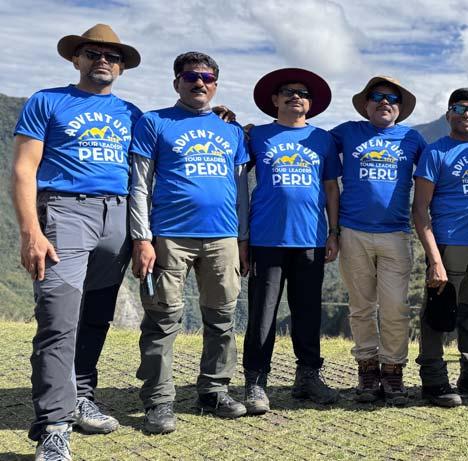
Four Days. 43 Kilometers. One Four Days. 43 One Days. Unforgettable Experience. Unforgettable Experience.
Day 1: Day 1: Day 1: Day 1: Day 1: KM 82 to Wayllabamba
Distance: ~12 km | Duration: Distance: ~12 km | Distance: ~12 km | Duration: Distance: ~12 km |
~12 km |
The group eased into the trek with scenic riverside trails, and camped under Andean stars at Wayllabamba (3,000m). Spirits were high and expectations even higher.

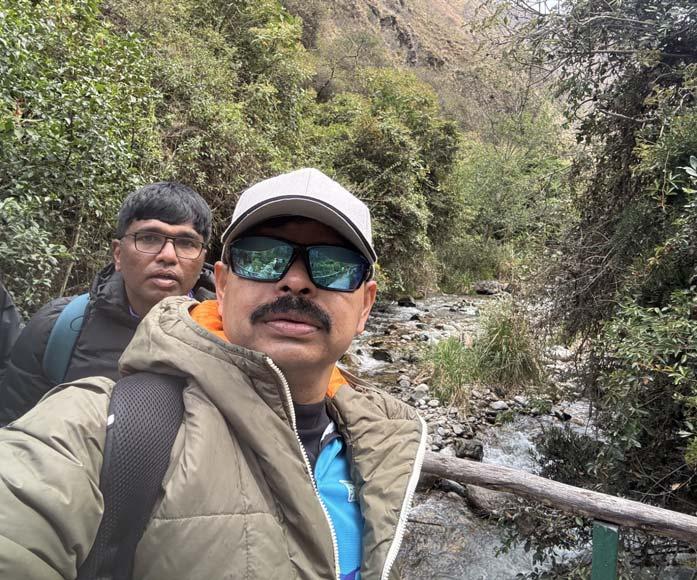
Day 3: Day 3: Day 3: Day 3: Into the Cloud Forests
Distance: ~16 km | Duration: 8-10 hours
Day 2: Day 2: Day 2: Day 2: Day 2: The Killer Climb to Dead Woman’s Pass
Distance: ~16 km | Duration: 10-12 hours
The most grueling day involved climbing to Warmiwañusca (Dead Woman’s Pass) at 4,215 meters. Oxygen was thin, but the sense of accomplishment was overwhelming.
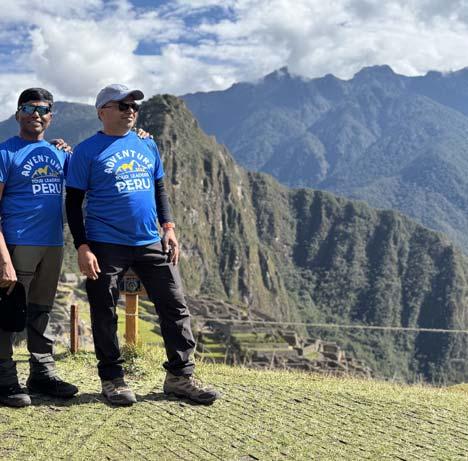
Passing Runkurakay, Sayacmarca, Phuyupatamarca, and Winaywaynaarchaeological jewels still whispering ancient wisdom - the group camped at the edge of civilization and history.
Day 4: Day Day 4: Day The Final Descent to the Sun Gate
Distance: ~6 km | Duration: 3-4 hours
Pre-dawn, everyone set out for Intipunku (Sun Gate) at sunrise, where Machu Picchu appeared, wrapped in mist and silence, leaving all speechless.
Tents, Temperatures & Tenacity
Sleeping in tents for three nights, the group braved temperatures dipping to 4–6°C at night and 10–16°C during the day. Each step required fitness, mental stamina, and careful acclimatization. Two days stretched to 10+ hours of trekking, paused only for lunch breaks and moments of shared laughter.
What We Learned Along the Way
The trail humbled everyone, highlighting the power of friendship and resilience of ancient engineering,
and underscoring the importance of preserving natural heritage. For fifteen former classmates, this journey was a new classroom - carved in stone, cloud, and time.
V-Formation Leadership: Lessons from the Sky
In nature, birds travel in v-formations to save energy and ensure collective progress. The lead bird rotates, with others stepping forward as needed. Inspired by this, Team SAMBA 20D rotated leadership daily, choosing trek leaders based on fitness and spirit. This approach fostered shared responsibility, visible support, and spontaneous moments of compassion - proof that true leadership emerges through mutual trust and cooperation.
Machu Picchu is more than a UNESCO site or a photo backdrop; it symbolizes balance - between nature and architecture, past and present, effort and enlightenment. Walking the Inca Trail is a step into history, with sore calves and full hearts. To trek as SAMBA 20D was to soar, for a brief time, in vformation across the sky of memory.
SEASONAL MAGAZINE
Amid a dynamic year for the Indian banking sector, Jana Small Finance Bank continues to embody a narrative of optimistic progress against significant headwinds, powered by its visionary leadership and a steadfast emphasis on inclusive growth. The Bengaluru headquartered bank, was not too long back the nation’s largest microfinance institution, but has now evolved into a leading player in the small banking space. Under the guidance of Founder & Director Ramesh Ramanathan, and MD & CEO Ajay Kanwal, Jana SFB’s current strategic intent is transformative, to become a universal bank.
Ajay Kanwal, a seasoned banker known for his resilience and turnaround expertise, has helmed the organization as CEO since 2017, through complex phases, including disruptions caused by the COVID-19 pandemic, regulatory tightening, and volatile market cycles.
Despite short-term profit turbulence, the leadership’s intent and tactics have garnered both internal and external recognition for steering the institution out of repeated industry headwinds and for laying out a sustainable path forward.
In the most recent Q1 ending June 2025, Jana SFB reported a net profit of Rs 102 crore, marking a notable dip of 40% from the Rs 171 crore recorded a year earlier. The dip, driven by higher provisions and cost pressures, was apparently a setback.
However, looking deeper, the quarterly operating income actually climbed 7% year-on-year, with strong deposit growth of 24% and a demonstrable improvement in the credit-to-deposit ratio, which fell from 102.1% in Q1FY25 to 94.6% in Q1FY26, signifying greater prudence in balancesheet management.
Notably, the bank accelerated its provisioning, allowing it to absorb bad loan shocks and provide for any assetquality concerns upfront, which is a sign of evolving maturity in risk management and conservative accounting.
Jana SFB leadership’s response to these challenges has been swift and multifaceted. Ajay Kanwal had expressed confidence in the bank’s positioning, pointing to the market’s strong macroeconomic fundamentals
Ajay Kanwal, MD & CEO

and accelerated opportunities across housing finance, rural lending, and MSME financing.
Additionally, the bank’s collection efficiency in the microfinance segment now stands at an impressive 98.6%. Though the microfinance sector faces lingering stress, recovery is underway and management expects FY26 to mark a positive inflection point, particularly as lending conditions normalize and unsecured lending, a significant growth lever, resumes in a calibrated manner.
A landmark development in Q1 was Jana SFB’s formal application to the Reserve Bank of India for a universal banking license, a step that only a select few peer SFBs have taken. The foundation for this bold move was laid by consecutive years of meeting stringent asset-quality norms, with gross NPAs below 3% and net NPAs below 1%.
For customers and stakeholders, this transition, if and when it happens, promises broader product offerings, more favorable borrowing costs, and an enhanced digital experience. The Jana leadership emphasizes that every obstacle it has faced till now, including industry-wide credit cycles and the adversity of the pandemic, has served as a proving ground, reinforcing
operational resilience and commitment to their mission of financial inclusion.
Simultaneously, the bank continues its journey to diversify and de-risk its loan book. The proportion of secured loans has risen sharply, from 60% in FY24 to nearly 70% in FY25, while reliance on unsecured lending has reduced to just the remaining 30%. This shift, coupled with the use of credit guarantees for significant portions of the microfinance book, is enabling more predictable asset quality and lower future credit costs.
Unit-level risk management and disciplined execution empower the bank to weather near-term volatility while keeping its long-term growth ambitions intact. Jana SFB’s agility is also mirrored in its ability to take advantage of regulatory changes.
With the Reserve Bank easing priority sector lending targets for SFBs from 75% to 60%, and with the recent repo rate reductions and CRR cuts, the environment is ripe for the bank to lower its cost of funds and boost net interest margins in the coming quarters. Management is confident that these tailwinds, combined with the bank’s calibrated asset growth and continued technology-led innovations, will set the stage for a robust and profitable expansion.
The efforts of Founder Ramesh Ramanathan and CEO Ajay Kanwal have not gone unnoticed. Industry observers credit the management with not only achieving strong pre-provisioning operating profit growth, but also for their ability to balance short-term earnings volatility with long-term franchise value creation. The bank remains deeply committed to its original mission of serving the underserved and driving financial inclusion, with a modern, digitized platform and extensive, growing reach across India.
Like most of its peers, Jana Small Finance Bank has encountered its fair share of difficulties, and its latest Q1 numbers too tell a story of challenges, resilience, adaptability, and an unyielding pursuit of growth. Guided by strong leadership and prudent strategy, the bank continues to turn every challenge into an opportunity, shaping its story as a formidable force ready to enter a new emerging era in Indian banking.
ARE ATHLETES BORN OR MADE? A NEW STUDY REVEALS WHICH FITNESS TRAITS ARE PRIMARILY GENETIC. IF YOU FEEL LIKE YOUR ATHLETIC PERFORMANCE IS FALLING SHORT, THIS NEW RESEARCH MIGHT EXPLAIN WHY
Iran elementary school cross country for the first time when I was in third grade. The main thing I remember about our practices was that we spent a lot of time trying to touch our toes, and I was terrible at it. Years later, that would become a reassuring memory, because as a teen and adult runner I spent hours each week stretching and yet remained absurdly inflexible. I even have a kindergarten class photo where all the other kids are sitting happily cross-legged while I’m clearly uncomfortable, my knees nearly touching my chin. This is a fitness affliction shaped by my genetics, not a reflection of my laziness and hate of stretching.
So it’s no shock to me that a new study finds that, of all fitness domains, flexibility is the one most determined by your genes. The study, which is published in Medicine & Science in Sports & Exercise, uses data from twin pairs to tease out the respective contributions of genes and environment—talent and training, you might say—for fifteen different fitness tests. Overall, the results support the notion that picking your parents well is a crucial step on the road to athletic stardom, but they also reveal some surprising nuances about how nature and nurture interact.
An international team of researchers led by Karri Silventoinen of the University of Helsinki tested a group of 198 pairs of twins between the ages of 6 and 18 in the Portuguese archipelago of Madeira. All the twins completed a battery of 15 fitness tests, and the results were analyzed to figure out how much of the variation between individuals

was determined by their genes versus their environment.
The key point is that 78 of the twin pairs were identical, meaning that they share exactly the same DNA, while the rest were fraternal (or sororal), meaning that they share on average half of their DNA. If the results of a given test are more similar within identical twin pairs than fraternal pairs, that indicates that there’s a genetic influence.
You can split the role of the environment into two components. There are shared environmental factors, like the neighborhood you grow up in, your socioeconomic status, the opportunities available to you to play sports, and so on. And there are unique environmental factors, which reflect your particular path through life: whether you joined a sports team or
broke your ankle or had a great gym teacher. Surprisingly, in contrast to some earlier data, the effects of shared environmental factors appeared to be negligible in the new study, so the analysis focused only on genetic and unique environmental factors. The 15 fitness tests came from two different standardized testing batteries. Eurofit involved the flamingo test (balancing on one leg), plate tapping (moving your hand back and forth between two plates as quickly as possible to test reaction time and quickness), sit-and-reach (touching your toes from a sitting position), standing long jump, handgrip, sit-ups, bent arm hang (holding the top position of a pullup for as long as possible), shuttle run of 10 times 5 meters, and 12-minute run/walk. Fitnessgram involved sit-and-
IN THE VIBRANT HEART OF HYDERABAD STANDS THE ICFAI FOUNDATION FOR HIGHER EDUCATION (IFHE), A DEEMED-TO-BEUNIVERSITY THAT IS REDEFINING THE CONTOURS OF MODERN HIGHER EDUCATION IN INDIA. RECOGNIZED BY THE UNIVERSITY GRANTS COMMISSION (UGC) AS A CATEGORY-I INSTITUTION AND ACCREDITED WITH AN A++ GRADE BY NAAC, IFHE HAS EMERGED AS A POWERHOUSE OF INNOVATION, ACADEMIC EXCELLENCE, AND INDUSTRY-READY EDUCATION. WITH A SPECTRUM OF CONSTITUENT SCHOOLS, INCLUDING THE RENOWNED ICFAI BUSINESS SCHOOL (IBS), ICFAITECH, ICFAI LAW SCHOOL, ICFAI SCHOOL OF ARCHITECTURE (ISARCH), AND THE ICFAI SCHOOL OF SOCIAL SCIENCES (ISOSS), THE UNIVERSITY IS SCULPTING FUTURE-READY PROFESSIONALS WHO ARE GLOBALLY COMPETENT AND SOCIALLY CONSCIOUS.
A A A A A
t the helm of this academic renaissance is Dr. C. Rangarajan, one of India’s most distinguished economists, serving as the Chancellor of The ICFAI Foundation for Higher Education. His intellectual legacy and governance philosophy continue to shape IFHE’s policies and vision. Under Vice Chancellor Prof. LS Ganesh, IFHE has diversified its offerings, digitized delivery systems, and strengthened its research capabilities.
The leadership team also includes, Prof. K S Venu Gopal Rao, Director of ICFAI Business School (IBS), who steered the school to renewed AACSB re-accreditation in 2025, and Prof. KL Narayana, Director of IcfaiTech, who promotes innovation-driven technical education.
Other key leaders at IFHE include Prof. P. Ravisekhara Raju, Director
of ICFAI Law School, who leads the blending of legal theory with practice; Prof. Ar. Munavar Pasha Mohammad, leading ISArch with global design thinking; and Prof. Dr. C. S. Shylajan, directing ISoSS into new realms of social science research.
Few metrics are as telling of an institution’s success as its placement record. IFHE’s 2024 placement season turned out to be a resounding success across its schools, showcasing its strong industry connect and the relevance of its curriculum.
At IBS Hyderabad, 94% of the MBA students have secured placements. Over 170 top corporates - including Deloitte, Google, EY, Amazon, KPMG, PwC, and TCS – regularly participate in the campus selections.
IcfaiTech, the Faculty of Science and Technology, also recorded strong
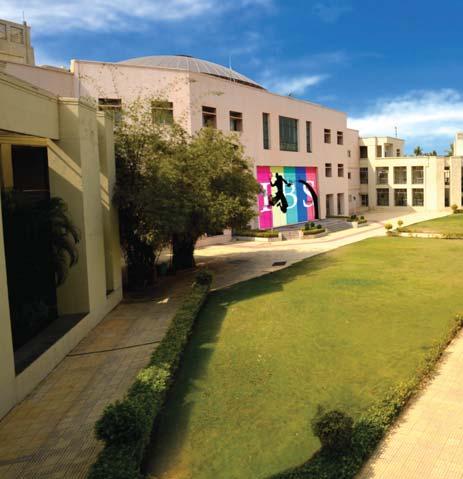
numbers, with engineering graduates placed in top firms like Cognizant, HCL, Accenture, Capgemini, Mahindra, and Amazon, illustrating the School’s effectiveness in preparing students for real-world challenges.
Admissions at IFHE are rigorous, transparent, and inclusive. For ICFAI Business School, the national-level IBSAT entrance test forms the gateway to admission, recently updated to replace traditional group discussions with micro presentations, reflecting a forward-thinking shift towards evaluating holistic communication and thought clarity. At the undergraduate level, IcfaiTech and ISArch admit students through various national and institutional entrance tests. The Law and Social Sciences Schools also attract diverse talent from across the country, maintaining academic diversity and interdisciplinary engagement at their core.
In line with global trends and the digital transformation of education, IFHE offers fully online MBA and BBA programs - ideal for working professionals and students seeking flexibility without compromising on quality. These programs provide 24/ 7 access through a mobile-friendly Learning Management System (LMS), offer practical components like
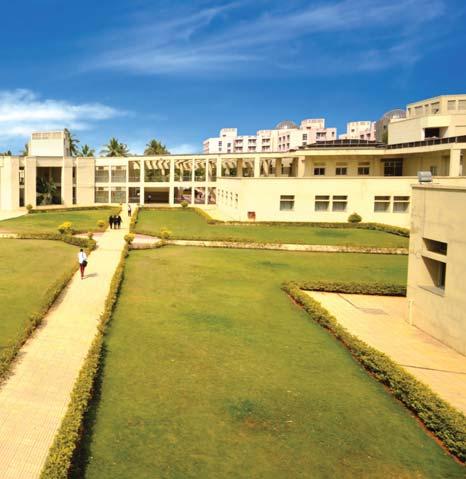
entrepreneurship practicums and internships, and cover a comprehensive curriculum that balances academic theory with industry relevance.
The online MBA, in particular, caters to graduates looking to upskill and transition into leadership roles. Meanwhile, the online BBA acts as a foundation for younger aspirants targeting careers in business, finance, and marketing.
Innovation thrives at IFHE - not just within labs and classrooms, but as a vibrant entrepreneurial culture. The ICFAI Incubator’s recent MoU with T-Hub Foundation is a case in point. The partnership aims to support techdriven student startups through mentorship, infrastructure sharing, and investor networks.
Importantly, startups can now be part of students’ mandatory internships, allowing academic research to be transformed into viable commercial ventures. T-Hub, which
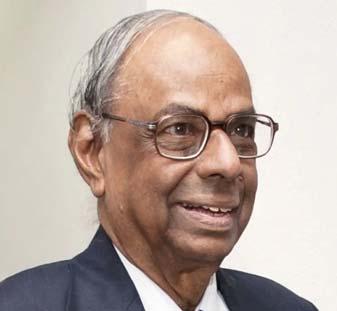
Dr. C. Rangarajan, Chancellor
stands for Technology Hub, is promoted by Telangana Government and several key institutions, and is home to over 2000 startups that have raised nearly $2 billion so far.
This approach helps students gain credit while building real-world solutions, fulfilling IFHE’s mission to bridge the gap between academia and industry and nurture a new generation of socially responsible entrepreneurs.
Research and policy dialogue are key pillars at IFHE. A two-day international conference recently hosted by ICFAI Law School, titled ‘Navigating the Future of Environmental Governance’, drew participation from legal experts, academics, and sustainability leaders. Emphasizing the integration of legal frameworks and finance in environmental policy, the conference illustrated IFHE’s commitment to shaping future-ready public leaders and legal scholars.
One of the standout additions to IFHE’s academic portfolio is its interdisciplinary PhD in Development Studies and Public

Policy, a unique offering in India. Designed for working professionals, this program emphasizes empirical research, data analytics, and qualitative methodologies. It aims to create thought leaders capable of designing and implementing development policies based on realworld data.
“This program is a game-changer in how we train public policy professionals,” says Dr. Sushanta Kumar Mahapatra, Associate Professor at ISoSS and a recipient of the NJ Yasaswy Best Teacher Award. His expertise and accolades underscore the caliber of faculty spearheading this new academic frontier.
A university’s true strength lies in its faculty, and IFHE boasts some of the most respected academic minds in the country. While Dr. Sushanta Kumar Mahapatra received the NJ Yasaswy Best Teacher Award for excellence in teaching, research, and industry engagement, IFHE’s administrative leaders too have won accolades.

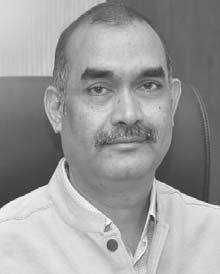
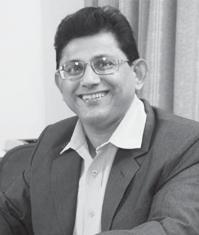
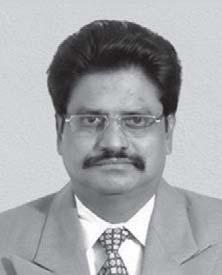
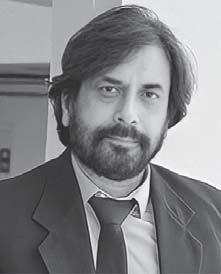

Accreditation is the benchmark of quality, and IFHE stands tall with an ‘A++’ grade from NAAC and recognition as a Category-I institution by the UGC. IBS Hyderabad is among the select 24 institutions in India accredited by AACSB (Association to Advance Collegiate Schools of Business International) - placing it in elite global company with fewer than 6% of business schools worldwide holding this distinction.
Across 68 countries and territories, AACSB has accredited only 1,051 institutions with only 24 b-schools in India being accredited. by the AACSB. Recently, ICFAI Business School (IBS), Hyderabad, secured re-accreditation from AACSB in May 2025. IBS had received the first accreditation from AACSB in March 2020, when the peer review team, which visited IBS Hyderabad, assessed the school on nine distinct standards and granted the initial accreditation.
On the remarkable achievement of reaccreditation, IBS Director Prof. KS Venu Gopal Rao said the School successfully received an extension of
its AACSB accreditation for a period of six years after a positive recommendation from the peer review team and ratification by the AACSB Board of Directors.
This accreditation extension is strong proof of the strength of IBS across the academic processes, quality management programmes, societal impact, sustainability principles, faculty research and community engagement.
In the 2024 NIRF Rankings, IFHE’s flagship ICFAI Business School was ranked 39 in the Management category. These achievements are not just badges of honor - they validate IFHE’s holistic academic model that
combines teaching excellence, research output, and industry relevance.
Education is not just about degreesit’s about nurturing responsible, aware, and healthy young citizens. IFHE’s ‘Niramaya Tarang’ antinarcotics initiative, launched in January 2025, is an inspiring example. With a powerful logo symbolizing wellness and positive ripple effects, this initiative includes awareness campaigns, street plays, workshops, and collaborative programs to combat drug abuse on campus.
“The initiative is part of our broader mission to provide a safe and healthy educational ecosystem,” says Dr. S. Vijayalakshmi, IFHE’s Registrar. The student-led Nukkad Natak performances have become particularly impactful, creating awareness through art and storytelling.
With its commitment to academic excellence, inclusive access, and nation-building, IFHE is more than just a university, but a mission to secure the futures of its students. It is creating a diverse community of future business leaders, engineers, lawyers, architects, policymakers, and researchers who are ready to take on the world.
As the education sector in India undergoes seismic shifts driven by AI, global mobility, and digital transformation, IFHE stands at the vanguard, by innovating, evolving, and inspiring. With a growing alumni worldwide, strong industry linkages, and a growing global reputation, IFHE is poised to play a pivotal role in shaping India’s knowledge economy.
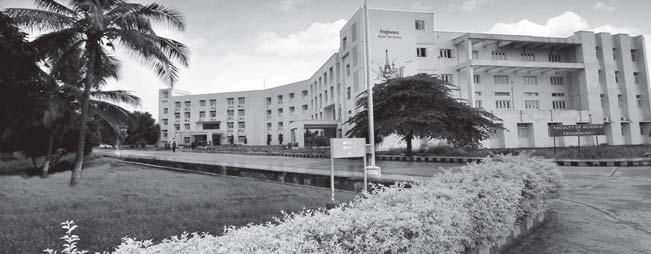
LEARN HOW TO CHECK YOUR LUNG HEALTH AT HOME WITH THE SIMPLE BOLT BREATHING TEST. KNOW HOW IT WORKS, WHAT YOUR SCORE MEANS, AND EXPERT TIPS TO IMPROVE BREATHING. HEALTH
Most of us breathe without thinking. After all, breathing occurs automatically. When we experience gradually decreasing airflow and known decreases in lung function, we often take it for granted and do not realise we are having difficulty until we struggle performing usual tasks like exercise, climbing stairs, or recovering from an illness.
The BOLT, also known as the Body Oxygen Level Test, is a simple choice to monitor your respiratory health at home. You can learn a lot about how you breathe and use oxygen from the test! It can provide you with a certain degree of clarity regarding your total body function.
In a conversation with Dr Sushil Jain and Dr Girish Agrawal, Senior Consultant, Pulmonology, Ramakrishna Care Hospitals, the doctor said, “The BOLT test measures how long you can comfortably hold your breath after a regular exhalation. It is worthwhile noting that during the BOLT test, there is no set time to hold your breath. The BOLT test ends as soon as you consciously realise the impulse to take a breath. This is more efficient at assessing how your body uses oxygen and manages carbon dioxide than any other type of breathhold test.”
Higher BOLT scores indicate that your body’s tissues have received sufficient oxygen to serve their proper function. Lower scores indicate possible situations like decreased tolerance to CO , COPD, hyperventilationinduced anxiety, asthma, and/or overbreathing.

So, how to take the BOLT test yourself? First, sit relaxed and breathe through your nose.
1. After taking a normal breath in and then expelling all of the air to exhale, gently pinch your nose shut so that the airway through your nose will close.
2. Start the timer immediately.
The BOLT test is not only for patients with symptoms; there is also the opportunity for prevention. It takes mere minutes to do a BOLT assessment and can give you some useful information regarding lung health.
3. Stop the clock when you feel the first strong urge to breathe. This is not going to be distressing, although you will know your breathing needs to be addressed, whether it is chest tightness or a swallowing reflex or the first contraction of your breathing muscles.
4. Your total score in the BOLT Test will be the total time in number of seconds you recorded.
The doctors further explained, “Not only people with indicated respiratory issues could benefit from BOLT testing, but even athletes can also use BOLT testing to find improvements in recovery and endurance. The BOLT score can be a way for people who are recovering from illness, particularly respiratory illness like COVID-19, to track progress. Even if you are generally healthy, a BOLT scoring system can be used to help be proactive and identify early signs of changes in people who do not have any symptoms.”
The BOLT Test provides a simple approach to monitoring change over time and is quick and straightforward to administer, without special equipment or preparation. Tracking your score over time can visualise trends that can otherwise be lost.
The BOLT test is not only for patients with symptoms; there is also the opportunity for prevention. It takes mere minutes to do a BOLT assessment and can give you some useful information regarding lung health.
Patients are often unaware and dismissive of the implications of breathing properly, so by simply identifying irregularity in breathing early on, we can direct them into any needed treatment, which can significantly improve their ease and quality of life.
If you feel you have trouble breathing, you have a persistent cough or wish to enhance your lung fitness, a BOLT test is an excellent place to start.
Muthoot Fincorp Ltd, the flagship company of the 138-year-old Muthoot Pappachan Group (MPG), has once again reinforced its position as one of India’s most impactful non-banking financial companies (NBFCs). Operating under the banner of Muthoot Blue, the company has evolved far beyond its foundational legacy to become a financial sector powerhouse, offering financial services across gold loans, housing finance, automobile loans, microfinance, and also tech-driven digital credit for India’s vast underbanked populace.

Thomas John Muthoot
Chairman & Managing Director
Thomas George Muthoot
Joint Managing Director
Thomas Muthoot
Joint Managing Director

proved to be a landmark year for Muthoot Fincorp. Despite a decline of 20% in Q4 profits due to provisioning, the company ended the fiscal on a high note with a 40% year-on-year increase in net profit, reaching Rs 787 crore. Annual revenue rose to Rs 5,551 crore, up from Rs 4,016 crore the previous year. Total Assets Under Management (AUM) climbed sharply by 46% to Rs 32,055 crore, further cementing the company’s position as a market leader in its segment.
At the helm of this high-performance institution is Thomas John Muthoot, Chairman and Managing Director, whose leadership philosophy centers on inclusion, innovation, and impact. Backed by Joint Managing Directors Thomas George Muthoot and Thomas Muthoot, as well as Director Preethi John, the leadership team has driven an agenda that balances profitability with purpose.
Their decades long experience, coupled with CEO Shaji Varghese’s strategy of deepening digital capabilities, expanding the product portfolio, and ensuring sustainable growth has helped the company reach more than 1.25 lakh customers every single day through its 3,700+ branches and 23,000+ employees.
While gold loans remain Muthoot Fincorp’s flagship offering, a major emphasis is now being placed on diversifying its revenue streams. Approximately 15% of the company’s total revenue is now derived from non-gold loan products such as mortgage
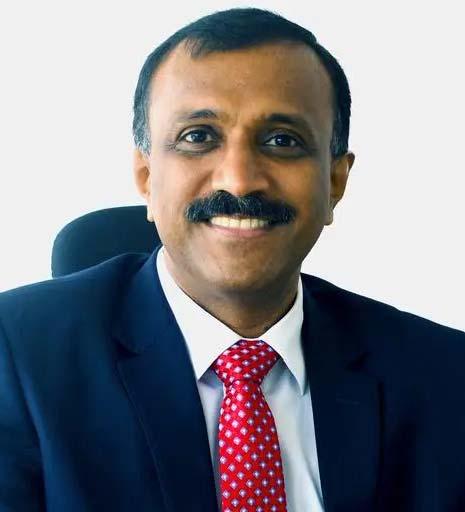
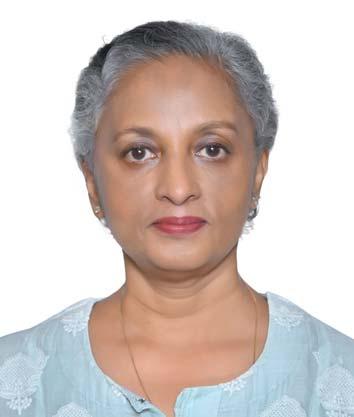
loans, small business loans, and digital credit lines. The company plans to double this to 30% over the next three years, fueled by technological innovation and strategic partnerships.
A recent investment of Rs 15 crore in fintech platform BankBazaar marks one such move. This partnership will enable a fully digital gold loan offering, leveraging BankBazaar’s customer base and onboarding expertise with Muthoot Fincorp’s operational and regulatory support. “India’s gold loan market remains largely informal. Our partnership with BankBazaar brings formal, high-valuation credit to this space, backed by decades of legacy and compliance,” said CEO Shaji Varghese.
This digital-first vision was also exemplified earlier through the launch of Muthoot FinCorp ONE, the company’s digital arm. Under the leadership of CEO Chandan Khaitan, it introduced a QRcode-based micro lending platform targeted at India’s 60 million informal micro enterprises. This product, offering loans up to Rs 5 lakh based on

UPI transactions, is helping integrate small entrepreneurs, especially shopkeepers, into the formal lending ecosystem.
In July 2025, Muthoot Fincorp launched Tranche VI of its Non-Convertible Debenture (NCD) program, with the goal of raising Rs 290 crore within an overall shelf limit of Rs 2,000 crore. The NCDs, rated CRISIL AA-/Stable, offer tenures ranging from 24 to 72 months with attractive yields up to 9.8% per annum. Additionally, the board has cleared raising up to Rs 8,000 crore through various non-bank debt instruments in FY26 to support expanding business operations.
“We aim to maintain a healthy Return on Total Assets (RoTA) of over 3% and a RoE of 22% in FY26,” said Varghese. “Our goal is not just to grow but to grow responsibly, ensuring that we bring more households into the fold of formal finance.” India’s listed space will be watching this performance closely, as these targeted metrics make Muthoot Fincorp an attractive firm for a possible IPO.
Beyond numbers, Muthoot Fincorp continues to build its brand on trust and accessibility. A recent marketing campaign featuring Shah Rukh Khan reinforced its brand positioning as “India’s Original Gold Loan Specialist.” With humorous yet relatable storytelling, the campaign emphasized the ease and transparency of availing loans from Muthoot Fincorp, furthering its appeal among middle and lowerincome groups.
Complementing its consumer outreach was the launch of the Muthoot FinCorp SPARK Awards, an initiative to honor small business owners across India. Winners gain mentorship, exposure, and even a stage presence alongside Shah Rukh Khan. “Through SPARK, we want to recognize grassroots level entrepreneurship, the real driver of India’s economy,” said Varghese. Technology is not just a support function but a strategic pillar at Muthoot Fincorp. With its critical ERP systems now migrated to Oracle Cloud Infrastructure (OCI), the company has reported a 50% improvement in performance and operational efficiency.
Muthoot Fincorp’s blueprint for the future is grounded in financial inclusion, responsible lending, and scalable innovation. Whether it is empowering MSMEs through QR-code-based lending, transforming rural entrepreneurship via microfinance, or offering fast digital gold loans, the company’s offerings are uniquely aligned with India’s socio-economic aspirations.
As CTO Nishit Shrivastava noted, “This move has reduced IT costs, enhanced data security, and positioned us well for next-gen technologies such as AI, machine learning, and advanced analytics.”
Muthoot Pappachan Technologies, the Group’s in-house tech company, headquartered at Trivandrum Technopark, continues to play an enabling role by providing cloud services, app development, ERP implementation, and more to ensure that digital transformation remains robust and relevant. By supporting cloud transitions, app ecosystems, and business intelligence tools, the company ensures that Muthoot Blue companies are future-ready in an increasingly digital financial landscape.
Muthoot Capital Services Ltd, a listed group company specializing in automobile loans, had a solid FY25. The company posted a net profit of Rs 46.31 crore, with total disbursements at Rs 2,642 crore and AUM standing at Rs 3,058 crore. Executive Director Tina Suzanne George, a high-flying chartered accountant who has global experience in firms including Deloitte, attributed this to strong disbursement momentum and improved asset quality.
“We are also progressing on our digital transformation journey to future-proof our platform and enhance customer experiences,” she added. CEO Mathews Markose pointed out a 52% growth in AUM and noted that gross NPAs had dropped to 4.88%, indicating improving financial health. Muthoot
Capital Services works in close cooperation with Muthoot Fincorp, in a mutually synergistic and beneficial operation model for many years now.
In contrast, Muthoot Microfin, another listed subsidiary, faced headwinds due to an asset quality crisis in the microfinance sector. A Rs 401 crore loss in Q4 dragged its full-year results to a net loss of Rs 223 crore. But MPG with its deep expertise in financial services is battling it out by hiking provisions for bad loans and focusing on rural women entrepreneurs, to restore growth and stability.
Another key subsidiary, Muthoot Housing Finance, though unlisted, has remained steady in its mission to offer affordable housing loans to middle and lower-income groups. With a CRISIL rating of A-/Stable, the company’s bouquet of offerings includes purchase, extension, and property-backed loans. Its long-term potential remains promising as homeownership gains momentum across India’s smaller towns.
Muthoot Fincorp’s blueprint for the future is grounded in financial inclusion, responsible lending, and scalable innovation. Whether it is empowering MSMEs through QR-code-based lending, transforming rural entrepreneurship via microfinance, or offering fast digital gold loans, the company’s offerings are uniquely aligned with India’s socio-economic aspirations.
Leadership remains a critical differentiator. With Thomas John Muthoot, Thomas George Muthoot, Thomas Muthoot, and Preethi John bringing in a collective blend of experience, vision, and values, and operational execution being led adeptly by CEO Shaji Varghese, the company is poised for sustainable, tech-enabled growth. In their words and actions, it is clear that Muthoot Fincorp will remain a key leader in making India’s credit landscape more inclusive, accessible, and trustworthy.
As FY26 progresses, Muthoot Fincorp continues to script a powerful narrative, one that harmoniously blends its 138year legacy with a forward-looking vision aimed at financial empowerment for all.
NEUROSCIENCE SAYS THIS IS HOW TO REMEMBER THINGS YOU THINK YOU’VE FORGOTTEN. RESEARCH SHOWS A MEMORY THAT SEEMS TO BE GONE FOREVER MAY JUST BE DORMANT.
No matter how hard you try, you (and definitely I) don’t remember everything you want to remember. That’s true even though there are plenty of sciencebacked ways to improve memory and recall.
One reason we don’t remember is that forgetting things is an active part of learning and memory maintenance. As the authors of a study published in Cell Reports write:

memories that have gone dormant. That happened to me the other day when I wanted to create a reasonably complicated (for me) spreadsheet. For a moment, I didn’t know where to start, so I Googled “pivot tables” and within seconds the whole process came back to me. I couldn’t recall how to create a series of pivot tables, but once I saw the first couple of steps, I recognized the process - and recalled the rest.
While forgetting is commonly considered a deficit of memory function due to its association with pathological states, an alternative emerging perspective considers forgetting as an adaptive function of the brain that may contribute to learning and memory updating. … findings suggest that forgetting is an active process that involves new plasticity that modulates the functionality of specific memory traces in order to promote adaptive behavior.
Or, in non-researcher-speak, your brain does a little strategic forgetting when it updates your memory. That’s not great news when you’ve worked hard to learn something and your brain decides to forget all that so it can learn something new.
Except there’s also this. The study indicates many “forgotten” memories haven’t been permanently erased; instead, they just got “demoted” to a dormant state.
Think of it as the difference between recall and recognition. The Tim
Chalamet movie you want to recommend? You may not recall the title until you Google his name and recognize The King. The song title you can’t recall? You’ll recognize it when you Google the chorus.
Meet me one week, and run into me the next? You might not recall my name, but when I reintroduce myself, you’ll likely recognize it and think, “That’s right: Jeff.”
Recall is always harder than recognition.
But recall can be improved, and so can your ability to revive dormant memories.
The key is brief reexposure to something you recently learned. Say you spent time last week learning the major beats of a new investor pitch. If you haven’t thought about it since then, you may draw a blank when you try to recall the major points. So take a look at the first bullet point; you’ll probably think, “That’s right: The first thing I want to talk about is the problem state.” That will likely lead you to recall the second major topic, and the third.
Sometimes a small dose of reexposure revives a larger chunk of
Another way to improve recall is to spend a few minutes reviewing what you learned yesterday. A study published in Psychological Science found that people who studied before bed, slept, and then did a quick review the next morning not only spent less time studying, they also increased their longterm retention by 50 percent. Sleeping on it helps your brain file away what you learned and makes that information easier to access.
The same is true for repeating learning sessions a few times. Another study published in Psychological Science shows that “distributed practice” is a much more effective way to learn. Each time you attempt to retrieve something from memory, retrieval is more successful and that memory gets easier to retrieve. (Psychologists call it study-phase retrieval.)
The bottom line? To keep learning and adapting, your brain needs to shift some memories to a dormant state. That means learning is rarely a onetime thing: You can’t learn something today and assume you’ll retain it forever.
You’ll need to briefly review. You’ll need to reactivate older memories. You’ll need to plan not just to learn, but to briefly - and maybe periodically - relearn.
And, when you think you’ve forgotten something, to take a second to see if recognition helps spark further recall. Because you’ll be surprised by how often that works.
(Credit: Jeff Haden, Inc.)
SEASONAL MAGAZINE
NOBODY DISAGREES THAT ALL SECTORS OF THE INDIAN EDUCATION SECTOR NEED URGENT UPGRADES. BUT WHERE TO START THIS DAUNTING TASK? A LEADING VOICE IN EDUCATIONAL REFORM, DR. MADHUKAR G ANGUR, HAS LONG ADVOCATED A PIVOT TOWARDS EXCELLENCE IN HIGHER EDUCATION. DR. ANGUR, FOUNDER CHANCELLOR OF ALLIANCE UNIVERSITY IN BENGALURU, COMBINES THE RIGOR OF A PHD FROM THE UNIVERSITY OF TEXAS AT ARLINGTON WITH AN MBA FROM IIM AHMEDABAD AND A B.TECH FROM NIT. AFTER AN ILLUSTRIOUS CAREER AT TOP UNIVERSITIES IN THE UNITED STATES, DR. ANGUR RETURNED TO INDIA, DETERMINED TO INFUSE ITS EDUCATION SYSTEM WITH GLOBAL BEST PRACTICES, INNOVATION, AND A PASSION FOR QUALITY. THROUGH INVESTMENTS IN INSTITUTION BUILDING AND EDTECH STARTUPS, HE HAS CHAMPIONED THE CASE FOR A MODERN, HOLISTIC UNDERGRADUATE EXPERIENCE THAT CAN BRIDGE INDIA’S ASPIRATIONS AND REALITIES.
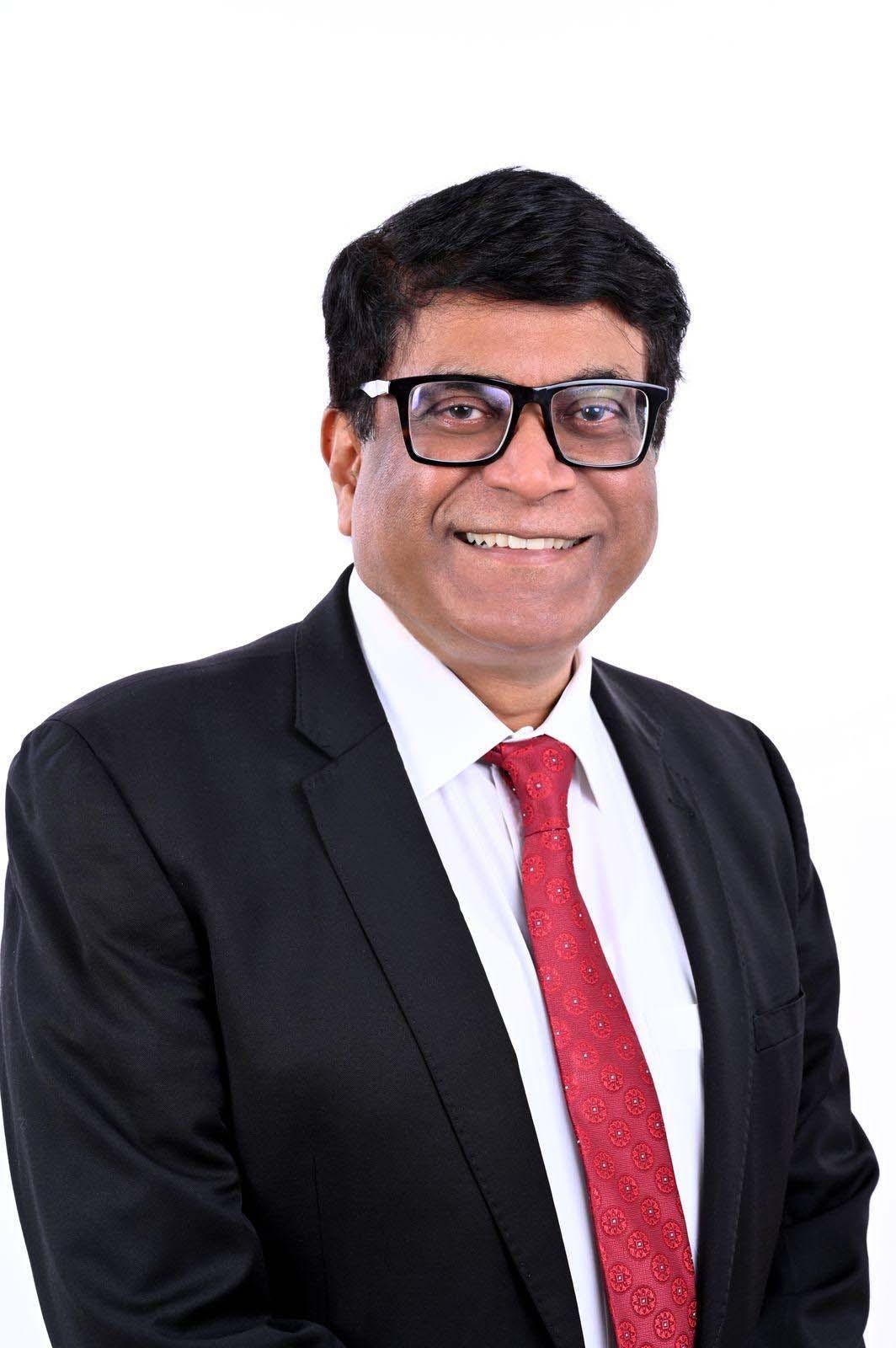
SEASONAL MAGAZINE
India stands at a pivotal moment in its education journey. While landmark reforms and expanded access have brought millions into classrooms, the system’s true test lies ahead: delivering robust, futureready undergraduate education to fuel national progress. Despite impressive growth in institutions and enrollment, persistent gaps in quality, skills alignment, and research orientation continue to hold back India’s vast undergraduate base. The most urgent imperative now is a sweeping, quality-focused upgrade at the undergraduate degree level - the very core that feeds India’s innovation, workforce, and global aspirations.
For India, progress at the school level has been propelled by the Right to Education Act, which sought to democratize access by ensuring that a school was available for every child. However, while the construction of schools mushroomed, what occurs within their walls remains deeply concerning. Teachers are often undertrained, classrooms overcrowded, and outmoded methods of learning prevail. This has led to alarmingly low learning outcomes. Children routinely advance through grades with minimal comprehension or critical thinking, resulting in an education system that appears functional on the surface but is hollow at its core.
Reflecting the diminishing trust in public education, especially among urban and affluent families, there’s been a rapid shift towards elite private and international-curriculum schools. Schools offering IB and IGCSE programs are replacing traditional CBSE and ICSE paths, promising better infrastructure, experiential learning, and global exposure. The burgeoning popularity of these institutions signals eroding
confidence in India’s public education system and deepens the divide between educational haves and have-nots.
This polarization is equally mirrored at the undergraduate level, where opportunities have expanded but excellence remains elusive. Over the last decade, India’s higher education institutions have grown nearly 37%, with especially rapid proliferation among medical colleges and elite institutions like IITs and IIMs. University and college numbers are at record highs and enrollment figures have surged. From 2014-15 to 2024-25, the number of higher education institutions increased from 51,534 to 70,683, and total
enrollment climbed by more than 30% to 4.46 crore. The government targets a Gross Enrollment Ratio (GER) of 50% by 2035, up from the current 28.4%. On the surface, these figures paint a picture of thriving expansion.
But beneath the numbers, a troubling reality persists. Apart from a few elite outliers, the vast majority of undergraduate programs in tier-2 and tier-3 colleges suffer from inadequate infrastructure, a lack of competent faculty, and minimal research orientation. Laboratories are outdated, libraries cannot keep pace, and curricula often bear little resemblance to the rapidly evolving needs of the global workforce. Students with means increasingly turn to well-funded private universities offering contemporary campuses, industry tie-ups, and global exchange programs, thereby


underscoring the glaring inequalities in quality.
The National Education Policy 2020 (NEP 2020) marked a milestone, pledging to overhaul undergraduate education through multidisciplinary programs, flexible curricula, and a focus on analytical thinking. Its implementation, along with curriculum reforms in 2025, signaled India’s intent to shift from rote learning to skills-based, experiential education. The 2025 Union Budget further pledged universal digital connectivity for schools, enhanced capacity at top institutions, and the establishment of a Centre of Excellence on AI in Education. While these measures promise transformation, tangible change for the wider undergraduate landscape remains an ongoing uphill task.
Recent global rankings expose this quality deficit. While India boasts 54 universities in the QS World Rankings 2026, the national average ranking is a modest 452 - an indicator of the excellence bubble at the apex and mediocrity across the rest. Top institutions such as IISc and the leading IITs continue to improve globally, but for the millions in less-
resourced colleges, the promise of a world-class education remains distant.
India’s education crisis is not merely an academic debate; it has real economic consequences. The country’s enormous services sector, exemplified by industry giants like TCS, Infosys, and Wipro, has long relied on a steady influx of skilled graduates. These graduates have powered India’s global IT and BPO dominance. However, the rapid advance of artificial intelligence and automation is rewriting the rules. Routine roles in coding, testing, and support are increasingly performed by machines. To thrive, India must nurture creative, research-driven, and globally competitive undergraduates, capable of leading the next wave of innovation rather than being replaced by it.
This urgency is reflected in student choices as well. Despite the steady growth in domestic higher education, hundreds of thousands of Indian students continue to pursue advanced degrees abroad, gravitating not just to the US, UK, Australia, and Canada, but to new destinations like Germany, France, Japan, and the
UAE. While global exposure and job opportunities are prime motivators, for many, the underlying reason is the lack of truly world-class undergraduate education at home.
What India needs now is a strategic, all-out commitment to undergraduate reform. Investments must flow into uplifting faculty quality and campus infrastructure, especially in tier-2 and tier-3 colleges. Research-driven teaching, robust industry-academia partnerships, and international collaborations should become the norm. Undergraduate curricula require overhauling to emphasize skills, flexibility, and experiential learning for all - not just for the privileged few at top schools.
India’s education journey is remarkable for its expansion, but unfinished in its quest for excellence. The next decade will determine whether the world’s largest youth population becomes a dynamic engine for global innovation, equity, and prosperity, or whether it falls short of its spectacular promise. The answer lies in transforming undergraduate education: from a bottleneck into a launchpad for India’s ambitions.
As AI systems expand their already impressive capacities, there is an increasingly common belief that the field of computer science (CS) will soon be a thing of the past. This is being communicated to today’s prospective students in the form of well-meaning advice, but much of it amounts to little more than hearsay from individuals who, despite their intelligence, speak outside of their expertise.
igh-profile figures like Nobel Prizewinning economist Christopher Pissarides have made this argument, and as a result it has taken root on a much more mundane level – I have even personally heard high school careers advisers dismiss the idea of studying CS outright, despite having no knowledge of the field itself.
These claims typically share two common flaws. First among them is that the advice comes from people who are not computer scientists. Secondly, there is a widespread misunderstanding of what computer science actually involves.
It is not wrong to say that AI can write computer code from prompts, just as it can generate poems, recipes and cover letters. It can boost productivity and speed up workflow, but none of this eliminates the value of human input.
Writing code is not synonymous with CS. One can learn to write code without ever attending a single university class, but a CS degree goes far beyond this one skill. It involves, among many other things, engineering complex systems, designing infrastructure and future programming languages, ensuring cybersecurity and verifying systems for correctness.
AI cannot reliably do these tasks, nor will it be able to in the foreseeable future. Human input remains essential, but pessimistic misinformation risks steering tens of thousands of talented students away from important, meaningful careers in this vital field.
AI excels at making predictions. Generative AI enhances this by adding a user-friendly presentation layer to understanding of markets, not just reams of code.
2) Diagnosing intermittent cloud service outages from providers like Google or Microsoft. AI can troubleshoot on a small scale, but it cannot contextualise large-scale, high-stakes troubleshooting.
3) Rewriting code for quantum computers. AI cannot do this without extensive examples of successful implementations (which do not currently exist).
4) Designing and securing a new cloud operating system. This involves highlevel system architecture and rigorous testing that AI cannot perform.
5) Creating energy-efficient AI systems. AI cannot spontaneously invent lower power GPU code, or reinvent its own architecture.
6) Building secure, hacker-proof, realtime control software for nuclear power plants. This requires embedded systems expertise to be mixed with the translation of code and system design.
7) Verifying that a surgical robot’s software works under unpredictable conditions. Safety-critical validation exceeds AI’s current scope.
8) Designing systems to authenticate email sources and ensure integrity. This is a cryptographic and multi-disciplinary challenge.
9) Auditing and improving AI-driven cancer prediction tools. This requires human oversight and continuous system validation.
10) Building the next generation of safe and controllable AI. Evolving towards safer AI cannot be done by AI itself –this is a human responsibility.
One thing is certain: AI will reshape how engineering and Computer Science is done. But what we are faced with is a shift in working methods, not a
wholesale destruction of the field.
Whenever we face an entirely new problem or complexity, AI alone will not suffice for one simple reason: it depends entirely on past data. Maintaining AI, building new platforms, and developing fields like trustworthy AI and AI governance therefore all require CS.
The only scenario in which we might not need CS is if we reach a point where we no longer expect any new languages, systems, tools, or future challenges. This is vanishingly unlikely. Some argue that AI may eventually perform all of these tasks. It’s not impossible, but even if AI became this advanced, it would place almost all professions at equal risk. One of the few exceptions would be those who build, control, and advance AI.
There is a historical precedent to this: during the industrial revolution, factory workers were displaced at a 50 to 1 ratio as a result of rapid advances in machinery and technology. In that case, the workforce actually grew with a new economy, but most of the new workers were those who could operate or fix machines, develop new machines, or design new factories and processes around machinery.
During this period of massive upheaval, technical skills were actually the most in-demand, not the least. Today, the parallel holds true: technical expertise, especially in CS, is more valuable than it ever has been.
Let’s not confuse the next generation with the opposite message.
(Credit: By Ikhlaq Sidhu, Decano de IE School of Science and Technology, IE University)


